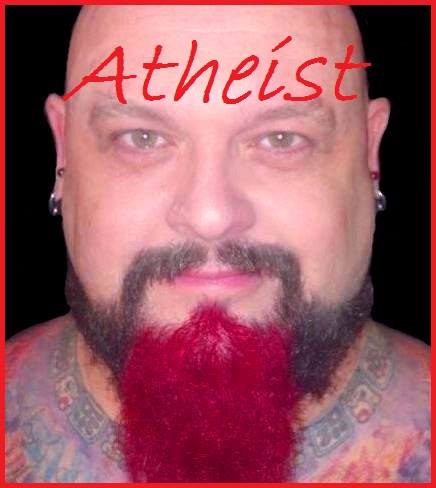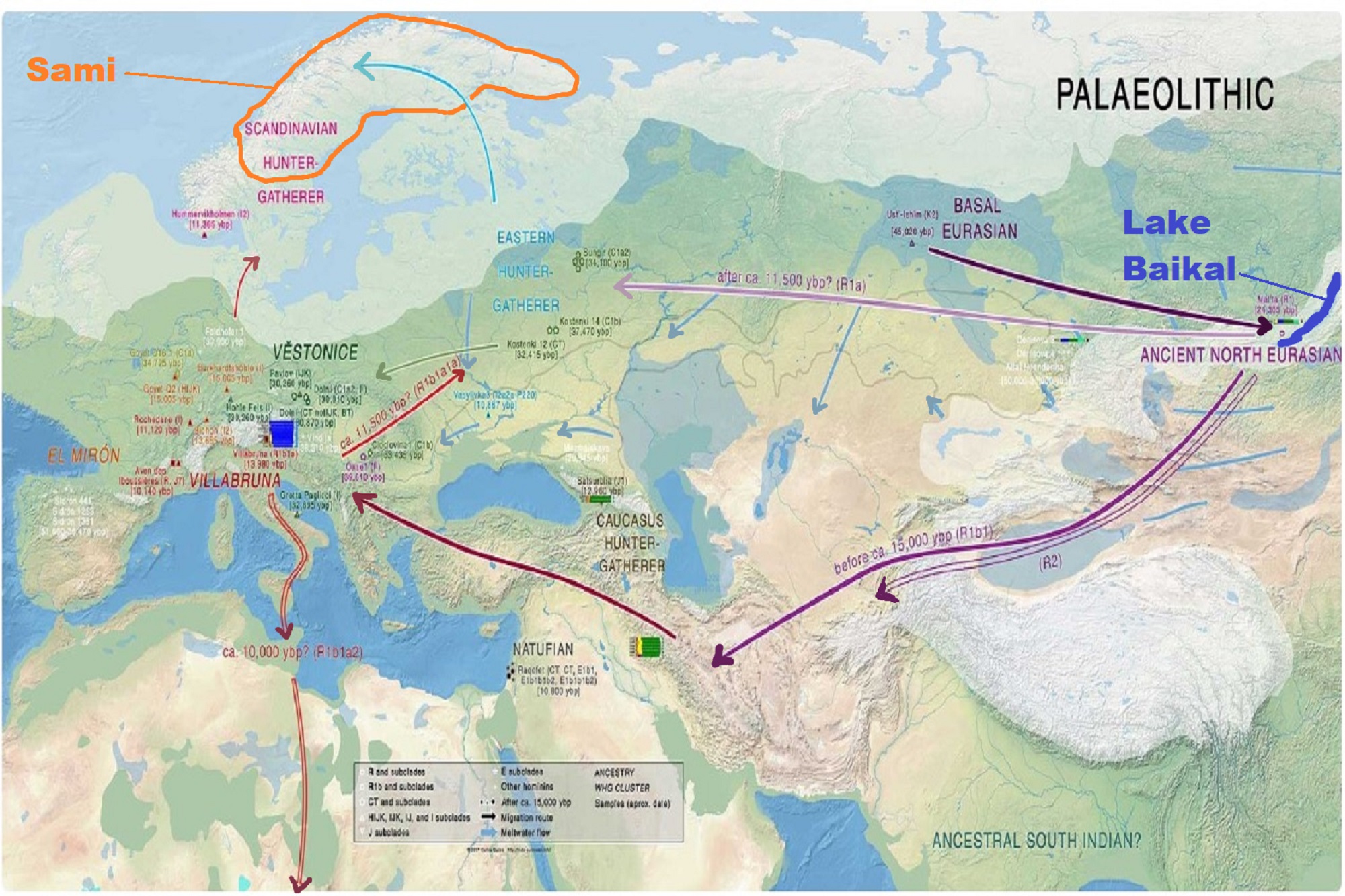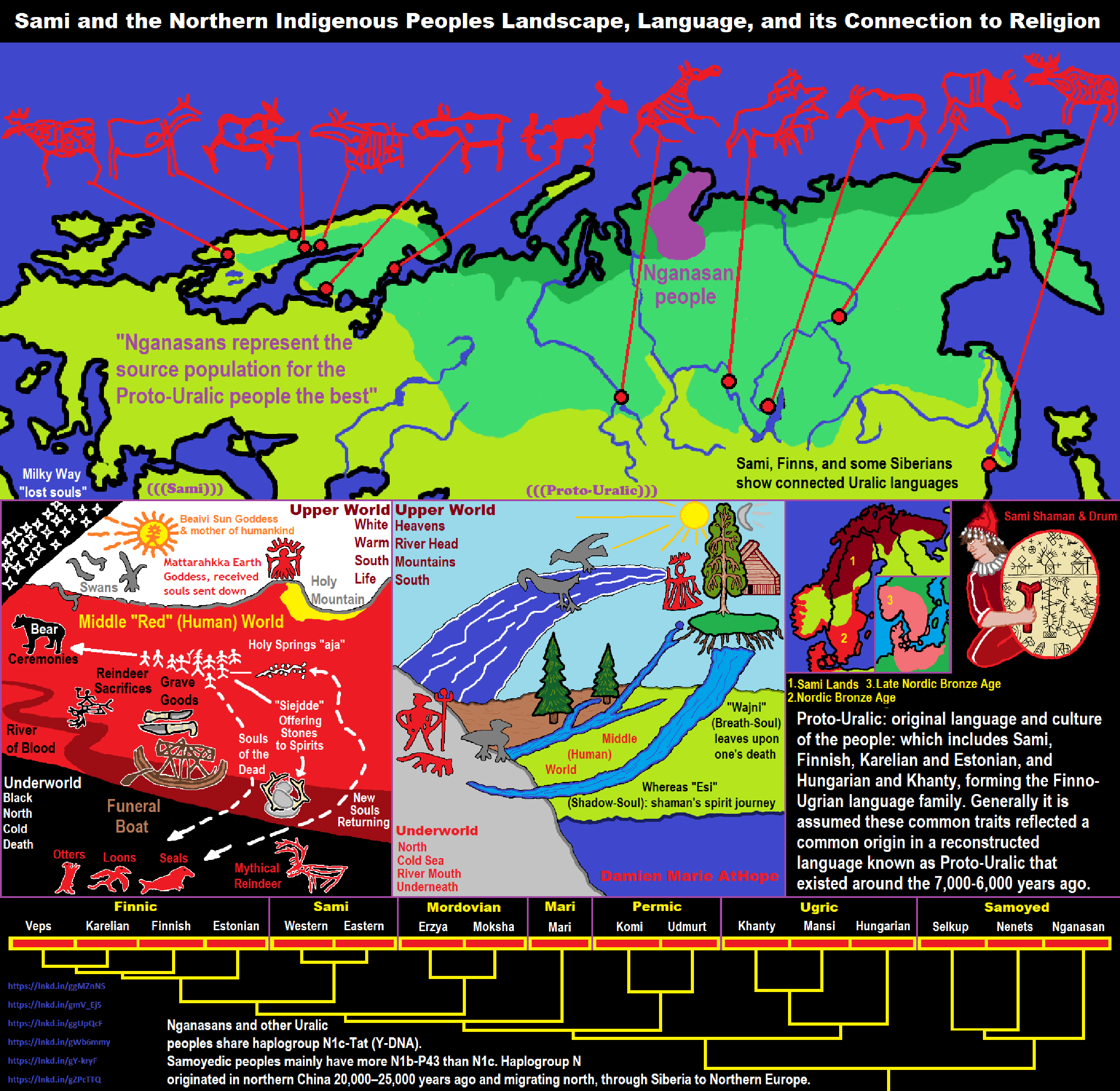
Sámi shamanism
“Traditional Sámi spiritual practices and beliefs are based on a type of animism, polytheism, and what anthropologists may consider shamanism. The religious traditions can vary considerably from region to region within Sápmi. Traditional Sámi religion is generally considered to be Animism. The Sámi belief that all significant natural objects (such as animals, plants, rocks, etc.) possess a soul, and from a polytheistic perspective, traditional Sámi beliefs include a multitude of spirits. Sámi traditional beliefs and practices commonly emphasizes veneration of the dead and of animal spirits. The relationship with the local animals that sustain the people, such as the reindeer, are very important to the kin-group.” ref
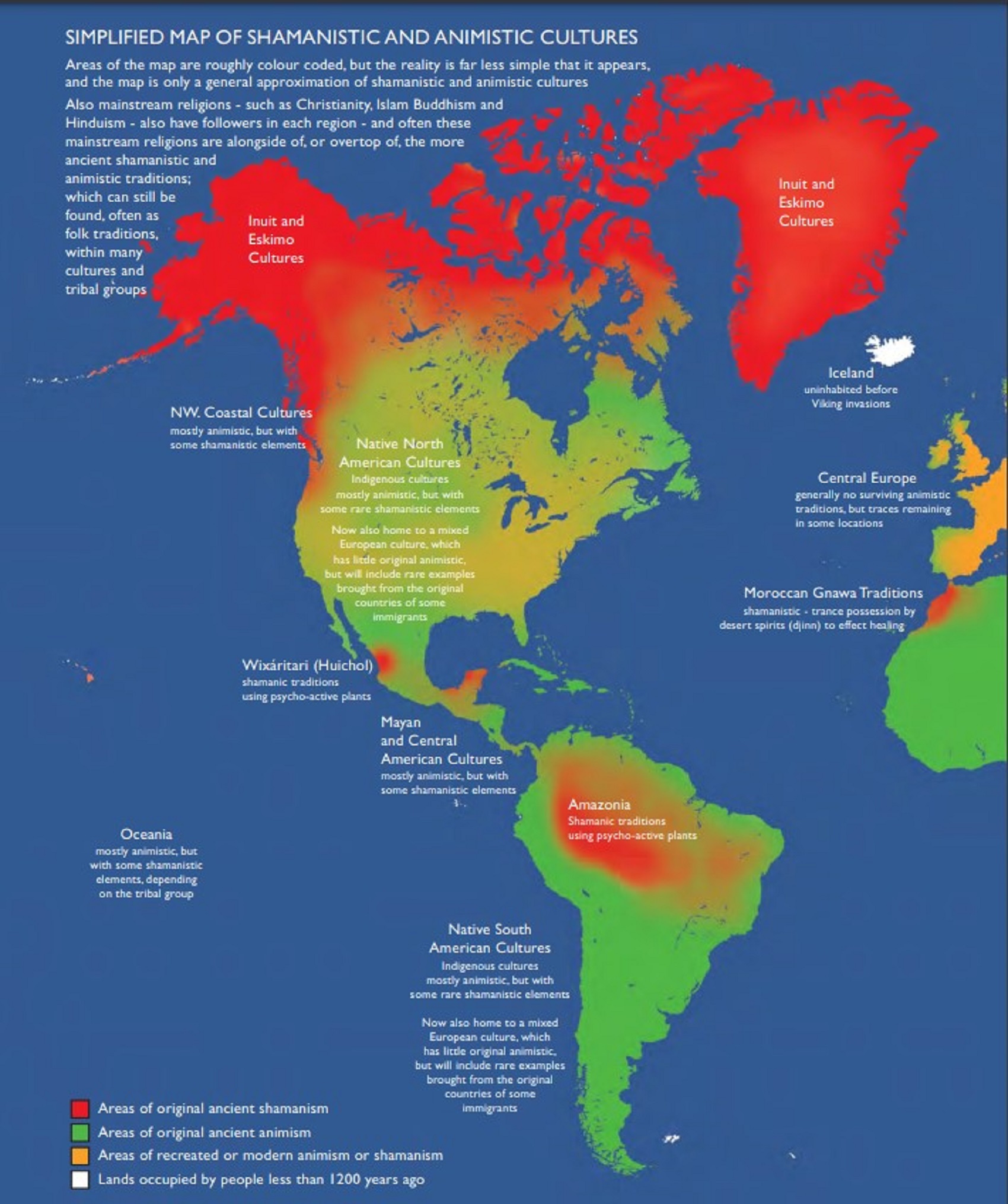
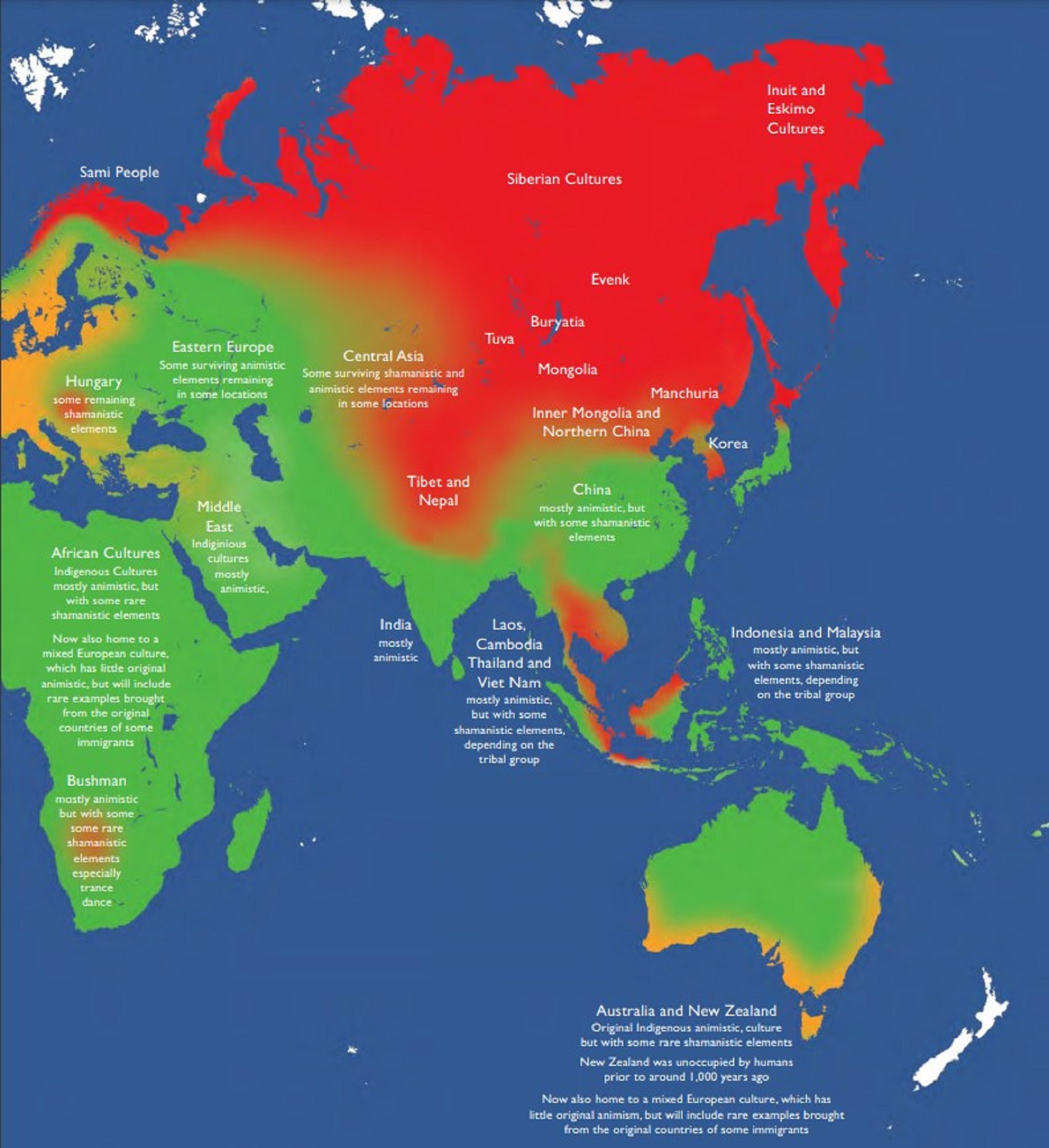
Shamanistic and Animistic Cultures map by “The Shamanism Magazine” (http://SacredHoop.org)
https://sacredhoop.org/Free-Guide-To-Shamanism/Sacred-Hoop-Free-Guide-To-Shamanism.pdf
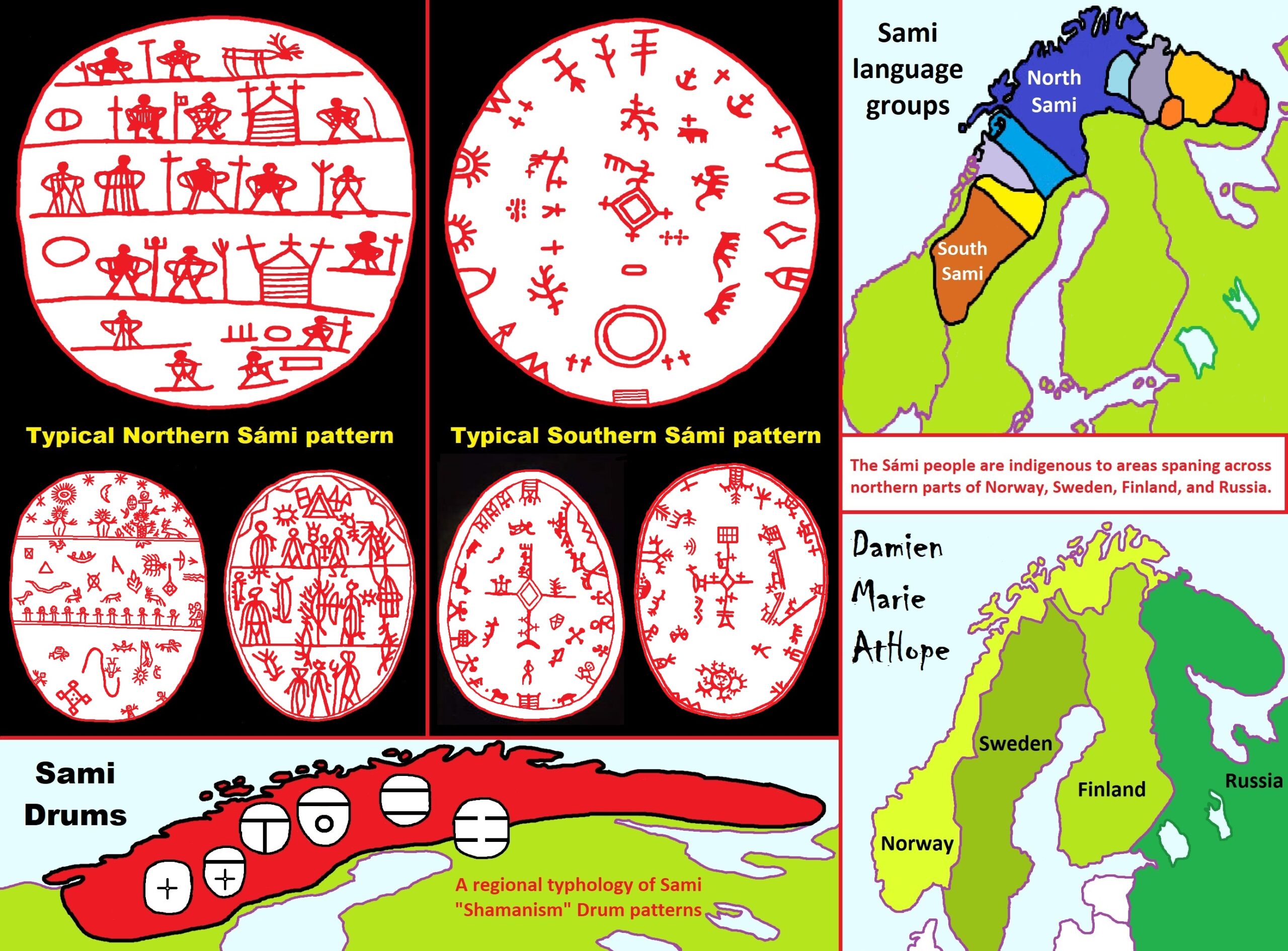
“The drum of Anders Paulsen (top left) and the Bindal drum (top right) represent variations in Sami drums, their shape, decoration and history. Paulsen’s drum was confiscated in Vadsø in 1691, while the Bindal drum was bought by a museum official in 1925; Vadsø and Bindal being in opposite corners of the Sami world. Paulsens’s drum has a typical Northern Sámi pattern, with several separate levels representing the different layers of spiritual worlds. The Bindal drum has a typical Southern Sami decoration: a rhombus-shaped sun symbol in the center, with other symbols around the sun, representing people, animals, landscape and deities.” ref
Sami Shamanism: Religio-Sociocultural Identity, Phenomenon, and System
Sámi drum
“A Sámi drum is a shamanic ceremonial drum used by the Sámi people of Northern Europe. Sámi ceremonial drums have two main variations, both oval-shaped: a bowl drum in which the drumhead is strapped over a burl, and a frame drum in which the drumhead stretches over a thin ring of bentwood. The drumhead is fashioned from reindeer hide. In Sámi shamanism, the noaidi used the drum to get into a trance, or to obtain information from the future, or other realms. The drum was held in one hand, and beaten with the other. While the noaidi was in trance, his “free spirit” was said to leave his body to visit the spirit-world. When used for divination, the drum was beaten with a drum hammer; a vuorbi (‘index’ or ‘pointer’), a kind of die made of brass or horn, would move around on the drumhead when the drum was struck. Future events would be predicted according to the symbols upon which the vuorbi stopped on the membrane.” ref
“The patterns on the drum membrane reflect the worldview of the owner and his family, both in religious and worldly matters, such as reindeer herding, hunting, householding, and relations with their neighbors and the non-Sámi community. Many drums were taken out of Sámi ownership and use during the Christianization of the Sámi people in the 17th and 18th centuries. Many drums were confiscated by Sámi missionaries and other officials as a part of an intensified Christian mission towards the Sámi. Other drums were bought by collectors. Between 70 and 80 drums are preserved; the largest collection of drums is at the Nordic Museum in Stockholm.” ref
“The Northern Sámi terms for the drum are goavddis, gobdis and meavrresgárri, while the Lule Sámi and Southern Sámi terms are goabdes and gievrie, respectively. Norwegian: runebomme, Swedish: nåjdtrumma; In English it is also known as a rune drum or Sámi shamanic drum. The Northern Sámi name goavddis describes a bowl drum, while the Southern Sámi name gievrie describes a frame drum, corresponding to the distribution of these types of drums. Another Northern Sámi name, meavrresgárri, is a cross-language compound word: Sámi meavrres, from meavrit and Finnish möyriä (‘dig, roar, mess’), plus gárri from Norwegian kar (‘cup, bowl’).” ref
“The common Norwegian name for the drum, runebomme, is based on an earlier misunderstanding of the symbols on the drum, which interpreted them as runes. Suggested new names in Norwegian are sjamantromme (“shaman drum”) or sametromme (‘Sámi drum’). The original Swedish name, trolltrumma, comes from the Christian perception of Sámi religion as witchcraft (trolldom), and it is now considered derogatory. In his Fragments of Lappish Mythology (ca 1840) Læstadius used the term divination drum (“spåtrumma”). In Swedish today, the term that’s commonly used is samiska trumman (‘the Sámi drum’).” ref
“There are four categories of sources for the history of the drums. First are the drums themselves, and what might be interpreted from them. Secondly, there are reports and treatises on Sámi subjects from the 17th and 18th centuries, written by Swedish and Dano-Norwegian priests, missionaries, or other civil servants, like Johannes Schefferus. The third category are statements from Saami themselves, given to legal courts or other official representatives. The fourth are the sporadic references to drums and Sámi shamanism in other sources, such as Historia Norvegiæ (late 12th century).” ref
“The oldest mention of a Sámi drum and shamanism is in the anonymous Historia Norvegiæ (late 12th century). It mentions a drum with symbols of marine animals, a boat, reindeer and snowshoes. There is also a description of a shaman healing an apparently dead woman by moving his spirit into a whale. Peder Claussøn Friis describes a noaidi’sspirit leaving the body in his Norriges oc omliggende Øers sandfærdige Bescriffuelse (1632). The oldest description by a Sámi is by Anders Huitlok of the Pite Sámi in 1642 about a drum that he owned. Huitlok also made a drawing; his story was written down by the German-Swedish bergmeister Hans P. Lybecker. Huitlok’s drum represents a worldview where deities, animals and the living and the dead are working together within a given landscape. The court protocols from the trials against Anders Paulsen in Vadsø in 1692 and against Lars Nilsson in Arjeplog in 1691 are also sources.” ref
“During the 17th century, the Swedish government commissioned a work to gain more knowledge of the Sámi and their culture. During the Thirty Years’ War (1618–48) rumours were spread that the Swedes won their battles with the help of Sámi witchcraft. Such rumours were part of the background for the research that lead to Johannes Schefferus‘ book Lapponia, published in Latin in 1673. For Schefferus, a number of “priests’ correspondences” (prästrelationer) were written by vicars within the Sámi districts of Sweden. Treatises by Samuel Rheen, Olaus Graan, Johannes Tornæus and Nicolai Lundius were the sources used by Schefferus.” ref
“In Norway, the main source are writings from the mission of Thomas von Westen and his colleagues from 1715 until 1735. Authors were Hans Skanke, Jens Kildal, Isaac Olsen, and Johan Randulf (the Nærøy manuscript). These books were, in part, instructions for the missionaries and their co-workers, and part documentation, intended for the government in Copenhagen. Late books within this tradition are Pehr Högström‘s Beskrifning Öfwer de til Sweriges Krona lydande Lapmarker (1747) in Sweden and Knud Leem‘s Beskrivelse over Finmarkens Lapper (1767) in Denmark-Norway. Notable is especially Læstadius‘ Fragments of Lappish Mythology (1839–45), which both discusses earlier treatises with a critical approach, and builds upon Læstadius’ own experience.” ref
“The drums are always oval; the exact shape of the oval would vary with the kind of wood used. Drums which still exist are of four different types, and can be divided into two main groups: bowl drums and frame drums:
- In bowl drums, the wood consists of a burl shaped into a bowl. The burl usually comes from pine, but sometimes from spruce. The membrane is attached to the wood with a sinew.
- Frame drums are shaped by wet or heat bending; the wood is usually pine, and the membrane is sewn to holes in the frame with sinew.
- Ring drums are made from a naturally grown piece of pine wood. There is only one known drum of this type.
- Angular-cut frame drums are made from one piece of wood cut from a tree. To bend the wood into an oval, angular cuts are made in the bottom and the side of the frame. Only two such drums are preserved, both from Kemi Sámi districts in Finland. The partly preserved drum from Bjørsvik in Nordland is also an angular-cut frame drum.” ref
“In his major work on Sámi drums, Die lappische Zaubertrommel, Ernst Manker lists 41 frame drums, one ring drum, two angular-cut frame drums and 27 bowl drums. Given these numbers, many tend to divide the drums into two main groups: bowl drums and frame drums, seeing the others as variations. Judged by these remaining drums and their known provenance, frame drums seem to be more common in the Southern Sámi areas, and bowl drums seem to be common in the Northern Sámi areas. The bowl drum is sometimes regarded as a local adjustment of the basic drum type, this being the frame drum. The frame drum type is more reminiscent of other ceremonial drums used by the indigenous peoples of Siberia.” ref
“The membrane is made of untanned reindeer hide. Lars Olsen, who described his uncle’s drum, the Bindal drum, in 1885, said that the hide was usually taken from the neck of a reindeer calf because of its thickness. The symbols were painted with a paste made from alder bark. The motifs on a drum reflect the worldview of the owner and his family, both in terms of religious beliefs and in their modes of subsistence. A world is depicted via images of reindeer, both domesticated and wild, and of carnivorous predators that pose a threat to the herd. The modes of subsistence are presented by scenes of wild game hunting, boats with fishing nets, and reindeer herding.” ref
“Additional imagery on the drum consists of mountains, lakes, people, deities, as well as the camp-site with tents and storage-houses. Symbols of foreign civilizations, such as churches and houses, represent the threats from the surrounding and expanding non-Sámi community. Each owner chose his set of symbols; there are no two drums with identical sets of symbols. The drum mentioned in the medieval Latin tome Historia Norvegiæ, with motifs such as whales, reindeer, skis and a boat would have belonged to a coastal Sámi. The Lule Sámi drum reflects an owner who found his mode of subsistence chiefly through hunting, rather than herding.” ref
“A typology based on the structure of the patterns can be divided into three main categories:
- Southern Sámi, characterized by the rhombus-shaped sun cross in the center
- Central Sámi, where the membrane is divided in two by a horizontal line, often with a solar symbol in the lower section
- Northern Sámi, where the membrane is divided by horizontal lines into three or five separate levels representing different worlds: the heavens, the world of the living and an underworld.” ref
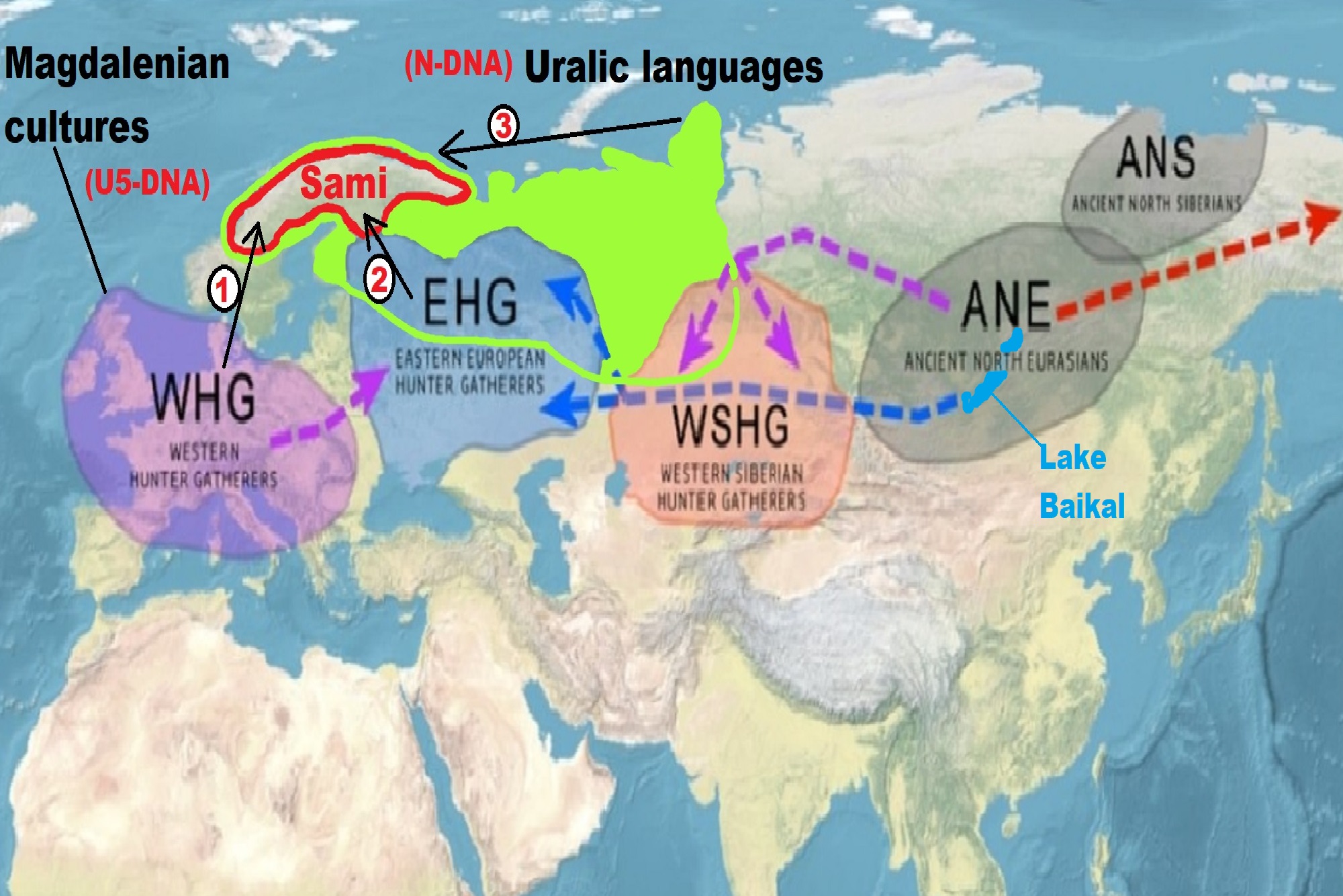
I tried to put all the DNA migrations, that together help explain Sami DNA, and thus some of their cultural influences.
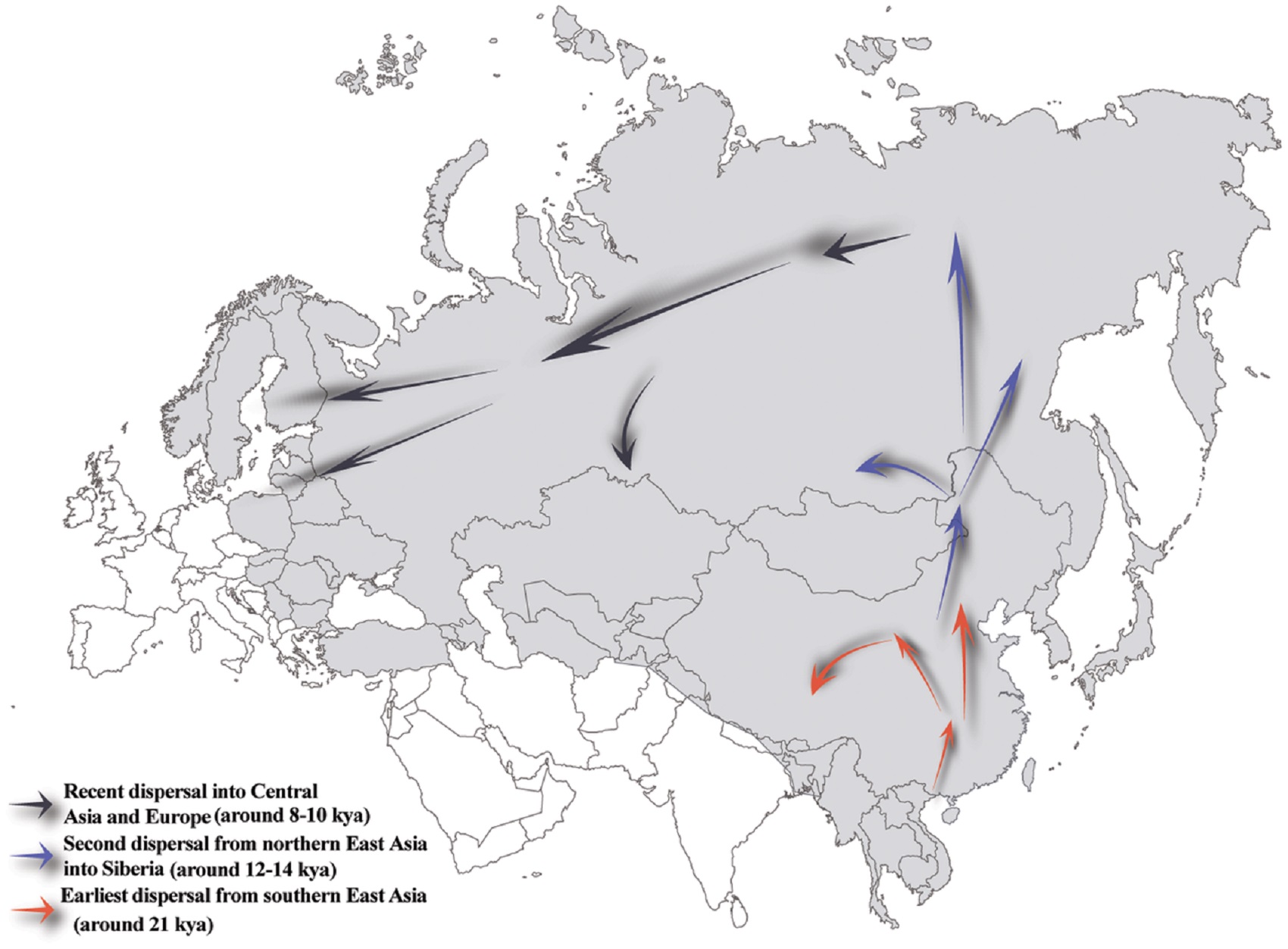
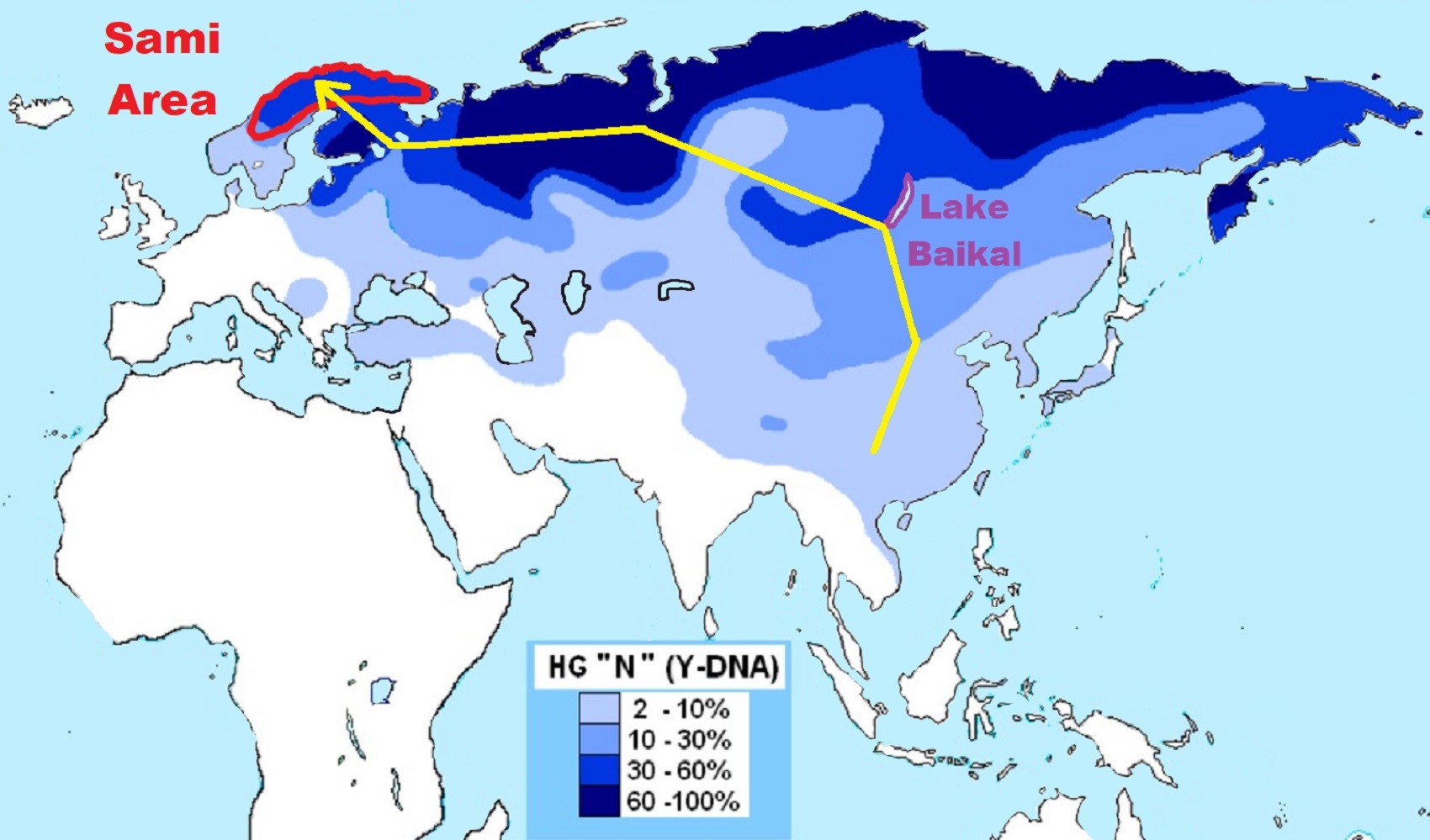
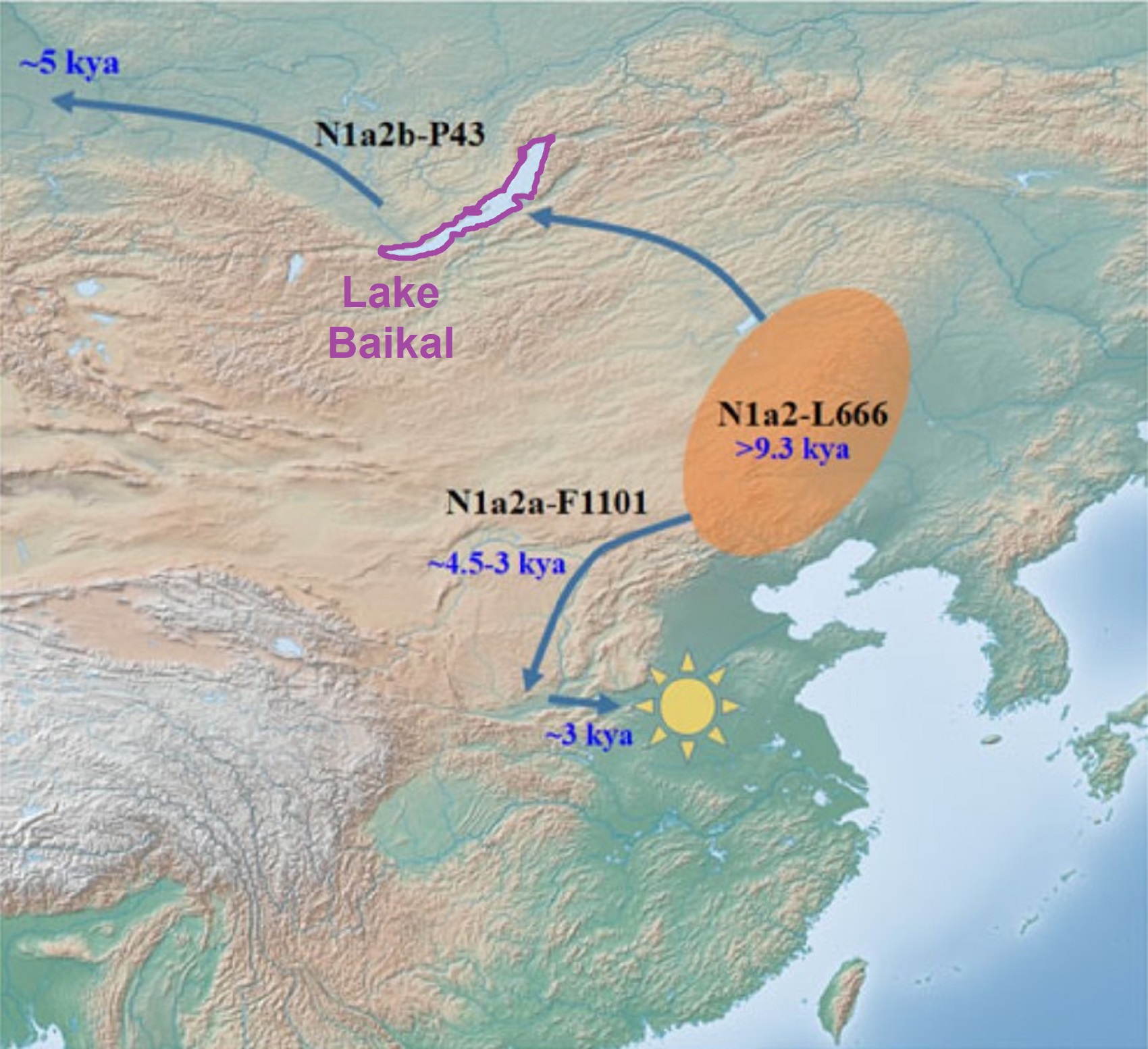
Early history between 9,300 and 4,400 years ago
“As the only two downstream clades of N1a2-L666, the geographical distribution of N1a2a-F1101 and N1a2b-P43 is very different from each other. Ancient DNA studies have identified early branches of N1a2a-F1101 and N1a2b-P43 in sites in the Baikal region (de Barros Damgaard et al., 2018; Kilinc et al., 2021; Ma et al., 2021). The most recent branch of N1a2-L666 is N1a1-M46, the main paternal type of the Uralic population (Ilumäe et al., 2016). The first two early branches under N1a1-M46, N1a1b-Y149447, and N1a1a3-F4065, are mainly distributed in northeast China (https://www.yfull.com/tree/N/) (Hu et al., 2015). Therefore, we speculate that the initial spread of haplogroup N1a2-L666 may have been in the southwestern part of northeastern China (Figure 3).” ref
“The researchers proposed that this region is also the initial diffusion center of N1a1-M46, while the diffusion of N1a1-M46 (>12,000 years ago) happened earlier than that of N1a2-L666 (<9,300 years ago) (Hu et al., 2015). In the early Holocene (about 11,200-8,000 years ago), with climate change and the rise of early agricultural populations in northern China, a part of the descendants of the ancestor group, representing by sub-lineage N1a2b-P43, spread to the high latitude region of Siberia, eventually becoming part of the Ural-speaking populations. The other part, representing by sub-lineage N1a2a-F1101, remained in the local area and participated in the formation of the northern Chinese populations in the later historical period (Figure 3).” ref
“A bottleneck period of 5,000 years was observed early in the evolution of N1a2a-F1101 (Figure 1, Supplementary Table S1). Similar lengthy bottleneck periods were observed in downstream structures of N1a2b-P43, N1a1-M46, and Q1a1a-M120 (Ilumäe et al., 2016; Sun et al., 2019). This evolutionary pattern is very different from the expansion pattern of ancient agricultural populations in East Asia, which continued to expand since the beginning of Neolithic age (Yan et al., 2014). The differentiation of the downstream clades of Q-M242 and N-231 presents a similar structure, i.e., downstream clades with high-frequency distribution both in East Asia and Siberia, respectively. Therefore, we speculate that in the bottleneck interval, ancient populations with Q1a1a-M120 and N1a2a-F1101 as the main paternal lineages are likely to exist in the form of prehistoric hunter-gatherer populations in the border between the eastern Eurasian steppe and the northern-northeastern China. The drought and harsh natural environment of this area had a great influence on the evolution of the two paternal lineages in later historical periods.” ref
Expansion during the chalcolithic age and bronze age
“During the Chalcolithic age (about 4.5 kya-4.0 kya) in East Asia, copper, cattle, and wheat were introduced to the East Asian heartland (Liu and Chen, 2003; Liu, 2004; Liu and Chen, 2017). Archaeologists have suggested that the elements may have spread from the northern boundary of China through the Eurasian steppe. However, the demographic context of this important cultural process is very ambiguous. Around 4,000 years ago, the Bronze culture arose in the agro-pastoral region of northwestern China and later spread across East Asia and Southeast Asia. The mixing of the bronze culture of agriculture and animal husbandry with the people of the middle and lower reaches of the Yellow River contributed to the establishment of three dynasties of the Bronze Age in ancient China, namely the Xia, Shang, and Zhou dynasties (Liu and Chen, 2003; Liu, 2004; Liu and Chen, 2017).” ref
“As discussed above, ancient populations with Q1a1a-M120 and N1a2a-F1101 as the main paternal lineages may have played a mediating role in the spread of the Copper and Bronze cultures from the eastern Eurasian steppe to the central East Asian region, due to their area of activity in the junction zone. Due to the same reason, these two paternal lines experienced a very significant spread during the Bronze Age, becoming important patrilineal lineages that occupied an upper political position in the Bronze Age, and were frequently detected in the tombs of chiefs and nobles of the time (Zhao et al., 2014; Sun et al., 2019; Ma et al., 2021; Wei et al., 2022). An interesting thing is that the significant expansion of N1a2a-F1101 occurred after 3,300 years ago, significantly later than the major expansion period of Q1a1a-M120 (4.2 kya-3 kya, Figure 1).” ref
“Nevertheless, several downstream clades of Q1a1a-M120, like F4759 and F4689, exhibit simultaneous expansion with N1a2a1a1a1a1-F710 (Sun et al., 2019). Ancient DNA data suggest that these two paternal lineages were concentrated in ancient populations in northwest China, and co-occurred in some tombs (Zhao et al., 2014; Ma et al., 2021; Wei et al., 2022). These ancient DNA studies also suggest that N1a2a-F1101 is likely the paternal lineage of the royal family of the Zhou Dynasty, while Q1a1a-M120 is the main paternal lineage of the Rong-Di populations (Means “Barbarians” in ancient Chinese). Both paternal lineages became the main paternal component of the Chinese group in later generations. In conclusion, we speculate that Q1a1a-M120 and N1a2a-F1101 together constitute the main paternal lineages of the populations that worked as farmers and pastoralists in northwest China during the Copper-Bronze Age. They played a key role in the emergence of bronze culture, early states, and early civilizations in the central region of ancient China.” ref
Bronze age globalization in East Asia
“As, discussed in the Introduction section, Bronze Age globalization has led to the mass replacement and mixing of populations in multiple parts of Eurasia (Allentoft et al., 2015). In East Asia, however, the situation is quite different. Ancient DNA shows that during the Copper-Bronze Age, the populations in the central East Asian region did not experience large-scale replacement, and the genetic components from Indo-Europeans are nearly absent. Based on previous literature and the results of this paper, we suggest that the Gobi Desert on the border between China and Mongolia may have hindered the spread of the Bronze culture and Indo-European-related populations. The hunter-gatherer communities that originally operated in the north and south of the Gobi Desert relied on their familiarity with the environment and long-distance material exchange networks to spread relevant cultural elements as intermediaries. In later historical periods, they became the main founders of the bronze culture populations in northwest China.” ref
“These demographic histories led to the spread of Bronze culture into central East Asia as a form of cultural diffusion, unlike what happened in other parts of Eurasia during the Bronze Age period of globalization. In summary, we constructed a high-resolution phylogeny for Y-chromosome haplogroup N1a2a-F1101, one of the main paternal lineages of modern Chinese. We explored the demographic of this paternal haplogroup in the past 9,000 years. We also discussed the activity of ancient populations with this lineage and their role during the appearance of Bronze Age culture, the formation of early state and early civilizations in the central region of China. The newly-discovered sub-branches and variants will assist in exploring the formation process of gene pool of Chinese populations and their cultural traditions.” ref
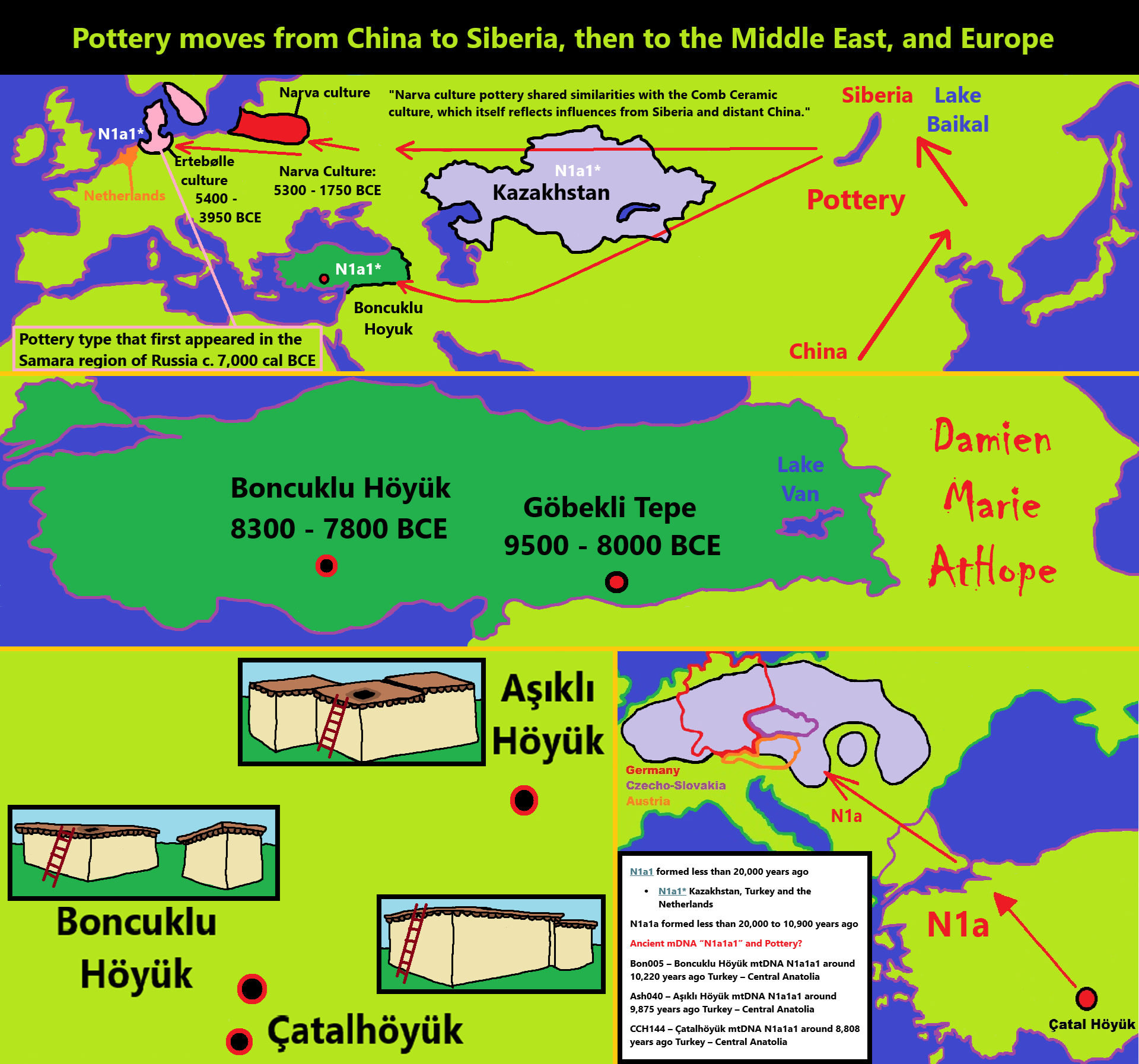
Pottery from at 10,000 at Boncuklu Höyük, to Aşıklı Höyük, to Çatalhöyük, then Europe by around 7,500 years ago.
Ceramic Mesolithic
“In North-Eastern Europe, Siberia, and certain southern European and North African sites, a “ceramic Mesolithic” can be distinguished between c. 9,000 to 5,850 years ago. Russian archaeologists prefer to describe such pottery-making cultures as Neolithic, even though farming is absent. This pottery-making Mesolithic culture can be found peripheral to the sedentary Neolithic cultures. It created a distinctive type of pottery, with point or knob base and flared rims, manufactured by methods not used by the Neolithic farmers. Though each area of Mesolithic ceramic developed an individual style, common features suggest a single point of origin. The earliest manifestation of this type of pottery may be in the region around Lake Baikal in Siberia.” ref
“It appears in the Yelshanka culture on the Volga in Russia 9,000 years ago, and from there spread via the Dnieper-Donets culture to the Narva culture of the Eastern Baltic. Spreading westward along the coastline it is found in the Ertebølle culture of Denmark and Ellerbek of Northern Germany, and the related Swifterbant culture of the Low Countries. A 2012 publication in the Science journal, announced that the earliest pottery yet known anywhere in the world was found in Xianrendong cave in China, dating by radiocarbon to between 20,000 and 19,000 years before present, at the end of the Last Glacial Period. The carbon 14 datation was established by carefully dating surrounding sediments. Many of the pottery fragments had scorch marks, suggesting that the pottery was used for cooking. These early pottery containers were made well before the invention of agriculture (dated to 10,000 to 8,000 BCE), by mobile foragers who hunted and gathered their food during the Late Glacial Maximum.” ref
“The Subneolithic is an archaeological period sometimes used to distinguish cultures that are transitional between the Mesolithic and the Neolithic. Subneolithic societies typically adopted some secondary elements of the Neolithic package (such as pottery), but retained economies based on hunting, gathering, and fishing instead of agriculture. For the most part they were sedentary. The Subneolithic dates to the period 5000/4000–3200/2700 BCE in Scandinavia, north and north-eastern Europe.” ref
“Subneolithic groups retained Mesolithic subsistence strategies, including hunting, gathering, and fishing. This distinguished them from their Neolithic neighbors, who adopted agriculture. Keeping domesticated animals was not a defining practice of the Subneolithic, as it was for the Neolithic, but there has been evidence which suggests that some cultures incorporated this custom. Findings of domesticated animal bones and even grain at Subneolithic sites suggest interactions between Neolithic and Subneolithic cultures.” ref
“The Subneolithic is observed across Scandinavia, north, and north-eastern Europe in the period 5000/4000–3200/2700 BCE, including at sites in Lithuania, Finland, Poland, and Russia. Notable Subneolithic sites include:
- Väikallio, Astuvansalmi and Saraakallio (Finland, 5100–3300 BCE) – notable for rock art.
- Szczepanki (Poland, 4500–2000 BCE) – associated with the Zedmar culture and notable for finds of wood, fishing structures and pottery.” ref
“Pottery, as a defining feature of the Subneolithic, distinguishes these cultures from the Mesolithic through the adoption of this Neolithic element and accounts for the alternate terms of Ceramic Mesolithic, Pottery-Mesolithic, Late Mesolithic, Para-Neolithic, and Forest Neolithic in reference to these groups. Given the diversity of the Subneolithic cultural landscape, pottery present across the Subneolithic occurs in a variety of styles that evolved over the cultural period geographically. For example, in Eastern Europe, Subneolithic pottery appears fairly uniform, with limited complexity and diversity.” ref
“Common features of pots include:
- Appeared to be built in layers of rings, the pots occasionally have pointed bases (such as within the Narva culture) but are more commonly rounded and wider than the vessel’s mouth. Some Subneolithic groups also produced flat-based vessels, such as the Zedmar culture.
- Walls are smooth but may observe a break in their fluidity in the form of a shoulder that gives way to a short, concave neck.
- Rims may be thickened, bevelled, or moulded, but the pots themselves are notably absent of any handles or lugs.
- Ornamentally, the pottery is usually decorated from the top with horizontal rows of parallel pits followed by parallel rows throughout the vase’s body.
- Other common decorative elements include fingernail impressions, simple points and short strokes grouped horizontally which appear on both the body and the rim.
- Impressions by whipped-chord and twisted thread, known as maggot-pattern, occur in horizontal rows or else in a herring-bone arrangement. Later styles integrated the use of short-toothed comb-like depressions.
- A shell temper was characteristic of Subneolithic pottery, and in the Ancient Lake Saimaa area, asbestos tempers were used for their capacity to strengthen vessels and cooking utensils.” ref
“In practice, pottery vessels have been utilised in the processing of aquatic products, as well as the processing of other materials such as beeswax – although this may be indicative of the storage of other matter (i.e. honey), or for its use as a sealant in the creation process.” ref
“The Kunda culture was succeeded by the Narva culture, who used pottery and showed some traces of food production. Jones et al. (2017) determined, based on one sample (6467-6250 BCE) from the Kunda culture and another one from the succeeding Narva culture, closer genetic affinity with Western Hunter-Gatherers (WHGs) than Eastern Hunter-Gatherers (EHGs). Mittnik et al. (2018) analyzed the remains of a male and female ascribed to the Kunda culture. They found the male to be carrying paternal haplogroup I and maternal haplogroup U5b2c1, while the female carried U4a2. They were found to have “a very close affinity” with WHGs, although with “a significant contribution” from Ancient North Eurasians (ANE). Their ANE ancestry was lower than that of Scandinavian Hunter-Gatherers, indicating that ANE ancestry entered Scandinavia without traversing the Baltic.” ref
“Matthieson et al. (2018) analyzed a large number of individuals buried at the Zvejnieki burial ground, most of whom were affiliated with the Kunda culture and the succeeding Narva culture. The mtDNA belonged to haplotypes U5, U4 and U2, the vast majority of the Y-DNA samples belonged to R1b1a1a and I2a1. The results affirmed that the Kunda and Narva cultures were about 70% WHG and 30% EHG. The nearby contemporary Pit–Comb Ware culture was on the contrary found to be about 65% EHG. Around 3700/3600 BCE there was a complete turnover to now y-hg R1a1a1, from 900/800 onward mainly in Estonia with increasing impact of y-hg N-M231 (Y-DNA N1a1).” ref
“The Narva culture or eastern Baltic was a European Neolithic archaeological culture in present-day Estonia, Latvia, Lithuania, Kaliningrad Oblast (former East Prussia), and adjacent portions of Poland, Belarus, and Russia. A successor of the Mesolithic Kunda culture, the Narva culture continued up to the start of the Bronze Age. The culture spanned from c. 5300 to 1750 BCE. The technology was that of hunter-gatherers. The culture was named after the Narva River in Estonia. The people of the Narva culture had little access to flint; therefore, they were forced to trade and conserve their flint resources. For example, there were very few flint arrowheads, and flint was often reused. The Narva culture relied on local materials (bone, horn, schist).” ref
“As evidence of trade, researchers found pieces of pink flint from Valdai Hills and plenty of typical Narva pottery in the territory of the Neman culture while no objects from the Neman culture were found in Narva. Heavy use of bones and horns is one of the main characteristics of the Narva culture. The bone tools, continued from the predecessor Kunda culture, provide the best evidence of continuity of the Narva culture throughout the Neolithic period. The people were buried on their backs with few grave goods. The Narva culture also used and traded amber; a few hundred items were found in Juodkrantė. One of the most famous artifacts is a ceremonial cane carved of horn as a head of female elk found in Šventoji.” ref
“The people were primarily fishers, hunters, and gatherers. They slowly began adopting husbandry in the middle Neolithic. They were not nomadic and lived in the same settlements for long periods as evidenced by abundant pottery, middens, and structures built in lakes and rivers to help fishing. The pottery shared similarities with the Comb Ceramic culture, but had specific characteristics.” ref
“The Pit–Comb Ware culture is one of the few exceptions to the rule that pottery and farming coexist in Europe. In the Near East, farming appeared before pottery, then when farming spread into Europe from the Near East, pottery-making came with it. However, in Asia, where the oldest pottery has been found, pottery was made long before farming. It appears that the Comb Ceramic Culture reflects influences from Siberia and distant China.” ref
“Narva culture pottery shared similarities with the Comb Ceramic culture, which itself reflects influences from Siberia and distant China. One of the most persistent features was mixing clay with other organic matter, most often crushed snail shells. The pottery was made of 6-to-9 cm (2.4-to-3.5 in) wide clay strips with minimal decorations around the rim. The vessels were wide and large; the height and the width were often the same. The bottoms were pointed or rounded, and only the latest examples have narrow flat bottoms. From mid-Neolithic, Narva pottery was influenced and eventually disappeared into the Corded Ware culture.” ref
“For a long time, archaeologists believed that the first inhabitants of the region were Finno-Ugric, who were pushed north by people of the Corded Ware culture. In 1931, Latvian archaeologist Eduards Šturms [lv] was the first to note that artifacts found near the Zebrus Lake in Latvia were different and possibly belonged to a separate archaeological culture. In early 1950s, settlements on the Narva River were excavated. Lembit Jaanits [et] and Nina Gurina [ru] grouped the findings with similar artifacts from eastern Baltic region and described the Narva culture.” ref
“At first, it was believed that Narva culture ended with the appearance of the Corded Ware culture. However, newer research extended it up to the Bronze Age. As Narva culture spanned several millennia and encompassed a large territory, archaeologists attempted to subdivide the culture into regions or periods. For example, in Lithuania, two regions are distinguished: southern (under influence of the Neman culture) and western (with major settlements found in Šventoji). There is an academic debate what ethnicity the Narva culture represented: Finno-Ugrians or other Europids, preceding the arrival of the Indo-Europeans.” ref
“It is also unclear how the Narva culture fits with the arrival of the Indo-Europeans (Corded Ware and Globular Amphora cultures) and the formation of the Baltic tribes. Mathieson (2015) analyzed a large number of individuals buried at the Zvejnieki burial ground, most of whom were affiliated with the Kunda culture and the succeeding Narva culture. The mtDNA extracted belonged exclusively to haplotypes of U5, U4, and U2. With regards to Y-DNA, the vast majority of samples belonged to R1b1a1a haplotypes and I2a1 haplotypes. The results affirmed that the Kunda and Narva cultures were about 70% WHG and 30% EHG.” ref
“The nearby contemporary Pit–Comb Ware culture was on the contrary, found to be about 65% EHG. And individual from the Corded Ware culture, which would eventually succeed the Narva culture, was found to have genetic relations with the Yamnaya culture. Jones et al. (2017) examined the remains of a male of the Narva culture buried c. 5780-5690 BCE. He was found to be a carrier of the paternal haplogroup R1b1b and the maternal haplogroup U2e1. People of the Narva culture and preceding Kunda culture were determined to have closer genetic affinity with Western Hunter-Gatherers (WHGs) than Eastern Hunter-Gatherers (EHGs).” ref
“Saag et al. (2017) determined haplogroup U5a2d in a Narva male. Mittnik et al. (2018) analyzed 24 Narva individuals. Of the four samples of Y-DNA extracted, one belonged to I2a1a2a1a, one belonged to I2a1b, one belonged to I, and one belonged to R1. Of the ten samples of mtDNA extracted, eight belonged to U5 haplotypes, one belonged to U4a1, and one belonged to H11. U5 haplotypes were common among Western Hunter-Gatherers (WHGs) and Scandinavian Hunter-Gatherers (SHGs). Genetic influence from Eastern Hunter-Gatherers (EHGs) was also detected.” ref
“Netherlands: at the end of the Ice Age, the nomadic late Upper Palaeolithic Hamburg culture (13,000–10,000 BCE) hunted reindeer in the area, using spears. The later Ahrensburg culture (11,200–9,500 BCE) used bow and arrow. From Mesolithic Maglemosian-like tribes (c. 8000 BCE), the world’s oldest canoe was found in Drenthe. Indigenous late Mesolithic hunter-gatherers from the Swifterbant culture (c. 5600 BCE), related to the southern Scandinavian Ertebølle culture, were strongly linked to rivers and open water. Between 4800 and 4500 BCE, the Swifterbant people started to adopt from the neighbouring Linear Pottery culture the practice of animal husbandry, and between 4300 and 4000 BCE agriculture.” ref
“The Funnelbeaker culture (4300–2800 BCE) erected the dolmens, large stone grave monuments found in Drenthe. There was a quick transition from the Funnelbeaker farming culture to the pan-European Corded Ware pastoralist culture (c. 2950 BCE). In the southwest, the Seine-Oise-Marne culture—related to the Vlaardingen culture (c. 2600 BCE)—survived well into the Neolithic period, until it too was succeeded by the Corded Ware culture.” ref
“The Ertebølle culture (c. 5,400 – 3,950 BCE) (Danish pronunciation: [ˈɛɐ̯təˌpølə]) is a hunter-gatherer and fisher, pottery-making culture dating to the end of the Mesolithic period. The culture was concentrated in Southern Scandinavia. closely related culture was found in the (now dry) Noordoostpolder in the Netherlands, near the village Swifterbant and the former island of Urk. Named the Swifterbant culture (5,300 – 3,400 BCE) they show a transition from hunter-gatherer to both animal husbandry, primarily cows and pigs, and cultivation of barley and emmer wheat. During the formative stages contact with nearby Linear Pottery culture settlements in Limburg has been detected. Like the Ertebølle culture, they lived near open water, in this case creeks, riverdunes, and bogs along post-glacial banks of the Overijsselse Vechte.” ref
“Recent excavations show a local continuity going back to (at least) 5,600 BCE, when burial practices resembled the contemporary gravefields in Denmark and South Sweden “in all details”, suggesting only part of a diverse ancestral “Ertebølle”-like heritage was locally continued into the later (Middle Neolithic) Swifterbant tradition (4,200 – 3,400 BCE). The Ertebølle culture was roughly contemporaneous with the Linear Pottery culture, food-producers whose northernmost border was located just to the south. The Ertebølle did not practice agriculture but it did utilize domestic grain in some capacity, which it must have obtained from the south. The Ertebølle culture replaced the earlier Kongemose culture of Denmark. It was limited to the north by the Scandinavian Nøstvet and Lihult cultures.” ref
“It is divided into an early phase c. 5,400 BCE – c. 4,500 BCE, and a later phase c. 4,500 BCE – 3,950 BCE. Shortly after 4,100 BCE the Ertebølle began to expand along the Baltic coast at least as far as Rügen. Shortly thereafter it was replaced by the Funnelbeaker culture. In recent years archaeologists have found the acronym EBK most convenient, parallel to LBK for German Linearbandkeramik (Linear Pottery culture) and TRB for German Trichterbecher, Danish Tragtbæger (Funnelbeaker culture), and Dutch trechterbekercultuur. Ostensibly for Ertebølle Kultur, EBK could be either German or Danish, and has the added advantage that Ellerbek also begins with E.” ref
“Pottery was manufactured from native clays tempered with sand, crushed stone and organic material. The EBK pot was made by coil technique, being fired on the open bed of hot coals. It was not like the neighbouring Neolithic Linearbandkeramik and appears related instead to a pottery type that first appears in Europe in the Samara region of Russia c. 7,000 cal BCE, and spread up the Volga to the Eastern Baltic and then westward along the shore.” ref
“Two main types are found, a beaker and a lamp. The beaker is a pot-bellied pot narrowing at the neck, with a flanged, outward-turning rim. The bottom was typically formed into a point or bulb (the “funnel”) of some sort that supported the pot when it was placed in clay or sand. One can imagine a sort of mobile pantry consisting of rows of jars set now in the hut, now by the fire, now in the clay layer at the bottom of a dugout.” ref
“The beaker came in various sizes from 8 to 50 cm high and from 5 to 20 cm in diameter. Decoration filled the entire surface with horizontal bands of fingertip or fingernail impressions. It must have been in the decoration phase that grains of wheat and barley left their impression in the clay. Late in the period technique and decoration became slightly more varied and sophisticated: the walls were thinner and different motifs were used in the impressions: chevrons, cord marks, and punctures made with animal bones. Handles are sometimes added and the rims may turn in instead of out. The blubber lamp was molded from a single piece of clay. The use of such lamps suggests some household activity in the huts after dark.” ref
Ancient mDNA “N1a1a1” and Pottery?
Bon005 – Boncuklu Höyük mtDNA N1a1a1 around 10,220 years ago Turkey – Central Anatolia ref
Ash040 – Aşıklı Höyük mtDNA N1a1a1 around 9,875 years ago Turkey – Central Anatolia ref
CCH144 – Çatalhöyük mtDNA N1a1a1 around 8,808 years ago Turkey – Central Anatolia ref
“10,300-year-old Boncuklu Höyük settlement in Turkey revealed that the people who lived in the settlement migrated to Europe. And the Boncuklu Höyük settlement was established a thousand years before Çatalhöyük, so is the ancestor of later Çatalhöyük.” ref
“N1a spread of the Neolithic package from the Near East to Europe: demic diffusion (in which agriculture was brought by farmers) or cultural diffusion (in which agriculture was spread through the passage of ideas). N1a became particularly prominent in this debate when a team led by Wolfgang Haak analyzed skeletons from Linear Pottery Culture sites. The Linear Pottery Culture is credited with the first farming communities in Central Europe, marking the beginning of Neolithic Europe in the region some 7,500 years ago. As of 2010, mitochondrial DNA analysis has been conducted on 42 specimens from five locations. Seven of these ancient individuals were found to belong to haplogroup N1a. A separate study analyzed 22 skeletons from European hunter-gatherer sites dated 13400-2300 BCE. Most of these fossils carried the mtDNA haplogroup U, which was not found in any of the Linear Pottery Culture sites.” ref
“Conversely, N1a was not identified in any of the hunter-gatherer fossils, indicating a genetic distinction between Early European Farmers and late European hunter-gatherers. Elsewhere in the Near East, prevalence of N1a is lower. A 2008 article cited population frequencies of 0.3% in Iran and 0.2% in Turkey. Analysis of modern Siberian populations revealed a 1.2% prevalence in Altaians, 0.2% in the Buryats, and 0.9% in the Khanty people. In the Volga-Ural region of Russia, N1a is most prominent in the Komi-Permyaks (9.5%) followed by the Bashkirs (3.6%), Chuvash (1.8%), and Tatars (0.4%). Haplogroup N1a1 has been observed in 2.9% (4/138) of a sample of Kyrgyz from Kizilsu Kyrgyz Autonomous Prefecture, Xinjiang, China. The tree of N1a has two distinct branches: Africa/South Asia and Europe with a Central Asian subcluster. However, the African branch has members in southern Europe, and the European branch has members in Egypt and the Near East. Palanichamy calculates N1a1 to have emerged between 8,900 and 22,400 years ago. Subclade N1a1a is denoted by marker 16320, and is therefore associated with the European N1a branch. Petraglia estimates that N1a1a arose between 11,000 and 25,000 years ago.” ref
“mt-DNA N1a is most prominent in the Komi-Permyaks (9.5%): The name Komi is the endonym for all subgroups of the people. It was first recorded by ethnographers in the 18th century. It originates from a Finno-Ugric word meaning “man, human”: Komi kom, Udmurt kum, Mansi kom, kum, Khanty xum, Selkup qum, Hungarian hím “male.” The majority of the Komi live in the Komi Republic. The Komi language belongs to the Permian branch of the Uralic family. Based on linguistic reconstruction, the prehistoric Permians are assumed to have split into two peoples during the first millennium BC: the Komi and the Udmurts. By the 16th-17th centuries, the Komi further divided into the Komi-Permyaks (who remained in the Kama River basin) and the Komi-Zyryans (who migrated north).” ref, ref
“Most Komi myths are related to shamanism and paganism. The most widespread myths are about the creation of the world as a result of the struggle of two gods, En (Komi: Ен) and Omöl’ (Komi: Омöль). These 2 deities are regarded as creator-gods in the Komi mythos, who created all life in the world (though it was En who would vivify them). As the Komi were gradually Christianized, the depictions of En & Omöl began to mirror those of God and Satan, in which Omöl would be depicted as the latter due to his efforts to hamper En’s creation process.” ref
“Even with the Christianization of the Komi, there are relatively few Christian legends and tales in the folklore of the Komi, but tales of chudins, who are pagans and flee away from the new order to the forests, have become widespread. Some notable characters from Komi mythology include Jirkap (Йиркап) from Sindor, who is thought by the Komi to have invented skis, Joma (Ёма) who is regarded to be a Komi equivalent to the Baba Yaga and Pera (Пера) who is a character from the tales of the Komi-Permyaks known for his courage. ” ref
“Information regarding the pre-Christian Komi religion is not well researched, with formal research by Russian ethnologists only beginning during the later half of the 19th century. Klavdij Alekseevich Popov (1874), Alexandr Vasilevich Krasov (1896), and Kallistrat Faloleevich Zhakov [ru] (1901) all made attempts to reconstruct the ancient religion of the Komi-Zyryans. Nikolai Abramovich Rogov (1858, 1860), Nikolai Dobrotvorsky (1883), Ivan Nikolaevich Smirnov (1891), and Vladimir Mikhailovich Yanovich (1903) made reconstructions of the aspects of the Komi religion focusing on the natural world. According to The Life of Saint Stefan, the Bishop of Perm (1897) by Epiphany the Wise, the Komi ancestors had many deities, whose wooden images stood in dedicated cult sanctuaries for higher-ranking deities, while those of domestic deities were kept in Komi dwellings.” ref
“According to a 2018 study, approximately 19% of Komi autosomal ancestry can be estimated to be Nganasan-like. This Siberian-related component is typical for Uralic populations. More than half of Komi-Zyryan men have Y-DNA haplogroup N, which is typical for the Uralic-speaking peoples. 37% carry its subclade N1c and 18.5 percent belong to subgroup N-P43. The second most common Y-haplogroup for Komi is R1a (27.4%). Among the mt-DNA haplogroups, the most common is H (33%). About one in four have the haplogroup U. 13.6 % belong to its subgroup U4 and 9.9% belong to subgroup U5. Haplogroup T is found with a frequency of 13.3%. And N1a in the Komi-Permyaks (9.5%).” ref, ref
“The Nganasans (/əŋˈɡænəsæn/ əng-GAN-ə-san; Nganasan: ӈәнә”са(нә”) ŋənəhsa(nəh), ня(“) ńæh) are a Uralic people of the Samoyedic branch native to the Taymyr Peninsula in north Siberia. In the Russian Federation, they are recognized as one of the indigenous peoples of the Russian North. The Nganasans are thought to be the direct descendants of proto-Uralic peoples. However there is some evidence that they absorbed a local Paleo-Siberian population. The Nganasans are the northernmost ethnic group of the Eurasian continent and the Russian Federation, historically inhabiting the tundra of the Taymyr Peninsula. The homeland of the Proto-Uralic peoples, including the Samoyeds, is suggested to be somewhere near the Ob and Yenisey river drainage areas of Central Siberia or near Lake Baikal. The Nganasan had little direct contact with merchants and, unlike most indigenous Siberians, they were never baptized or otherwise contacted by missionaries.” ref
“The traditional religion of the Nganasans is animistic and shamanistic. Their religion is a particularly well-preserved example of Siberian shamanism, which remained relatively free of foreign influence due to the Nganasans’ geographic isolation until recent history. Because of their isolation, shamanism was a living phenomenon in the lives of the Nganasans, even into the beginning of the 20th century. The last notable Nganasan shaman’s seances were recorded on film by anthropologists in the 1970s.” ref
“The characteristic genetic marker of the Nganasans and most other Uralic-speakers is Y-DNA haplogroup N1c-Tat. Other Samoyedic peoples mainly have more N1b-P43, rather than N1c, suggesting a bottleneck event. Haplogroup N originated in the northern part of China in 20,000–25,000 years ago and spread to Northern Eurasia, through Siberia to Northern Europe. Subgroup N1c1 is frequently seen in non-Samoyedic peoples, N1c2 in Samoyedic peoples. In addition, mtDNA haplogroup Z, found with low frequency in Saami, Finns, and Siberians, is related to the migration of people speaking Uralic languages.” ref
“Nganasans are linked to “Neo-Siberian” ancestry, which is estimated to have expanded from the northeast Asian region into Siberia about ~11,000 years ago BCE. In 2019, a study based on genetics, archaeology and linguistics found that Uralic speakers arrived in the Baltic region from the East, specifically from Siberia, at the beginning of the Iron Age some 2,500 years ago, together with a Nganasan-related component, possibly linked to the spread of Uralic languages. In another genetic study in 2019, published in Nature Communications, it was found that the Nganasans best represent a possible source population for the Proto-Uralic people. Nganasan-like ancestry is found in every group of modern Uralic-speakers in varying degrees.” ref
“Most enriched in present-day Samoyedic-speaking populations such as Nganasans, its origins and history still remain elusive despite the growing list of ancient and present-day genomes from Siberia. Here we reanalyze published ancient and present-day Siberian genomes focusing on the Baikal and Yakutia, resolving key questions regarding their genetic history. First, we show a long-term presence of a unique genetic profile in southern Siberia, up to 6,000 years ago, which distinctly shares a deep ancestral connection with Native Americans. Second, in the Baikal we find no direct contribution of the Early Neolithic Kitoi people to Late Neolithic and Early Bronze Age Serovo-Glazkovo ones. Third, the Middle Neolithic individual from Yakutia, belonging to the Belkachi culture, serves as the best source so far available for the spread of the Siberian ancestry into Fennoscandia and Greenland. These findings shed light on the genetic legacy of the Siberian ancestry and provide insights into the complex interplay between different populations in northern Eurasia throughout history.” ref
“Analyses of autosomal and Y-chromosome data revealed high differentiation of the Siberian groups. A substantial level of variation among Samoyedic-speaking populations alone did not differ significantly from the whole of Siberia. Several populations (i.e., Nganasans, Evenks, Yukagirs, and Koryaks) did not appear to have experienced admixture with other Siberian populations (i.e., producing only positive f3), while for the other tested populations the composition of mixing sources always included Nganasans or Evenks. The Nganasans from the Taymyr Peninsula demonstrated the greatest level of shared shorter ROH and IBD with nearly all other Siberian populations. Autosomal SNP and Y-chromosome data demonstrate that Samoyedic populations differ significantly in their genetic composition. Genetic relationship is observed only between Forest and Tundra Nentsi. Selkups are affiliated with the Kets from the Yenisey River, while the Nganasans are separated from their linguistic neighbors, showing closer affinities with the Evenks and Yukagirs.” ref
Asian origin hypothesis
“The hypothesis of Asia as the place of origin of haplogroup N is supported by the following:
- Haplogroup N is found in all parts of the world but has low frequencies in Sub-Saharan Africa. According to a number of studies, the presence of Haplogroup N in Africa is most likely the result of back migration from Eurasia.
- The oldest clades of macrohaplogroup N are found in Asia and Australia.
- It would be paradoxical that haplogroup N had traveled all the distance to Australia or New World yet failed to affect other populations within Africa besides North Africans and Horn Africans.
- The mitochondrial DNA variation in isolated “relict” populations in southeast Asia supports the view that there was only a single dispersal from Africa. The distribution of the earliest branches within haplogroups M, N, and R across Eurasia and Oceania provides additional evidence for a three-founder-mtDNA scenario and a single migration route out of Africa. These findings also highlight the importance of Indian subcontinent in the early genetic history of human settlement and expansion. Therefore, N’s history is similar to M and R which have their most probable origin in South Asia.” ref
“A study (Vai et al. 2019), finds a basal branch of maternal haplogroup N in early Neolithic North African remains from the Libyan site of Takarkori. The authors propose that N most likely split from L3 in the Arabian peninsula and later migrated back to North Africa, with its sister haplogroup M also likely splitting from L3 in the Middle East, but also suggest that N may have possibly diverged in North Africa, and state that more information is necessary to be certain.” ref
“Haplogroup N’s derived clades include the macro-haplogroup R and its descendants, and haplogroups A, I, S, W, X, and Y. Rare unclassified haplogroup N* has been found among fossils belonging to the Cardial and Epicardial culture (Cardium pottery) and the Pre-Pottery Neolithic B. A rare unclassified form of N has been also been reported in modern Algeria. Haplogroup N1a – Arabian Peninsula and Northeast Africa. Found also in Central Asia and Southern Siberia. This branch is well attested in ancient people from various cultures of Neolithic Europe, from Hungary to Spain, and among the earliest farmers of Anatolia.” ref
Pottery moves from China to Siberia, then to the Middle East, and Europe
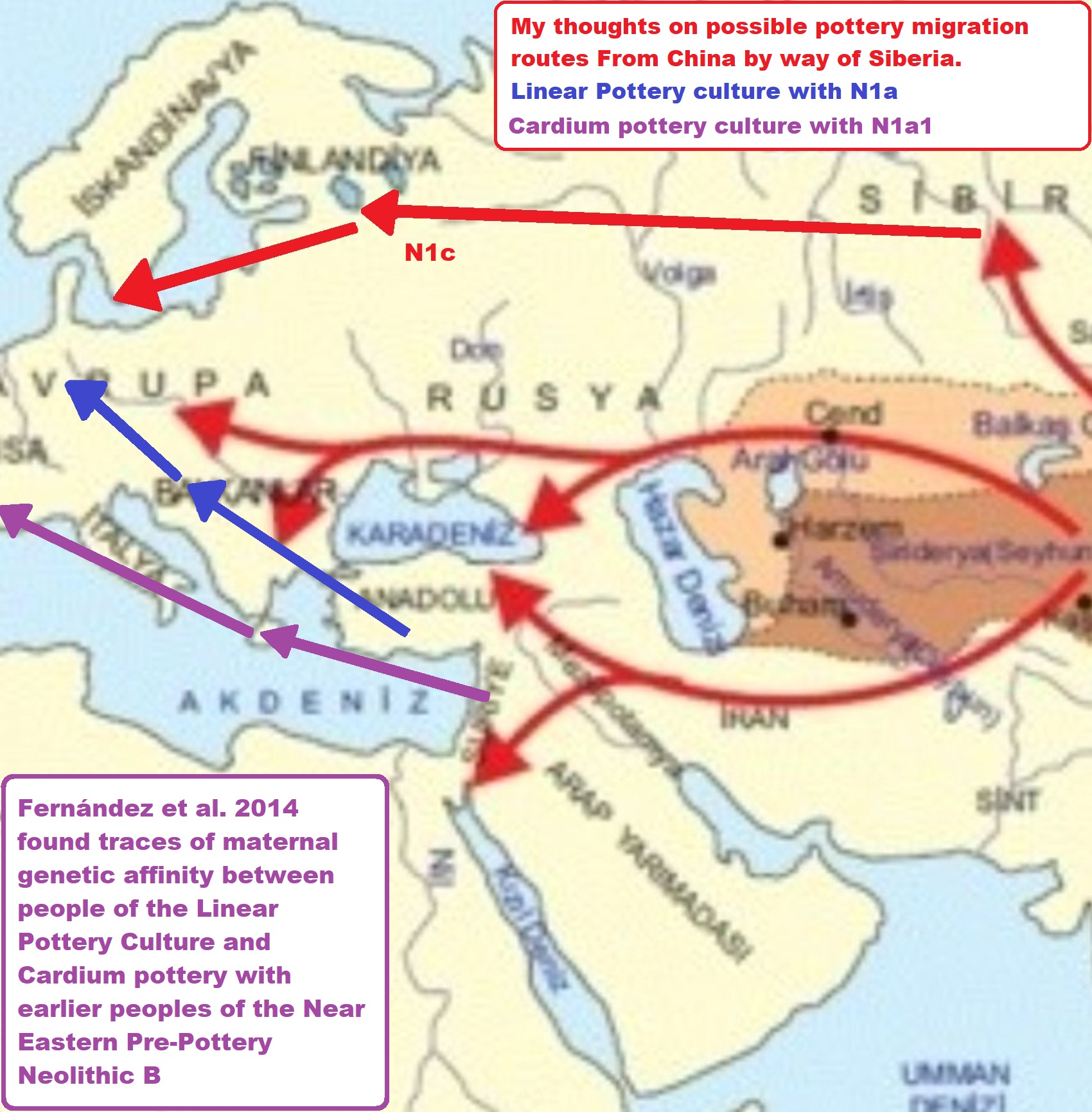
Haplogroup N1c (Y-DNA)
“Haplogroup N1c is found chiefly in north-eastern Europe, particularly in Finland (61%), Lapland (53%), Estonia (34%), Latvia (38%), Lithuania (42%) and northern Russia (30%), and to a lower extent also in central Russia (15%), Belarus (10%), eastern Ukraine (9%), Sweden (7%), Poland (4%) and Turkey (4%). N1c is also prominent among the Uralic-speaking ethnicities of the Volga-Ural region, including the Udmurts (67%), Komi (51%), Mari (50%), and Mordvins (20%), but also among their Turkic neighbors like the Chuvashs (28%), Volga Tatars (21%) and Bashkirs (17%), as well as the Nogais (9%) of southern Russia.” ref
“N1c represents the western extent of haplogroup N, which is found all over the Far East (China, Korea, Japan), Mongolia, and Siberia, especially among Uralic speakers of northern Siberia. Haplogroup N1 reaches a maximum frequency of approximately 95% in the Nenets (40% N1c and 57% N1b) and Nganassans (all N1b), two Uralic tribes of central-northern Siberia, and 90% among the Yakuts (all N1c), a Turkic people who live mainly in the Sakha (Yakutia) Republic in central-eastern Siberia.” ref
“Haplogroup N is a descendant of East Asian macro-haplogroup NO. It is believed to have originated in Indochina or southern China approximately 15,000 to 20,000 years ago.” ref
“Haplogroup N1* and N1c were both found at high frequency (26 out of 70 samples, or 37%) in Neolithic and Bronze Age remains (4500-700 BCE or 6,522-2,722 years ago) from the West Liao River valley in Northeast China (Manchuria) by Yinqiu Cui et al. (2013). Among the Neolithic samples, haplogroup N1 made up two thirds of the samples from the Hongshan culture (4700-2900 BCE or 6,722-4,922 years ago) and all the samples from the Xiaoheyan culture (3000-2200 BCE or 5,022-4,222 years ago), hinting that N1 people played a major role in the diffusion of the Neolithic lifestyle around Northeast China, and probably also to Mongolia and Siberia.” ref
“Ye Zhang et al. 2016 found 100% of Y-DNA N out of 17 samples from the Xueshan culture (Jiangjialiang site) dating from 3600–2900 BCE, and among those 41% belonged to N1c1-Tat. It is therefore extremely likely that the N1c1 subclade found in Europe today has its roots in the Chinese Neolithic. It would have progressively spread across Siberia until north-eastern Europe, possibly reaching the Volga-Ural region around 5500 to 4500 BCE 7,522-6,522 years ago) with the Kama culture (5300-3300 BCE 7,322-5,322 years ago), and the eastern Baltic with the Comb Ceramic culture (4200-2000 BCE 6,222-4,5022 years ago), the presumed ancestral culture of Proto-Finnic and pre-Baltic people. There is little evidence of agriculture or domesticated animals in Siberia during the Neolithic, but pottery was widely used. In that regard it was the opposite development from the Near East, which first developed agriculture then only pottery from circa 5500 BCE, perhaps through contact with East Asians via Siberia or Central Asia.” ref
- N1c (L729)
- N1c1 (M46/Page70/Tat)
- N1c1a (M178): found in Siberia (Khakass-Daurs)
- N1c1a1 (L708): found in Siberia (Anayins)
- N1c1a1a (P298): found in Siberia (Yakuts)
- N1c1a1a1 (L392, L1026): Finno-Ugric branch; found throughout north-east Europe
- N1c1a1a1a (CTS2929/VL29): Baltic-Finnic branch
- N1c1a1a1a1 (L550): West Finnic branch; found around the Baltic Sea and in places settled by the Vikings
- N1c1a1a1a1a (L1025)
- N1c1a1a1a1a1 (M2783): found especially in Balto-Slavic countries, with a peak in Lithuania and Latvia
- N1c1a1a1a1a2 (Y4706): found mostly in Finland and Scandinavia
- N1c1a1a1a2 (CTS9976): East Finnic branch; found among the Chudes (Karelia, Estonia)
- N1c1a1a1a2a (L1022)
- N1c1a1a1a2a1 (Z1936): Finno-Permic branch; found in the Volga-Ural region and among the Karelians and Savonians
- N1c1a1a1a2a1a (Z1925): found in Finland, Lapland, Scandinavia, the Volga-Ural and the Altai
- N1c1a1a1a2a1a1 (Z1933)
- N1c1a1a1a2a1a1a (Z1927): found among the Karelians
- N1c1a1a1a2a1a1b (CTS8565): found among the Savonians
- N1c1a1a2b (L1034): Ugric branch; found in and around Hungary and in Central Asia (Kazakhstan) N1c2 (L666): found in Russia
- N1c2a (M128)
- N1c2b (P43): found in the Volga-Ural region
- N1c2b1 (P63)
- N1c2b2 (L665) ref
Nganasan people
“The Nganasans (/əŋˈɡænəsæn/; Nganasan: ӈәнә”са(нә”) ŋənəhsa(nəh), ня(“) ńæh) are a Uralic people of the Samoyedic branch native to the Taymyr Peninsula in northern Siberia. In the Russian Federation, they are recognized as one of the indigenous peoples of the Russian North. They reside primarily in the settlements of Ust-Avam, Volochanka, and Novaya in the Taymyrsky Dolgano-Nenetsky District of Krasnoyarsk Krai, with smaller populations residing in the towns of Dudinka and Norilsk as well. The Nganasans are thought to be the direct descendants of proto-Uralic peoples. However, there is some evidence that they absorbed another local Siberian population. The Nganasans were traditionally a semi-nomadic people whose main form of subsistence was wild reindeer hunting, in contrast to the Nenets, who herded reindeer. The Nganasans are the northernmost ethnic group of the Eurasian continent and the Russian Federation, historically inhabiting the tundra of the Taymyr Peninsula. The areas they inhabited stretched over an area of more than 100,000 square kilometers, from the Golchikha River in the west to the Khatanga Bay in the east, and from Lake Taymyr in the north to the Dudypta River in the south. The hunting areas of the Nganasan often coincided with those of the Dolgans and Enets to their east and west respectively. In the winter, they resided in the south of the peninsula at the edge of the Arctic tree line, and during the summer they followed wild reindeer up to 400 miles to the north, sometimes even reaching as far as the Byrranga Mountains.” ref
Origins
“The homeland of the proto-Uralic peoples, including the Samoyeds, is suggested to be somewhere near the Ob and Yenisey river drainage areas of Central Siberia and or near Lake Baikal. The Nganasan are considered by most ethnographers who study them to have arisen as an ethnic group when Samoyedic peoples migrated to the Taymyr Peninsula from the south, encountering Paleo-Siberian peoples living there who they then assimilated into their culture. One group of Samoyedic people intermarried with Paleo-Siberian peoples living between the Taz and Yenisei rivers, forming a group that the Soviet ethnographer B.O. Dolgikh refers to as the Samoyed-Ravens. Another group intermarried with the Paleo-Siberian inhabitants of the Pyasina River and formed another group which he called the Samoyed-Eagles. Subsequently, a group of Tungusic people migrated to the region near Lake Pyasino and the Avam River, where they were absorbed into Samoyed culture, forming a new group called the Tidiris. There was another group of Tungusic peoples called the Tavgs who lived along the basins of the Khatanga and Anabar rivers and came into contact with the aforementioned Samoyedic peoples, absorbing their language and creating their own Tavg Savoyedic dialect. It is known that the ancestors of the Nganasan previously inhabited territory further south from a book in the city Mangazeya that lists yasak (fur tribute) payments by the Nganasan which were made in sable, an animal that does not inhabit the tundra where the Nganasan now live. A genetic study in 2019 published in the European Journal for Human Genetics Nature, found that the Nganasans represent the source population for the proto-Uralic people the best and that Nganasan-like ancestry is found in every modern Uralic speakers.” ref
Religion
“The traditional religion of the Nganasans is animistic and shamanistic. Their religion is a particularly well-preserved example of Siberian Shamanism, which remained relatively free of foreign influence due to the Nganasans’ geographic isolation until recent history. Because of their isolation, shamanism was a living phenomenon in the lives of the Nganasans, even into the beginning of the 20th century. The last notable Nganasan shaman’s seances were recorded on film by anthropologists in the 1970s.”
Genetics
“The characteristic genetic marker of the Nganasans and other Uralic peoples is haplogroup N1c-Tat (Y-DNA). Samoyedic peoples mainly have more N1b-P43 than N1c. Haplogroup N originated in the northern part of China in 20,000–25,000 years and then spread to north Eurasia, through Siberia to Northern Europe. Subgroup N1c1 is frequently seen in non-Samoyedic peoples, N1c2 in Samoyedic peoples. In addition, haplogroup Z (mtDNA), found with low frequency in Saami, Finns, and Siberians, is related to the migration of people speaking Uralic languages. In 2019, a study based on genetics, archaeology, and linguistics found that Uralic speakers arrived in the Baltic region from the East, specifically from Siberia, at the beginning of the Iron Age some 2,500 years ago. In a genetic study in 2019 published in the European Journal for Human Genetics Nature, it was found that the Nganasans represent the source population for the proto-Uralic people the best and that Nganasan-like ancestry is found in every modern Uralic speakers. We find that Nganasan-related ancestry is significantly present in all of our ancient samples except for Levänluhta_B, and in many modern, mainly Uralic-speaking populations. The 3500-year-old ancient individuals from Bolshoy represent the highest proportion of Siberian Nganasan-related ancestry seen in this region so far and possibly evidence its earliest presence in the western end of the trans-Siberian expanse. — Lamnidis et al., Ancient Fennoscandian genomes reveal the origin and spread of Siberian ancestry in Europe, Nature” ref
Saami and Berbers—An Unexpected Mitochondrial DNA Link
Abstract
“The sequencing of entire human mitochondrial DNAs belonging to haplogroup U reveals that this clade arose shortly after the “out of Africa” exit and rapidly radiated into numerous regionally distinct subclades. Intriguingly, the Saami of Scandinavia and the Berbers of North Africa were found to share an extremely young branch, aged merely ∼9,000 years. This unexpected finding not only confirms that the Franco-Cantabrian refuge area of southwestern Europe was the source of late-glacial expansions of hunter-gatherers that repopulated northern Europe after the Last Glacial Maximum but also reveals a direct maternal link between those European hunter-gatherer populations and the Berbers.” ref
“Siejdde” Offerings to Spirits offering stone, sieidi
Northern Sami Etymology From Proto-Samic *siejtē Borrowed from Northern Sami sieidi.
Noun sieidi (plural sieidis)
Among the Sami people, a special site where thanks and offerings are given to the spirits. ref
Old Norse seiðr, from Proto-Germanic *saidaz.
Noun *siejtē altar stone, sieidi
Descendants
Western Samic:
Pite Sami: säjjde
Lule Sami: siejdde
Northern Sami: sieidi
Eastern Samic:
Inari Sami: sieiˈdi
Ter Sami: siejjde
→ Finnish: seita ref
“In Old Norse, seiðr (sometimes anglicized as seidhr, seidh, seidr, seithr, seith, or seid) was a type of magic practiced in Norse society during the Late Scandinavian Iron Age. The practice of seiðr is believed to be a form of magic relating to both the telling and shaping of the future. Connected with Norse religion, its origins are largely unknown, although it became gradually eroded following the Christianization of Scandinavia. Accounts of seiðr later made it into sagas and other literary sources, while further evidence has been unearthed by archaeologists. Various scholars have debated the nature of seiðr, some arguing that it was shamanic in context, involving visionary journeys by its practitioners. Seiðr practitioners were of both sexes, although it appears that practicing it was considered to be a feminine trait, with sorceresses being variously known as vǫlur, seiðkonur, and vísendakona. There were also accounts of male practitioners, known as seiðmenn, but in practicing magic they brought a social taboo, known as ergi, on to themselves, and were sometimes persecuted as a result. In many cases, these magical practitioners would have had assistants to aid them in their rituals.” ref
“In pre-Christian Norse mythology, seiðr was associated with both the god Oðinn, a deity who was simultaneously responsible for war, poetry, and sorcery, and the goddess Freyja, a member of the Vanir who was believed to have taught the practice to the Æsir. In the 20th century, adherents of various modern Pagan new religious movements adopted forms of magico-religious practice that include seiðr. The practices of these contemporary seiðr-workers have since been investigated by various academic researchers operating in the field of pagan studies.” ref
“Seiðr is believed to come from Proto-Germanic *saiðaz, cognate with Lithuanian saitas, “sign, soothsaying” and Proto-Celtic *soito- “sorcery” (giving Welsh hud, Breton hud “magic”), all derived from Proto-Indo-European *soi-to- “string, rope”, ultimately from the Proto-Indo-European root *seH2i- “to bind”. Related words in Old High German (see German Saite, used both in string instruments and in bows) and Old English refer to “cord, string,” or “snare, cord, halter” and there is a line in verse 15 of the skaldic poem Ragnarsdrápa that uses seiðr in that sense. However, it is not clear how this derivation relates to the practice of seiðr. It has been suggested that the use of a cord in attraction may be related to seiðr, where the attraction is one element of the practice of seiðr magic described in Norse literature and with witchcraft in Scandinavian folklore. However, if seiðr involved “spinning charms”, that would explain the distaff, a tool used in spinning flax or sometimes wool, that appears to be associated with seiðr practice. In any case, the string relates to the “threads of fate”, that the Nornir spin, measure, and cut. Old English terms cognate with seiðr are siden and sidsa, both of which are attested only in contexts that suggest that they were used by elves (ælfe); these seem likely to have meant something similar to seiðr. Among the Old English words for practitioners of magic are wicca (m.) or wicce (f.), the etymons of Modern English “witch“.” ref
“In the Viking Age, the practice of seiðr by men had connotations of unmanliness or effeminacy, known as ergi, as its manipulative aspects ran counter to the masculine ideal of forthright, open behavior.[6] Freyja and perhaps some of the other goddesses of Norse mythology were seiðr practitioners, as was Oðinn, a fact for which he is taunted by Loki in the Lokasenna.” ref
Sagas
Erik the Red
“In the 13th century Saga of Erik the Red, there was a seiðkona or vǫlva in Greenland named Thorbjǫrg (“Protected by Thor”). She wore a blue cloak and a headpiece of black lamb trimmed with white ermine, carried the symbolic distaff (seiðstafr), which was buried with her, and would sit on a high platform. As related in the Saga: Now, when she came in the evening, accompanied by the man who had been sent to meet her, she was dressed in such wise that she had a blue mantle over her, with strings for the neck, and it was inlaid with gems quite down to the skirt. On her neck she had glass beads. On her head she had a black hood of lambskin, lined with ermine. A staff she had in her hand, with a knob thereon; it was ornamented with brass, and inlaid with gems round about the knob. Around her she wore a girdle of soft hair (or belt of touch wood), and therein was a large skin-bag, in which she kept the talismans needful to her in her wisdom. She wore hairy calf-skin shoes on her feet, with long and strong-looking thongs to them, and great knobs of latten at the ends. On her hands, she had gloves of ermine-skin, and they were white and hairy within.” ref
Other sagas
“As described by Snorri Sturluson in his Ynglinga saga, seiðr includes both divination and manipulative magic. It seems likely that the type of divination of seiðr-practitioners was generally distinct, by dint of an altogether more metaphysical nature, from the day-to-day auguries performed by the seers (menn framsýnir, menn forspáir). However, in the Icelandic saga Vatnsdæla saga, a Spákona’s cloak is black but she also carries a distaff, which allegedly had the power of causing forgetfulness in one who is tapped three times on the left cheek by it.” ref
Practices
Price noted that, because of its connection with ergi, seiðr was undoubtedly located on ‘one of society’s moral and psychological borders’. Seiðr involved the incantation of spells (galdrar, sing. galdr). Practitioners may have been religious leaders of the Viking community and usually required the help of other practitioners to invoke their deities, gods or spirits. As they are described in a number of other Scandinavian sagas, Saga of Erik the Red in particular, the practitioners connected with the spiritual realm through chanting and prayer. Viking texts suggest that the seiðr ritual was used in times of inherent crisis, as a tool for seeing into the future, and for cursing and hexing one’s enemies. With that said, it could have been used for great good or destructive evil, as well as for daily guidance. One author, Neil Price, argues that it was very likely that some parts of the practice involved sexual acts. Scholars have highlighted that the staffs have phallic epithets in various Icelandic sagas.” ref
Mythology
Oðinn and Seiðr
“The 7th-century Tängelgårda stone shows Oðinn leading a troop of warriors all bearing rings. Valknut symbols are drawn beneath his horse, which is depicted with four legs. British archaeologist Neil Price noted that “the realm of sorcery” was present in Oðinn’s many aspects. In Lokasenna, according to the Poetic Edda, Loki accuses Oðinn of practicing seiðr, condemning it as an unmanly art (ergi). A justification for this may be found in the Ynglinga saga, where Snorri opines that following the practice of seiðr rendered the practitioner weak and helpless. One possible example of seiðr in Norse mythology is the prophetic vision given to Oðinn in the Vǫluspá by the Völva after whom the poem is named. Her vision is not connected explicitly with seiðr; however, the word occurs in the poem in relation to a character called Heiðr (who is traditionally associated with Freyja but may be identical with the Völva). The interrelationship between the vǫlva in this account and the Norns, the fates of Norse lore, is strong and striking. Another noted mythological practitioner of seiðr was Gróa, who attempted to assist Thor, and who in the Svipdagsmál in a poem entitled Grógaldr “Gróa’s spell” is summoned from beyond the grave.” ref
Freyja and Seiðr
“Like Oðinn, the Norse goddess Freyja is also associated with ‘seiðr’ in the surviving literature. In the Ynglinga saga (c.1225), written by Icelandic poet Snorri Sturluson, it is stated that seiðr had originally been a practice among the Vanir, but that Freyja, who was herself a member of the Vanir, had introduced it to the Æsir when she joined them. Freyja is identified in Ynglinga saga as an adept of the mysteries of seiðr, and it is said that it was she who taught it to Oðinn: “Njǫrðr’s daughter was Freyja. She presided over the sacrifice. It was she who first acquainted the Æsir with seiðr, which was customary among the Vanir.” ref
Origins
“Since the publication of Jacob Grimm‘s socio-linguistical Deutsches Wörterbuch (p. 638) in 1835, scholarship draws a Balto-Finnic link to seiðr, citing the depiction of its practitioners as such in the sagas and elsewhere, and linking seiðr to the practices of the noaidi, the patrilineal shamans of the Sami people. However, Indo-European origins are also possible. Note that the Finnish word seita and the Sami variants of the term sieidde refer to a human-shaped tree or a large and strangely-shaped stone or rock and do not necessarily reference magical power. There is a good case, however, that these words do derive ultimately from seiðr.” ref
Seiðr and gender roles in Norse society
“Strength and courage are traditionally manly qualities that were highly valued in Old Norse societies. This is exemplified in the attitudes surrounding seiðr and its place as a feminine craft. A woman practicing seiðr would sometimes be called völva, meaning seeress. She would also sometimes be described as spá-kona or seið-kona, meaning prophecy-woman and magic-woman, respectively. Because seiðr was viewed as a feminine practice, any man who engaged in it (seiðmaðr) was associated with a concept called ergi, the designation of a man in Norse society who was unmanly, feminine, and possibly homosexual. Sometimes, female practitioners of the craft would take on young male apprentices, and those who became mothers would teach the practice to their sons. Though not seen as a respectable thing, it wasn’t rare for men to be involved in seiðr magic.” ref
Contemporary Paganism
Contemporary Paganism, also referred to as Neo-Paganism, is an umbrella term used to identify a wide variety of new religious movements, particularly those influenced by the various pagan beliefs of premodern Europe. Several of these contemporary pagan religions draw specifically on the original medieval religious beliefs and practices of Anglo-Saxon England as sources of inspiration, adopting such Anglo-Saxon deities as their own. Seiðr is interpreted differently by different groups and practitioners but usually taken to indicate altered consciousness or even total loss of physical control. Diana L. Paxson and her group Hrafnar have attempted reconstructions of seiðr (particularly the oracular form) from historical material. Author Jan Fries regards seiðr as a form of “shamanic trembling”, which he relates to “seething”, used as a shamanic technique, the idea being his own and developed through experimentation. According to Blain, seiðr is an intrinsic part of spiritual practice connecting practitioners to the wider cosmology in British Germanic Neopaganism.” ref
seiðr
From Proto-Germanic *saidaz (“magic, charm”), from Proto-Indo-European *soytós.
Descendants
· Icelandic: seiður
· → Norwegian Nynorsk: seid
· → Norwegian Bokmål: seid
· → Danish: sejd
Noun seiðr
1. shamanism
2. magic, especially that influences the mind, such as charm, delusion, and hallucination.
3. witchcraft, sorcery ref
Liminality, rock art, and the Sami sacred landscape
“The paper suggests that knowledge of this sacred landscape was not restricted to an elite or to shamans, but was widely shared. For the Sami, religious rituals and associated images (e.g. rock art) involved all levels within a social hierarchy that linked the individual adult or child, the family, the band or sijdda, and the association of family groups or vuobme. This is discussed in the article with reference to Proto-Uralic cosmology in general and the Sami world-view in particular. The concepts of anomaly and liminality enable us to interpret the Badjelánnda rock art site in Laponia, northern Sweden, as not only a place of resource procurement (asbestos, soapstone) but also a sacred site.” ref
SAMI GODS, GODDESSESS AND MYTHICAL ENTITIES
“Here is a list of Sámi gods, goddesses, and other mythical entities. So much has been forgotten about the Sami world view and beliefs and words over the years and most of the written material from the pre-Christian beliefs were written by priests, with very limited understanding of shamanism. Typically the writers would consider all SAMI spiritual beliefs to simply be devil worship. One can’t claim that this information is 100% accurate and far from all-inclusive. There were also local variations since Sápmi is a big area with few people and the communications were not the best back in the days. But this still gives a good basic overview of the pre-Christian Sámi belief system.” ref
The words in different Sami languages are marked with:
NS – North Sámi language/dialect.
SS – South Sámi language/dialect.
LS – Lule Sámi language/dialect.
GS – Gildin Sámi language/dialect.
Arja (ns): Female gázzi (Spirit) -entity. The name means energy, determination. ref
Beaivi (ns) / Biejvve (ls) / Biejjie (ss): Sun. Sun worship is important in the Sami belief system. ref
Barbmoáhkku (ns): Ensures that all migratory birds return well from warmer land, Barbmu. Getting help from Guorga, the brain. ref
Rananiejte (ss): “Spring girl”, «the reindeer calf girl” or “the green girl”. Provides, among other things, for good reindeer grazing. ref
Bieggaolmmái (ns): “The windman» determines the wind direction. He was among other things important during wild reindeer hunting. ref
Boazuáhkku (ns): Goddess of the reindeer and gives hunting luck. Possibly identical to Juksahkku. ref
Čahceolmmái (ns) / Tsjaetsieolmaj (ss): The waterman keeper of the lakes and fishes. ref
Čahcerávga / guovdi (ns): Living in the river or the sea. Used to scare the children, as part of the child-rearing. ref
Čahkalakkat (ns): Chakal: Live by springs. They are small and naked. In the head, they have healing power and the belly is full of silver money. You can get the medicine and the silver money by fooling them and killing them. ref
Gieddegeasgalgu (ns): wise, female being who lives on the outskirts of the residence and whom one can turn to when you have it extra difficult. Known from North Sami areas. In recent times, the gieddegeasgalgu has been given the negative meaning “chatter crone». ref
Gufihtar (ns): These goblin like entities live in gufihtarčohkka, “gufihtarhills». The gufitar lure people in, and they must not eat or drink anything while they are inside the hill, because then you never come out again. ref
Guolleipmil (ns): “The fish god”. Many sacrificial stones by lakes, sea, and rivers are called Guolleipmil. ref
Hálddit (ns): Protects animals and plants. Sometimes represented by sacrificial stones/ sieidi. ref
Ipmel / Ibmil / Jubmel / Jupmele (gs): Some shamans believed that Raedieaehtjie and Raediegiedtie were the same, namely Ipmel / Ibmil. He is considered the highest god. During the Christian mission, the missionaries adopted the name Ipmel / Ibmil, and it became the Sami name of the Christian God. ref
Serge-edni (gs): Raedieaehtjie or Ipmel’s wife. The one who creates the human spirit and leads it to Matharáhkku when children are created. ref
Radius kieddi (gs) / Raediegiedtie (ss): Raedieaehtjies son. Radius-acce / -tattje (gs) / Raedieaehtjie (ss): The highest god, the primordial father, the highest. ref
Jábmiidáhkku (ns) / Jábbmeahkku (ls) / Jaemiehaahka (ss): The goddess of death who rules in the kingdom of death Jábmiidáibmu. ref
Jábmiid- (ns): The deceased who lives underground. ref
Leabeolbmai (ns) / Liejbalmaj (ls) / Liejpalmaj (ss): «The alder wood man». The god of hunting and caretaker of the wild animals. Receives offerings before bear hunting to protect hunters. Alder wood is considered sacred. The red color from the bark was used to paint the drums, and the juice was sprayed on returned bear hunters. ref
Mailmenraedie: Máilbmi (ns) + raedie (ss) = The god of the world. ref
Maadteraahkas (ss) / Mahtaráhkku (ns / ls): «Mother earth, Gaia» or “great-grandmother”. Mother of the three goddesses Sáráhkku, Juksáhkku and Uksáhkku. Has a part in the creation of children.
Naaidegazzi / saivugázzi (ns), noaidegadze / saivogadze (gs): Spirit allie. They can look like little people dressed in colorful Sami clothes. They can be ancestors. They can choose people they teach to become shamans and follow them for the rest of their lives, including on soul journeys. Gazzi can also be inherited or accompany as a dowry. ref
Noidae / saivoloddi, noaideguolli / saivoguolli and noaide heritage / saivosuvari (ns): The shamans can have spirit allies in the form of animals. These can be birds (noidae / saivoloddi), fish (n oaideguolli / saivoguolli) or a reindeer bull (noaidesarvvis / saivosuvari). The strongest shamans have reindeer bulls as spirit allies. ref
Saajve / saajveolmai (ss), sáivo / sáivo-olmai (gs): spirits associated with sacred lakes or mountains also known as saajve (sáivo). Anyone who are connected to saajve has spirit allies in the form of animals at his service, see below. ref
Rohttu (ns): The god of sickness and death. Stays in a gloomy dead kingdom, Rohttuaibmu. ref
Ruđot (ns): Female gázzi beings. ref
Stállu (ns): Giant or troll-like figure. Children are scared with Stállu as part of the child-rearing. ref
Joeksaáhka (ss) / Juksáhkku (ns / ls): «The goddess of hunting. Living in boaššu, the sacred part of the lávvu (tipi) behind the fireplace. Has a part in the creation of children. Can transform an unborn child into a boy. ref
Oksaahka (ss) / Uhksáhkku (ns / ls): “The door goddess”. Lives under the doorstep and guards the home against all evil. Watches out for children during their first years of life, especially when they learn to walk. ref
Saaraahka (ss) / Sáráhkku (ns / ls): Important goddess in southern Sami areas. Lives under the fireplace. Recives sacrifices of all that can be drunk. Important in the creation of children. Helps women in menstruation and when giving births. Children were baptized in the name of Sarahkku. ref
Tiermes (gs) / Dierpmis (ns) / Bajánolmmái (ns) / Aijeke (gs) / Atjek (ls) / Horagálles (gs) / Hovrengaellies (ss) / Thor: Various names for the thunder god. ref
The ProtoUralic world-view
“An equivalent ‘map’ of Proto-Uralic cosmology has been constructed by the Russian scholar Vladimir Napolskikh (1992) using a wide range of ethnographic and historical sources. Proto-Uralic is the term given to the original language and culture of the people speaking the Finno-Permian group of languages, which includes Sami, Finnish, Karelian, and Estonian, and also the Ugric language group, which includes Hungarian and Khanty. Together the two groups form the Finno-Ugrian language family. Scholars have long recognized that the various peoples who speak these languages share various cultural traits, and it was generally assumed that these common traits reflected a common origin in a reconstructed language known as Proto-Uralic that existed around the fifth millennium B.C.” ref
‘In fact, Proto-Uralic is more likely to have been a group of mutually intelligible languages whose integrity was maintained by interaction based on similar traditions, trade, and kinship connections, leading to borrowing. A key feature of the Proto-Uralic world-view is the division of the world into three realms: • The Upper World = South = river headwaters = mountains = heavens;• The Middle (Human) World, in which the World River runs, connecting upper and lower worlds, and in which fir trees connect the earth with the heavens;• The Lower World = North = river mouth = cold sea = underneath. The deity who rules the Upper World is described as the Old Woman of the South, mistress of life, protector of birth and motherhood, the sender of souls, mother of gods, and mistress of migratory water-birds. The sun, the moon, and the Milky Way are other key features of the upper world. Migratory water-fowl such as swans, ducks, and geese serve as messengers to the celestial realm; they also symbolize human and animal souls, and they bring the new year in spring.” ref
“The Lower World begins where the World River flows into the icy seas of the north, and is the realm of evil and the land of the dead. It contains an Island of the Dead, which is either under the water or under the earth. Diving birds like loons are regarded as bad spirits or are associated with shamans. Souls can return from the lower world to the middle world via a subterranean river, which emerges in a Lake (or Sea) of the Water of Life, which is where the water-birds and the human souls are revived and renewed (Napolskikh 1992: 11–12). This reconstruction is based on Volga-Finnish, Permian, Ob-Ugrian, Northern Samoyed, and Selkup data, with some input from Sami and Balti-Finnish sources. Not surprisingly, we cannot identify all of this mythical geography in the Sami world-view that we can reconstruct from scattered historical sources, folklore, and a few myths. In Fennoscandia, rivers flow in directions that often do not match the simple north/south = cold/warm = Lower/Upper World dichotomies that we nd in the Finno-Ugrian cultures in Russia.” ref
“The Lule river, for example, originates in the (cold, northern) mountains in the Badjelánnda region and flows southeast to the (warm, southern) Gulf of Bothnia. Instead, according to the Mjandasj myth, it is the River of Blood that separates the Middle World from the supernatural world, and indeed the Upper and Lower Worlds often seem to be conflated. Nonetheless, there are many similarities. The Old Woman of the South of the Proto-Uralic cosmology has a direct parallel in Máttaráhkká of the Sami but Jábmeáhkká who guards the Underworld is not a separate deity but rather a different aspect of Máttaráhkká herself.” ref
Translation for ‘witch’ in the free English-Finnish dictionary and many other Finnish translations How to say witch in Finnish.
“What’s the Finnish word for witch? Here’s a list of translations. More Finnish words for witch Finnish paganism was the indigenous pagan religion in Finland, Estonia, and Karelia prior to Christianisation. It was a polytheistic religion, worshipping a number of different deities Finnish is not considered to be a particularly easy language to learn for English-speakers. However, don’t be put off! With a little practice, you should soon find yourself able to get. Finnish Easter traditions mix religion and rites of spring. Beware: Miniature witches may ring your doorbell. Finnish Easter traditions mix religious references with customs related to the long-awaited.. Finnish, whose endonym is suomi ([ˈsuo̯mi] (listen) or suomen kieli [ˈsuo̯meŋ ˈkie̯li]) is a Uralic language of the Finnic branch spoken by the majority of the population in Finland. Finnish Words aren’t Gendered. If you’ve ever learned French, you’ll likely remember And the Finnish v is actually like an English w but with straight lips (like an English v.” ref
“Proto-Uralic: original language and culture of the people: which includes Sami, Finnish, Karelian and Estonian, and Hungarian and Khanty, forming the Finno-Ugrian language family. Generally, it is assumed these common traits reflected a common origin in a reconstructed language known as Proto-Uralic that existed around the 7,000-6,000 years ago.” ref
Mattarahkka: earth goddess mother of the daughters Sarahkka, Juksahkka, and Uksahkka. She received souls sent down for incarnation by the god Radien.
Sami Deities and Mythic Figures
“>Relatively little Sami mythology has been translated into English from the nine extant Sami languages so rich in nature imagery. Lutheran pastor Levi Laestadius collected some fragments back in the 1800s, but his accounts are marred by poor storytelling and unconvincing attempts to explain away the stories as superstitious, pre-rational explanations for lost historical or scientific facts. More recently, Elina Helander-Renvall has published a small book of Sami tales (Silde: Sami Mythic Texts and Stories, 2004).” ref
“Although repressed by the missionaries, vestiges of Sami mythology remain intact. Unlike the abstract ideals personified in Greek and Roman myth, Sami myth has remained close to the earth, a reminder that all mythic tales, images, and lore moves in landscapes still magical and alive. Sami stories live on such intimate terms with sun and moon, rain and snow, rock and hill that they invite us to think of mythology as the shining, numinous inside story of the natural world when experienced as sacred.” ref
See also my page on Celtic deities, another on Nordic and Germanic myths and deities, and a Gnostic Glossary. ref
My thanks to my friend and colleague Marilyn Fowler for introducing me to Sami culture. ref
Akkas: goddesses. ref
Akka (also Akko, Rowan, or Raudna, “The Childless One”): crone wife of Horagalles; worshipped near rocks or mountain caves. Reminiscent of the Cailleach of Ireland. In some ways resembles Sif, wife of Thor. ref
Aknidi: daughter of the sun. She lived among humans for a time, teaching embroidering, story-telling, sea songs, button-making, and other skills until people jealous of her beauty and talent crushed her beneath a large rock, whereupon she went back to the sky. Compare Athena/Minerva, White Buffalo Calf Woman, Brigid. ref
Apara: the ghost of a murdered child. ref
Arne: guardian spirit of the arnehawde, pits containing hidden treasures. One could find them by the smoke they emanated. The conditions of whomever buried the treasure had to be fulfilled to retrieve it, with the arne overseeing the entire operation. ref
Attje: gods. ref
Bassa Aske (also Mannu): the moon. ref
Beaivi: feminine name of the sun. ref
Beaivvas: masculine name of the sun. ref
Bieggolmmai: shovel-carrying god of the winds and tempests. Compare Poseidon and Neptune. ref
Boahjenasti: the North Star, around which the pole of the world turns. Ritual acts of sacrifice and other libations of attentive consciousness keep this pillar of the world from falling and plunging everything into senseless unconsciousness. ref
Boasso-ahkka: guardian household spirit of men’s sacred space and activities. ref
Diermmes: a giant hammer-wielding thunder god who controls storms and grasps a rainbow in one hand and a lightning-throwing bow in the other. As with Thor and Jormungand, Diermmes chases Meandas-pyyrre (also called Golle Coarveheargi), a fabulous golden-antlered reindeer with a black head, a white body, burning eyes, and a silver coat. He will eventually reach the reindeer and has already hit it with his first arrow, causing the world to suffer widening deserts, barren oceans, and lack of rain. The second arrow begins to boil the mountains and melt the northern ices (sound familiar?). When Diermmes finally gets close enough to stab Meandas-pyyrre, the sun and moon will go out, and the world will come to an end. ref
Dirran: the trance state used by noaidi during shamanic work. ref
Eanan: the goddess Earth. Compare Gaia, Terra, Turquoise (or Changing) Woman of the Navajo. ref
Gazzi: guardian spirits. Each person is born with one. ref
Geddekis Akko (or Geddekis Galggo): a ruler of wind and weather who granted earnest wishes. ref
Goahti: a Sami home. The home is also a shrine inhabited by household deities and spirits something like the Roman lares. ref
Gufihtar (also Maahiset, Saiwo-olmah, Ulda, Underboniga, Vittra, or Kadnihah): attractive folk who live in the earth. Lucky to be around, but when asked to visit their realm, one should not eat or drink there lest one get stuck underground. Throwing a piece of steel over their reindeer allowed one to keep them. Compare with the Irish People of the Sidhe (fairies). ref
Guopvssahasat: the Northern Lights, who will punish those who fail to appreciate their beauty. ref
Haldi (also Maddu): sprites of places and of animals. Every grove, shore, hill, etc. contained such a genius loci. ref
Horagalles (“Thunder Hero”; also Tiermes, “Hill Man,” or Ukko): a thunder god who bore two hammers. He treated trolls pretty much the way Thor did, flattening them whenever convenient. (In Scandinavian mythology, lightning-wielding gods provided a cosmic balance against what Jung called giantism: anything powerful inflated far beyond normal or healthy limitations.) ref
Iami Aimo: a kind of Valhalla realm within the underworld. ref
Jabma Aimo: the underworld. ref
Jabbmeaaakka: powerful underworld goddess comparable to Persephone, Proserpina, or Hel. ref
Jeetanis: giants. Inflated, but not necessarily hostile. Some outcroppings and hillocks are named after giants. ref
Joiks (yoiks): a capella traditional song chants, usually with few or no lyrics. Noiaidi possessed special songs that allowed them to work powerful magical transformations, singing things into being or changing. ref
Juksahkka (“Bow Woman”): goddess who can make an unborn child male; also an instructor of boys. She lived near the entrance of the home. In some ways reminiscent of Athena/Minerva. ref
Junkars: nature spirits who promote hunting and trapping. ref
Juovlajohttit: the “Christmas Travelers,” spirits in sleds that only some people can see. Looking upon them as they move across the sky can be dangerous to the looker. In some versions, they wore red and were pulled by reindeers, a story that eventually caught the attention of Coca Cola. ref
Kowre: a reindeer deity skinned without use of a metal tool. ref
Leibolmmai (“Alder Man”): the god of the hunt and the forest and its animals. Compare Cernunnos, Pan, and the archetypal Green Man. ref
Manalaiset: the souls of dead people. ref
Mattarahkka: earth goddess mother of the daughters Sarahkka, Juksahkka, and Uksahkka. She received souls sent down for incarnation by the god Radien. ref
Mader Akko: a goddess who restored eyesight and hearing and could see in the dark. She also guided the lost and was worshipped at an altar of three flat stones. Compare Hekate. ref
Naideh: soothsaying priests (as opposed to noaidi) who carried out ceremonial work and sacrifices. ref
Niekija: lovely daughter of the moon, with a red face and silver hair. When Beaivvas sent his son Peivalke to woo her, Peivalke himself fell for her. When the moon concealed her on an island, she was seen by Nainnas, leader of the Northern Lights, who also fell for her, and she for him. But she remained with her mother the moon, and the lovers look at each other across the night sky. ref
Noaidi: shaman. Noiadi conducted healing rituals, prophecied, forecast the weather, retrieve lost souls (in Sami lore each person has a body soul and a free soul that roams when the body is unconscious), and beat a ritual drum decorated with sacred art. At one time missionaries persecuted them, ridiculed their wisdom, and burned their drums: drums whose heads were adorned with elaborate cosmic maps and symbols. Animals safely guide the noaidi, as does the morning star. ref
Padnakjunne (“Dog-Face”): cannibalistic humanoids with dog snouts. ref
Passe (“sacred” or “sanctuary”): altar or sacred place. The word points to the cooking done for sacrificing in gratitude to a god. ref
Radien Attje (“powerful father”): all-ruling god of the upper sky. From him descend human souls that go to Mattarahkka and then to her daughter Sarahkka for incarnation into earthly life. He usually worked through his son. Compare Zeus. ref
Rana Niejta (“Green Fertile Fields”): springtime daughter of Radien. She made everything bloom. Similar to the German Flora. ref
Ruotta and Japmeahkka: spirits of sickness and death. They like to infest merchants’ goods and sailing ships. ref
Sala Niejta: daughter of the sun who ended the cold and snows every year. ref
Saiwo: the underground realm (but not the underworld of the dead) where the Gufihtar or Saiwo-olmah lived like the Irish Sidhe folk. Lucky if allied or traded with. Their magical animals were passed down through families as inheritances. Saiwo-loddeh were magic birds employed by the noaidi. ref
Saiwo-neidah (also Kadnihah): alluring saiwo maidens in red dresses; their hair is like green linen. Their singing is beautiful to hear. Not as deadly as the Sirens or the Lorelei. ref
Sapmi: the Sami homelands. ref
Sarahkka: a well-respected goddess who molds an unborn baby’s body around a soul. She also helps the mother give birth and sat near the hearth. Drinks were offered to her by women, who also ate a special gruel in her honor. Similar to Artemis/Diana. ref
Sarvvabivdu: a cosmic elk hunt reflected in the constellations Gemini, Castor, and Pollux. See Diermmes. ref
Serpent stone: lucky egg-shaped magic stone said to be possessed by serpent kings. If stolen the wielder could use it for health and wealth but had to avoid all the relentless serpents who came in pursuit. ref
Shakkalag: child-sized spirits who lay in the ground just below the surface. Their bellies are stuffed with silver coins. ref
Siedi (also Storjunkare): sacred sites, whether natural or made by humans, around which clans gathered. Offerings are occasionally still left at them. Some are unusually shaped stones or rocks whose markings and holes are reminiscent of humans, animals, gods, etc. A stone taken from such a place will grow lighter when the bearer guesses what the place wants. ref
Sierg-Edne (or -Siedga: “Willow Mother”): wife of Radien and creator of souls. ref
Siida: village. Colonization by European nation-states worked to break down the original siida system, but in places it continues to function. ref
Silde: a tricksterish spirit who upsets travel plans and scatters reindeer herds. He can bring riches and health, but also death if one fears him. Compare Hermes and Mercury. ref
Sjo ra: sea sprites. ref
Stallu: large, stupid trolls who like to challenge people to fights. When beaten they lie still on the ground waiting for their heads to be cut off and their store of silver taken. They own dogs, sometimes wear red hats, and often steal children, fatten them up, and eat them. Their knives bring misfortune when collected. ref
Stuorra-Jovnna: a figure of Sami folklore who could turn into a wolf. ref
Suologievra: the wolf spirit who traverses the lower, middle, and upper worlds. ref
Tarvopaike: a particular place where one prays to the gods. ref
Tille: animals called into human service through magic. ref
Tjatse Olmai: a sprite tended by sitting on the shores of rapids and voicing what one wants to obtain while offering a silver coin. His voice would reply. His assistant was Nekke. ref
Tonta: a stallu with one eye who sticks close to a particular place it guards. Reminiscent of the Irish Formorians. ref
Trollkaringa: troll women. One of them, Atsitje, was married to the original Stallu. ref
Uksahkka (“Door Wife”): midwife helper of newborns and protector of menstruating women and of children from illnesses and other dangers. In homes, she stood near the door. ref
Ulda: Gufihtar who carry off babies. Mothers would place silver amulets around their children to prevent this. ref
Vadas: a being who wrecked ships with storms. ref
Varalden Olmai (also Radien Kiedde): Radien’s son. ref
Vuorwro (also Heiman): a night-wandering female spirit who eats slumberers in rooms that contain no water. Contrast with the succubus and Lilith. ref
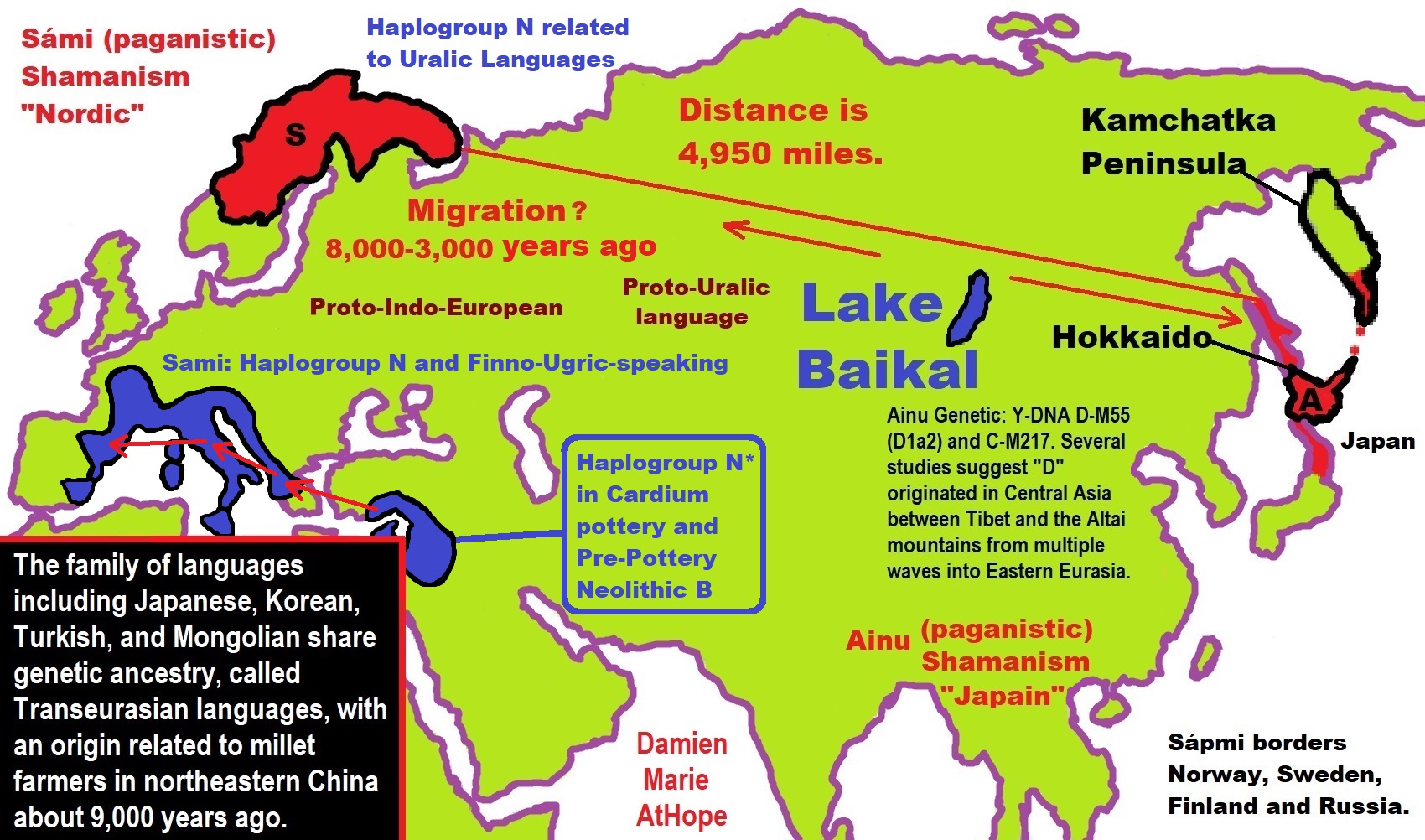
“Rare unclassified haplogroup N* has been found among fossils belonging to the Cardial and Epicardial culture (Cardium pottery) and the Pre-Pottery Neolithic B. Haplogroup N1a – Arabian Peninsula and Northeast Africa. Found also in Central Asia and Southern Siberia. This branch is well attested in ancient people from various cultures of Neolithic Europe, from Hungary to Spain, and among the earliest farmers of Anatolia.” ref
Cardium pottery
“Cardium pottery or Cardial ware is a Neolithic decorative style that gets its name from the imprinting of the clay with the heart-shaped shell of the Corculum cardissa , a member of the cockle family Cardiidae. These forms of pottery are in turn used to define the Neolithic culture which produced and spread them, commonly called the “Cardial culture”. The alternative name, impressed ware, is given by some archaeologists to define this culture, because impressions can be made with sharp objects other than cockle shells, such as a nail or comb.” ref
“Impressed pottery is much more widespread than the Cardial. Impressed ware is found in the zone “covering Italy to the Ligurian coast” as distinct from the more western Cardial extending from Provence to western Portugal. The sequence in prehistoric Europe has traditionally been supposed to start with widespread Cardial ware, and then to develop other methods of impression locally, termed “epi-Cardial”. However the widespread Cardial and Impressed pattern types overlap and are now considered more likely to be contemporary.” ref
“This pottery style gives its name to the main culture of the Mediterranean Neolithic: Cardium pottery culture or Cardial culture, or impressed ware culture, which eventually extended from the Adriatic sea to the Atlantic coasts of Portugal and south to Morocco. The earliest impressed ware sites, dating to 6400–6200 BCE, are in Epirus and Corfu. Settlements then appear in Albania and Dalmatia on the eastern Adriatic coast dating to between 6100 and 5900 BCE. The earliest date in Italy comes from Coppa Nevigata on the Adriatic coast of southern Italy, perhaps as early as 6000 cal BCE.” ref
“Also during Su Carroppu culture in Sardinia, already in its early stages (low strata into Su Coloru cave, c. 6000 BCE) early examples of cardial pottery appear. Northward and westward all secure radiocarbon dates are identical to those for Iberia c. 5500 cal BCE, which indicates a rapid spread of Cardial and related cultures: 2,000 km from the gulf of Genoa to the estuary of the Mondego in probably no more than 100–200 years. This suggests a seafaring expansion by planting colonies along the coast. Older Neolithic cultures existed already at this time in eastern Greece and Crete, apparently having arrived from the Levant, but they appear distinct from the Cardial or impressed ware culture.” ref
“The ceramic tradition in the central Balkans also remained distinct from that along the Adriatic coastline in both style and manufacturing techniques for almost 1,000 years from the 6th millennium BCE. Early Neolithic impressed pottery is found in the Levant, and certain parts of Anatolia, including Mezraa-Teleilat, and in North Africa at Tunus-Redeyef, Tunisia. So the first Cardial settlers in the Adriatic may have come directly from the Levant.” ref
“Of course, it might equally well have come directly from North Africa, and impressed pottery also appears in Egypt. Along the East Mediterranean coast impressed ware has been found in North Syria, Palestine, and Lebanon. Cardial and Epicardial fossils that were analyzed for ancient DNA were found to carry the rare mtDNA (maternal) basal haplogroup N*, supporting an early Neolithic maritime colonization of Mainland Europe through Cyprus and the Aegean Islands by Near-Eastern farmers.” ref
“Fernández et al. 2014 found traces of maternal genetic affinity between people of the Linear Pottery Culture and Cardium pottery with earlier peoples of the Near Eastern Pre-Pottery Neolithic B, and suggested that Neolithic period was initiated by seafaring colonists from the Near East. Olalde et al. 2015 examined the remains of 6 Cardials buried in Spain c. 5470-5220 BCE. The 6 samples of mtDNA extracted belonged to the maternal haplogroups K1a2a, X2c, H4a1a (2 samples), H3, and K1a4a1.” ref
“The authors of the study suggested that the Cardials and peoples of the Linear Pottery Culture were descended from a common farming population in the Balkans, which had subsequently migrated further westwards into Europe along the Mediterranean coast and Danube river respectively. Among modern populations, the Cardials were found to be most closely related to Sardinians and Basque people. The Iberian Cardials carried a noticeable amount of hunter-gatherer ancestry. This hunter-gatherer ancestry was more similar to that of Eastern Hunter-Gatherers (EHGs) than Iberian hunter-gatherers, and appeared to have been acquired before the Cardial expansion into Iberia.” ref
“Mathieson et al. 2018 examined three Cardials buried at the Zemunica Cave in modern-day Croatia c. 5800 BCE. The two samples of Y-DNA extracted belonged to the paternal haplogroups C1a2 and E1b1b1a1b1, while the three samples of mtDNA extracted belonged to the maternal haplogroups H1, K1b1a, and N1a1. The team further examined two Cardials buried at Kargadur in modern-day Croatia c. 5600 BCE. The one male carried the paternal haplogroup G2a2a1, and the maternal haplogroup H7c, and the female carried H5a.” ref
“All three belonged to the Early European Farmer (EEF) cluster, thus being closely related to earlier Neolithic populations of north-west Anatolia, of the Balkan Neolithic, contemporary peoples of the Central European Linear Pottery culture, and later peoples of the Cardial Ware culture in Iberia. This would suggest that the Cardial Ware people and the Linear Pottery people were derived from a single migration from Anatolia into the Balkans, which then split into two and expanded northward and westward further into Europe.” ref
Haplogroup N1c (Y-DNA)
“Haplogroup N1c is found chiefly in north-eastern Europe, particularly in Finland (61%), Lapland (53%), Estonia (34%), Latvia (38%), Lithuania (42%), and northern Russia (30%), and to a lower extent also in central Russia (15%), Belarus (10%), eastern Ukraine (9%), Sweden (7%), Poland (4%) and Turkey (4%). N1c is also prominent among the Uralic-speaking ethnicities of the Volga-Ural region, including the Udmurts (67%), Komi (51%), Mari (50%), and Mordvins (20%), but also among their Turkic neighbors like the Chuvashs (28%), Volga Tatars (21%) and Bashkirs (17%), as well as the Nogais (9%) of southern Russia.” ref
“N1c represents the western extent of haplogroup N, which is found all over the Far East (China, Korea, Japan), Mongolia, and Siberia, especially among Uralic speakers of northern Siberia. Haplogroup N1 reaches a maximum frequency of approximately 95% in the Nenets (40% N1c and 57% N1b) and Nganassans (all N1b), two Uralic tribes of central-northern Siberia, and 90% among the Yakuts (all N1c), a Turkic people who live mainly in the Sakha (Yakutia) Republic in central-eastern Siberia.” ref
“Haplogroup N is a descendant of East Asian macro-haplogroup NO. It is believed to have originated in Indochina or southern China approximately 15,000 to 20,000 years ago. Haplogroup N1* and N1c were both found at high frequency (26 out of 70 samples, or 37%) in Neolithic and Bronze Age remains (4500-700 BCE) from the West Liao River valley in Northeast China (Manchuria) by Yinqiu Cui et al. (2013). Among the Neolithic samples, haplogroup N1 made up two thirds of the samples from the Hongshan culture (4700-2900 BCE) and all the samples from the Xiaoheyan culture (3000-2200 BCE), hinting that N1 people played a major role in the diffusion of the Neolithic lifestyle around Northeast China, and probably also to Mongolia and Siberia.” ref
“Ye Zhang et al. 2016 found 100% of Y-DNA N out of 17 samples from the Xueshan culture (Jiangjialiang site) dating from 3600–2900 BCE, and among those 41% belonged to N1c1-Tat. It is therefore extremely likely that the N1c1 subclade found in Europe today has its roots in the Chinese Neolithic. It would have progressively spread across Siberia until north-eastern Europe, possibly reaching the Volga-Ural region around 5500 to 4500 BCE with the Kama culture (5300-3300 BCE), and the eastern Baltic with the Comb Ceramic culture (4200-2000 BCE), the presumed ancestral culture of Proto-Finnic and pre-Baltic people. There is little evidence of agriculture or domesticated animals in Siberia during the Neolithic, but pottery was widely used. In that regard it was the opposite development from the Near East, which first developed agriculture then only pottery from circa 5500 BCE, perhaps through contact with East Asians via Siberia or Central Asia.” ref
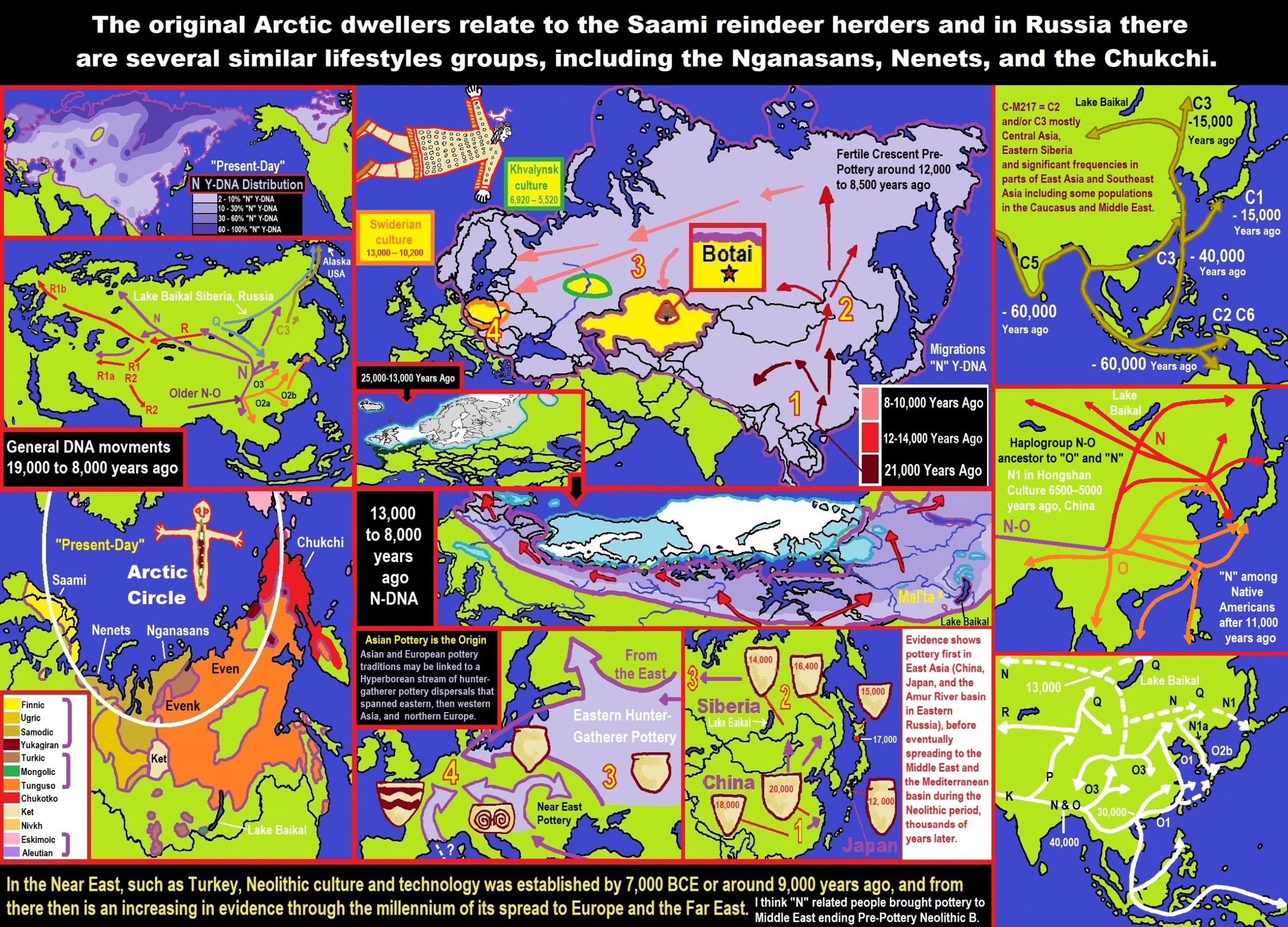
ref, ref, ref, ref, ref, ref, ref, ref, ref, ref, ref, ref, ref, ref, ref, ref, ref
“The shaman is, above all, a connecting figure, bridging several worlds for his people, traveling between this world, the underworld, and the heavens. He transforms himself into an animal and talks with ghosts, the dead, the deities, and the ancestors. He dies and revives. He brings back knowledge from the shadow realm, thus linking his people to the spirits and places which were once mythically accessible to all.–anthropologist Barbara Meyerhoff” ref
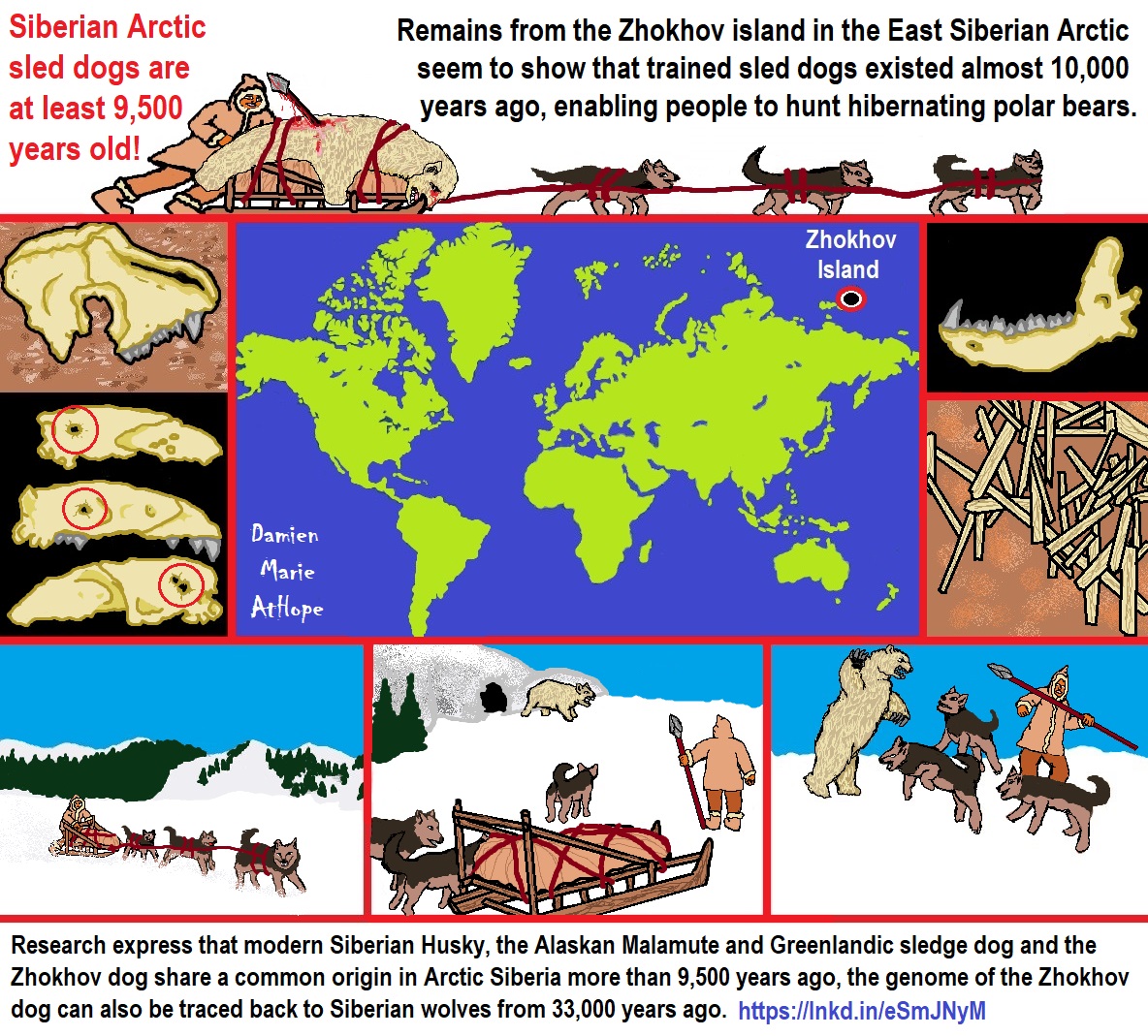
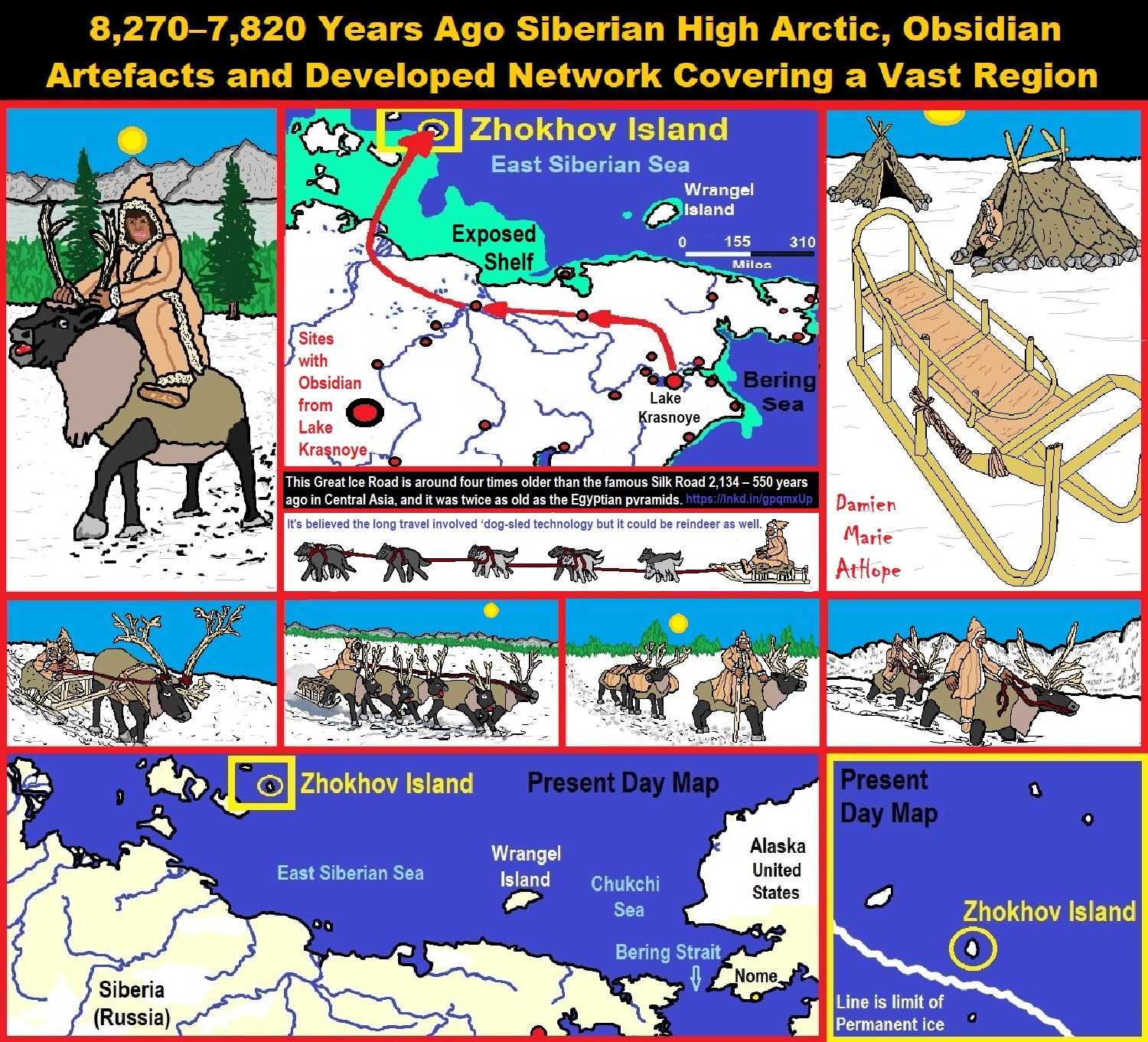
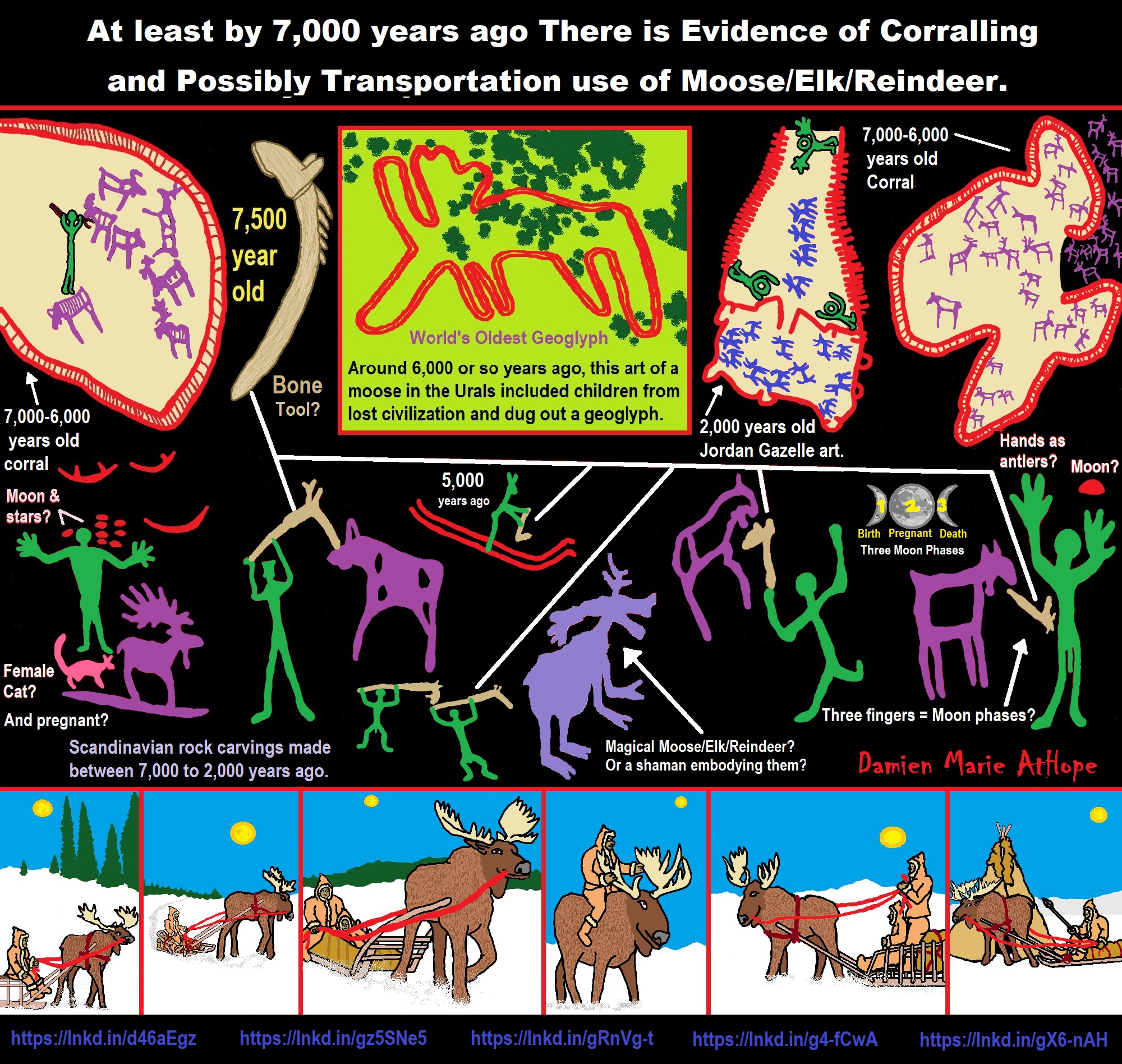
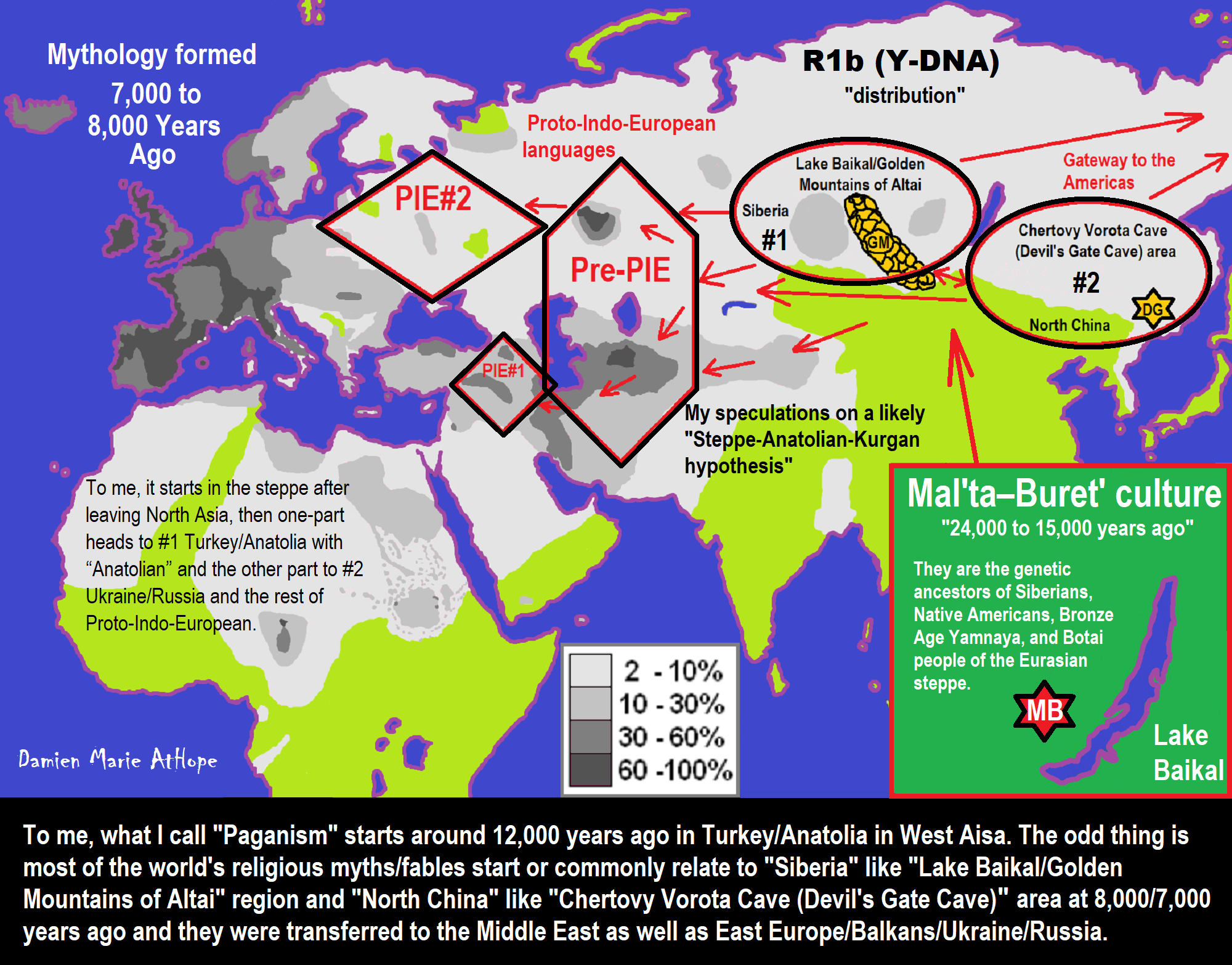
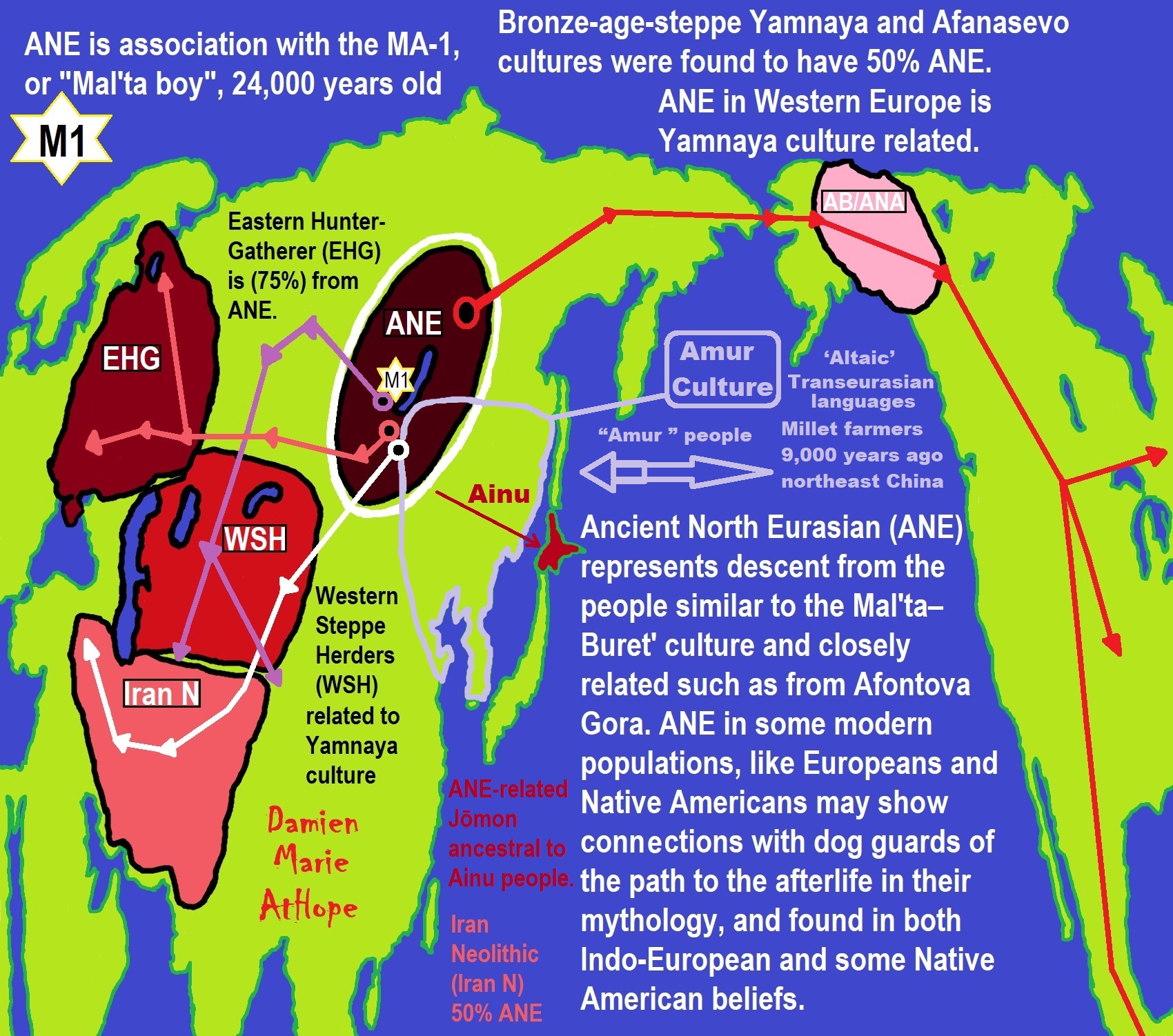
Groups partially derived from the Ancient North Eurasians
“The ANE lineage is defined by association with the MA-1, or “Mal’ta boy”, remains of 24,000 years ago in central Siberia Mal’ta-Buret’ culture 24,000-15,000 years ago. The Ancient North Eurasians (ANE) samples (Afontova Gora 3, Mal’ta 1, and Yana-RHS) show evidence for minor gene flow from an East Asian-related group (simplified by the Amis, Han, or Tianyuan) but no evidence for ANE-related geneflow into East Asians (Amis, Han, Tianyuan), except the Ainu, of North Japan.” ref
“The ANE lineage is defined by association with the MA-1, or “Mal’ta boy”, remains of 24,000 years ago in central Siberia Mal’ta-Buret’ culture 24,000-15,000 years ago “basal to modern-day Europeans”. Some Ancient North Eurasians also carried East Asian populations, such as Tianyuan Man.” ref
“Bronze-age-steppe Yamnaya and Afanasevo cultures were ANE at around 50% and Eastern Hunter-Gatherer (EHG) at around 75% ANE. Karelia culture: Y-DNA R1a-M417 8,400 years ago, Y-DNA J, 7,200 years ago, and Samara, of Y-haplogroup R1b-P297 7,600 years ago is closely related to ANE from Afontova Gora, 18,000 years ago around the time of blond hair first seen there.” ref
Ancient North Eurasian
“In archaeogenetics, the term Ancient North Eurasian (often abbreviated as ANE) is the name given to an ancestral West Eurasian component that represents descent from the people similar to the Mal’ta–Buret’ culture and populations closely related to them, such as from Afontova Gora and the Yana Rhinoceros Horn Site. Significant ANE ancestry are found in some modern populations, including Europeans and Native Americans.” ref
“The ANE lineage is defined by association with the MA-1, or “Mal’ta boy“, the remains of an individual who lived during the Last Glacial Maximum, 24,000 years ago in central Siberia, Ancient North Eurasians are described as a lineage “which is deeply related to Paleolithic/Mesolithic hunter-gatherers in Europe,” meaning that they diverged from Paleolithic Europeans a long time ago.” ref
“The ANE population has also been described as having been “basal to modern-day Europeans” but not especially related to East Asians, and is suggested to have perhaps originated in Europe or Western Asia or the Eurasian Steppe of Central Asia. However, some samples associated with Ancient North Eurasians also carried ancestry from an ancient East Asian population, such as Tianyuan Man. Sikora et al. (2019) found that the Yana RHS sample (31,600 BP) in Northern Siberia “can be modeled as early West Eurasian with an approximately 22% contribution from early East Asians.” ref
“Populations genetically similar to MA-1 were an important genetic contributor to Native Americans, Europeans, Central Asians, South Asians, and some East Asian groups, in order of significance. Lazaridis et al. (2016:10) note “a cline of ANE ancestry across the east-west extent of Eurasia.” The ancient Bronze-age-steppe Yamnaya and Afanasevo cultures were found to have a noteworthy ANE component at ~50%.” ref
“According to Moreno-Mayar et al. 2018 between 14% and 38% of Native American ancestry may originate from gene flow from the Mal’ta–Buret’ people (ANE). This difference is caused by the penetration of posterior Siberian migrations into the Americas, with the lowest percentages of ANE ancestry found in Eskimos and Alaskan Natives, as these groups are the result of migrations into the Americas roughly 5,000 years ago.” ref
“Estimates for ANE ancestry among first wave Native Americans show higher percentages, such as 42% for those belonging to the Andean region in South America. The other gene flow in Native Americans (the remainder of their ancestry) was of East Asian origin. Gene sequencing of another south-central Siberian people (Afontova Gora-2) dating to approximately 17,000 years ago, revealed similar autosomal genetic signatures to that of Mal’ta boy-1, suggesting that the region was continuously occupied by humans throughout the Last Glacial Maximum.” ref
“The earliest known individual with a genetic mutation associated with blonde hair in modern Europeans is an Ancient North Eurasian female dating to around 16000 BCE from the Afontova Gora 3 site in Siberia. It has been suggested that their mythology may have included a narrative, found in both Indo-European and some Native American fables, in which a dog guards the path to the afterlife.” ref
“Genomic studies also indicate that the ANE component was introduced to Western Europe by people related to the Yamnaya culture, long after the Paleolithic. It is reported in modern-day Europeans (7%–25%), but not of Europeans before the Bronze Age. Additional ANE ancestry is found in European populations through paleolithic interactions with Eastern Hunter-Gatherers, which resulted in populations such as Scandinavian Hunter-Gatherers.” ref
“The Ancient North Eurasians (ANE) split from the ancestors of European peoples somewhere in the Middle East or South-central Asia, and used a northern dispersal route through Central Asia into Northern Asia and Siberia. Genetic analyses show that all ANE samples (Afontova Gora 3, Mal’ta 1, and Yana-RHS) show evidence for minor gene flow from an East Asian-related group (simplified by the Amis, Han, or Tianyuan). In contrast, no evidence for ANE-related geneflow into East Asians (Amis, Han, Tianyuan), except the Ainu, was found.” ref
“Genetic data suggests that the ANE formed during the Terminal Upper-Paleolithic (36+-1,5ka) period from a deeply European-related population, which was once widespread in Northern Eurasia, and from an early East Asian-related group, which migrated northwards into Central Asia and Siberia, merging with this deeply European-related population. These population dynamics and constant northwards geneflow of East Asian-related ancestry would later gave rise to the “Ancestral Native Americans” and Paleosiberians, which replaced the ANE as dominant population of Siberia.” ref
Groups partially derived from the Ancient North Eurasians
“Eastern Hunter-Gatherer (EHG) is a lineage derived predominantly (75%) from ANE. It is represented by two individuals from Karelia, one of Y-haplogroup R1a-M417, dated c. 8.4 kya, the other of Y-haplogroup J, dated c. 7.2 kya; and one individual from Samara, of Y-haplogroup R1b-P297, dated c. 7.6 kya. This lineage is closely related to the ANE sample from Afontova Gora, dated c. 18 kya. After the end of the Last Glacial Maximum, the Western Hunter-Gatherers (WHG) and EHG lineages merged in Eastern Europe, accounting for early presence of ANE-derived ancestry in Mesolithic Europe. Evidence suggests that as Ancient North Eurasians migrated West from Eastern Siberia, they absorbed Western Hunter-Gatherers and other West Eurasian populations as well.” ref
“Caucasian Hunter-Gatherer (CHG) is represented by the Satsurblia individual dated ~13 kya (from the Satsurblia cave in Georgia), and carried 36% ANE-derived admixture. While the rest of their ancestry is derived from the Dzudzuana cave individual dated ~26 kya, which lacked ANE-admixture, Dzudzuana affinity in the Caucasus decreased with the arrival of ANE at ~13 kya Satsurblia.” ref
“Scandinavian Hunter-Gatherer (SHG) is represented by several individuals buried at Motala, Sweden ca. 6000 BC. They were descended from Western Hunter-Gatherers who initially settled Scandinavia from the south, and later populations of EHG who entered Scandinavia from the north through the coast of Norway.” ref
“Iran Neolithic (Iran_N) individuals dated ~8.5 kya carried 50% ANE-derived admixture and 50% Dzudzuana-related admixture, marking them as different from other Near-Eastern and Anatolian Neolithics who didn’t have ANE admixture. Iran Neolithics were later replaced by Iran Chalcolithics, who were a mixture of Iran Neolithic and Near Eastern Levant Neolithic.” ref
“Ancient Beringian/Ancestral Native American are specific archaeogenetic lineages, based on the genome of an infant found at the Upward Sun River site (dubbed USR1), dated to 11,500 years ago. The AB lineage diverged from the Ancestral Native American (ANA) lineage about 20,000 years ago.” ref
“West Siberian Hunter-Gatherer (WSHG) are a specific archaeogenetic lineage, first reported in a genetic study published in Science in September 2019. WSGs were found to be of about 30% EHG ancestry, 50% ANE ancestry, and 20% to 38% East Asian ancestry.” ref
“Western Steppe Herders (WSH) is the name given to a distinct ancestral component that represents descent closely related to the Yamnaya culture of the Pontic–Caspian steppe. This ancestry is often referred to as Yamnaya ancestry or Steppe ancestry.” ref
“Late Upper Paeolithic Lake Baikal – Ust’Kyakhta-3 (UKY) 14,050-13,770 BP were mixture of 30% ANE ancestry and 70% East Asian ancestry.” ref
“Lake Baikal Holocene – Baikal Eneolithic (Baikal_EN) and Baikal Early Bronze Age (Baikal_EBA) derived 6.4% to 20.1% ancestry from ANE, while rest of their ancestry was derived from East Asians. Fofonovo_EN near by Lake Baikal were mixture of 12-17% ANE ancestry and 83-87% East Asian ancestry.” ref
“Hokkaido Jōmon people specifically refers to the Jōmon period population of Hokkaido in northernmost Japan. Though the Jōmon people themselves descended mainly from East Asian lineages, one study found an affinity between Hokkaido Jōmon with the Northern Eurasian Yana sample (an ANE-related group, related to Mal’ta), and suggest as an explanation the possibility of minor Yana gene flow into the Hokkaido Jōmon population (as well as other possibilities). A more recent study by Cooke et al. 2021, confirmed ANE-related geneflow among the Jōmon people, partially ancestral to the Ainu people. ANE ancestry among Jōmon people is estimated at 21%, however, there is a North to South cline within the Japanese archipelago, with the highest amount of ANE ancestry in Hokkaido and Tohoku.” ref
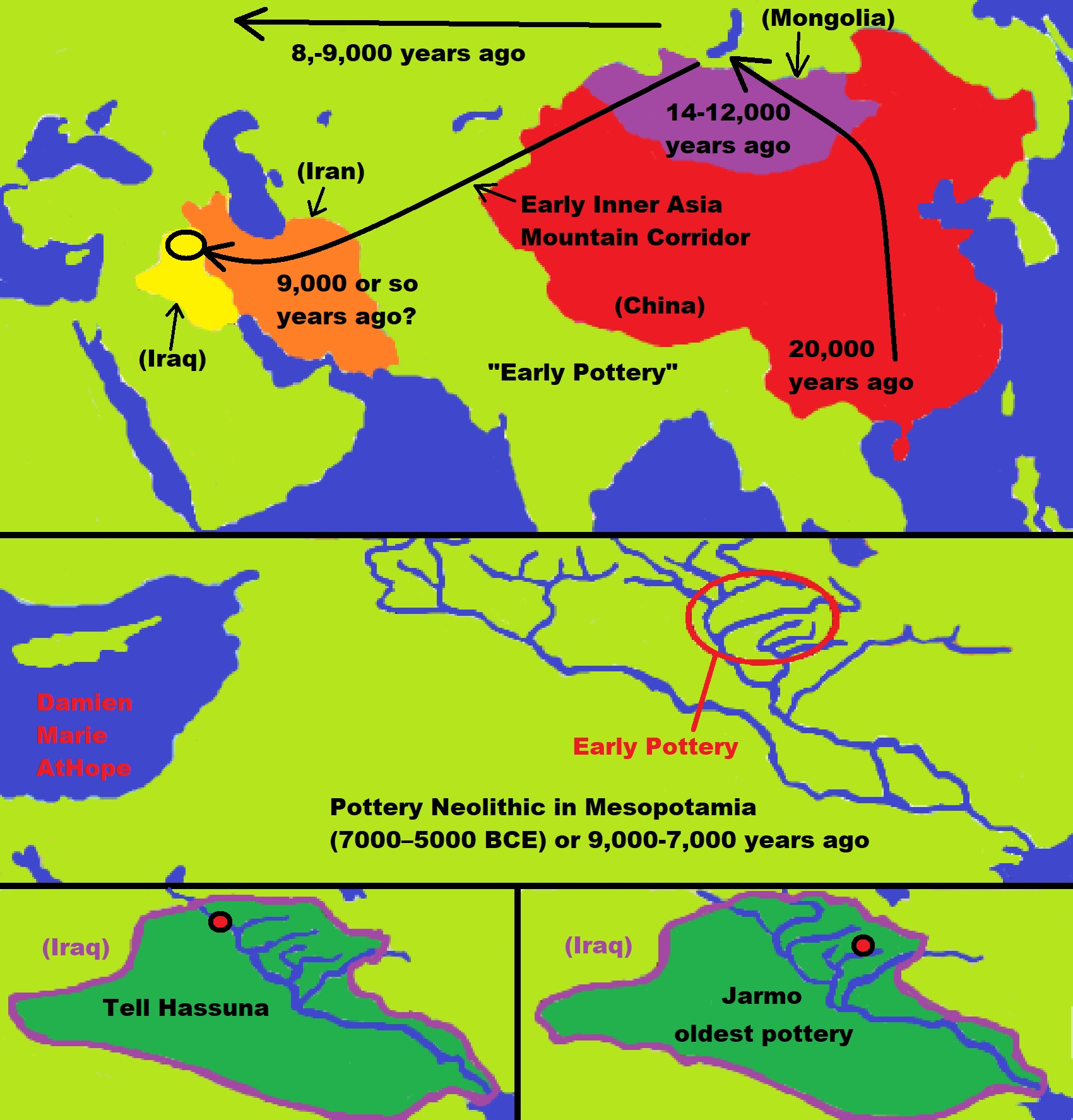
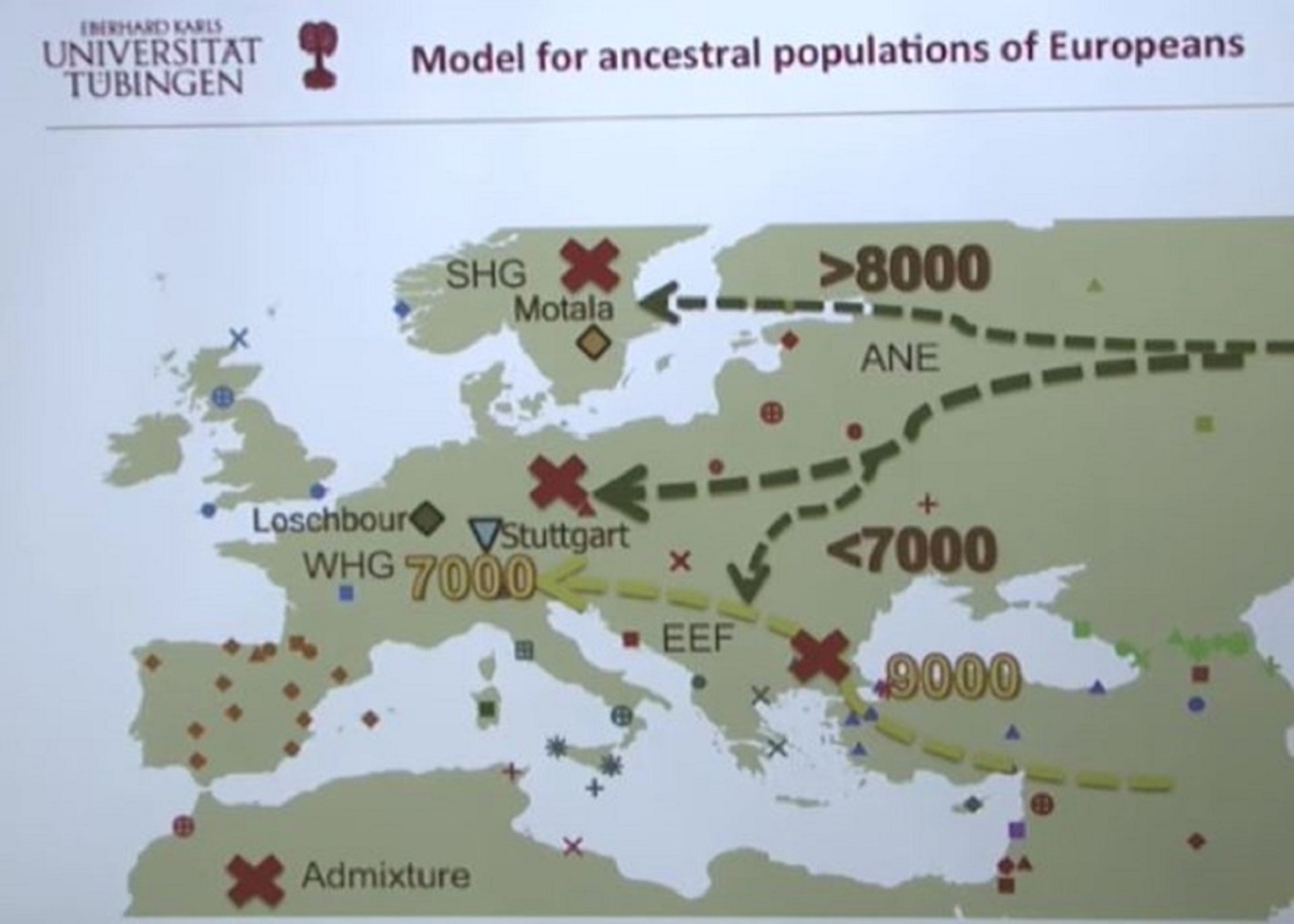
Pic ref
Ancient Human Genomes…Present-Day Europeans – Johannes Krause (Video)
Ancient North Eurasian (ANE)
Eastern Hunter-Gatherer (EHG)
Western Hunter-Gatherers (WHG)
Scandinavian Hunter-Gatherer (SHG)
Early European Farmers (EEF)
A quick look at the Genetic history of Europe
“The most significant recent dispersal of modern humans from Africa gave rise to an undifferentiated “non-African” lineage by some 70,000-50,000 years ago. By about 50–40 ka a basal West Eurasian lineage had emerged, as had a separate East Asian lineage. Both basal East and West Eurasians acquired Neanderthal admixture in Europe and Asia. European early modern humans (EEMH) lineages between 40,000-26,000 years ago (Aurignacian) were still part of a large Western Eurasian “meta-population”, related to Central and Western Asian populations. Divergence into genetically distinct sub-populations within Western Eurasia is a result of increased selection pressure and founder effects during the Last Glacial Maximum (LGM, Gravettian). By the end of the LGM, after 20,000 years ago, A Western European lineage, dubbed West European Hunter-Gatherer (WHG) emerges from the Solutrean refugium during the European Mesolithic. These Mesolithic hunter-gatherer cultures are substantially replaced in the Neolithic Revolution by the arrival of Early European Farmers (EEF) lineages derived from Mesolithic populations of West Asia (Anatolia and the Caucasus). In the European Bronze Age, there were again substantial population replacements in parts of Europe by the intrusion of Ancient North Eurasian (ANE) lineages from the Pontic–Caspian steppes. These Bronze Age population replacements are associated with the Beaker culture archaeologically and with the Indo-European expansion linguistically.” ref
“As a result of the population movements during the Mesolithic to Bronze Age, modern European populations are distinguished by differences in WHG, EEF, and ANE ancestry. Admixture rates varied geographically; in the late Neolithic, WHG ancestry in farmers in Hungary was at around 10%, in Germany around 25%, and in Iberia as high as 50%. The contribution of EEF is more significant in Mediterranean Europe, and declines towards northern and northeastern Europe, where WHG ancestry is stronger; the Sardinians are considered to be the closest European group to the population of the EEF. ANE ancestry is found throughout Europe, with a maximum of about 20% found in Baltic people and Finns. Ethnogenesis of the modern ethnic groups of Europe in the historical period is associated with numerous admixture events, primarily those associated with the Roman, Germanic, Norse, Slavic, Berber, Arab and Turkish expansions. Research into the genetic history of Europe became possible in the second half of the 20th century, but did not yield results with a high resolution before the 1990s. In the 1990s, preliminary results became possible, but they remained mostly limited to studies of mitochondrial and Y-chromosomal lineages. Autosomal DNA became more easily accessible in the 2000s, and since the mid-2010s, results of previously unattainable resolution, many of them based on full-genome analysis of ancient DNA, have been published at an accelerated pace.” ref
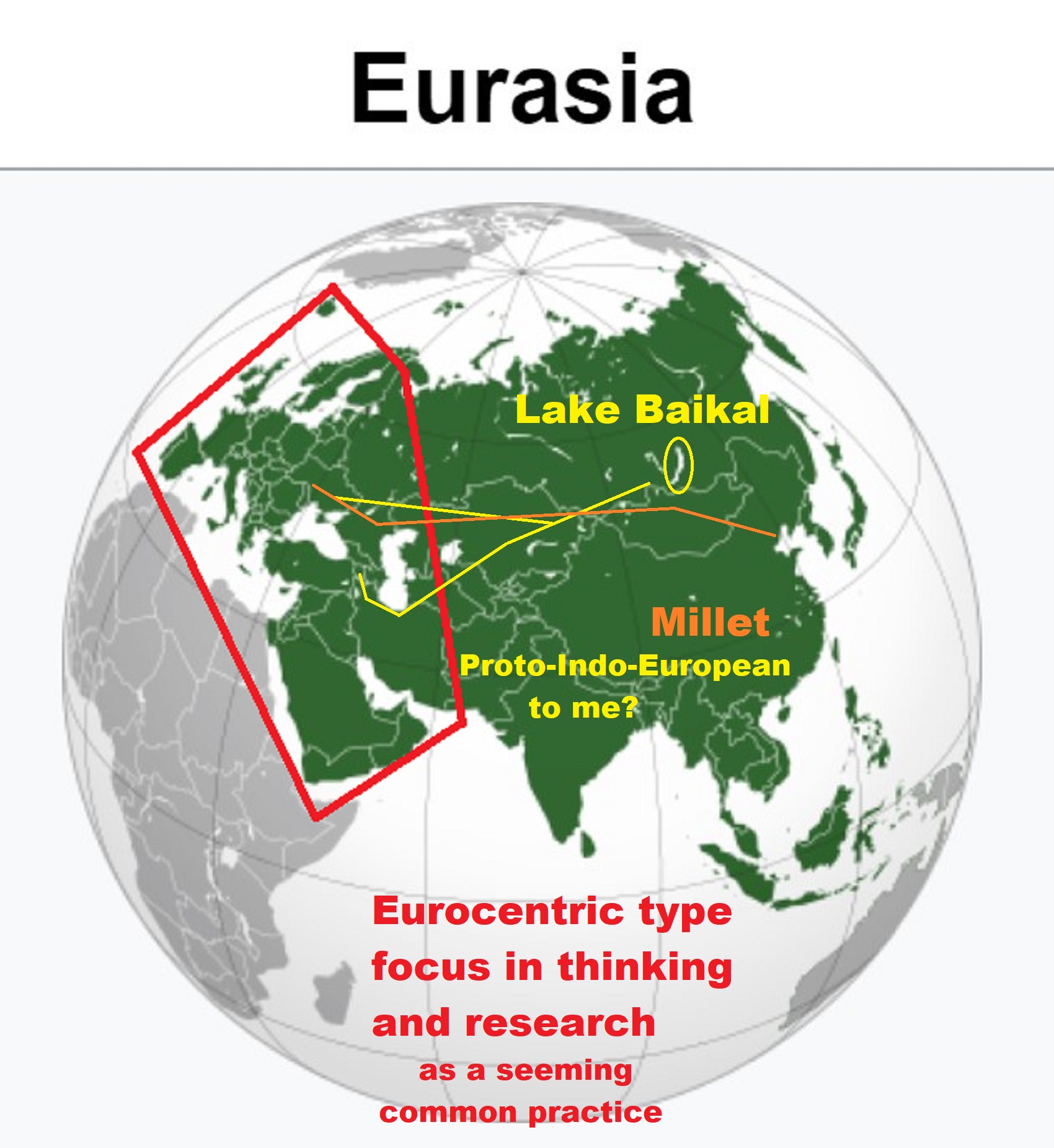
“Asian varieties of millet made their way from China to the Black Sea region of Europe by 5000 BCE or 7,000 years ago.” https://en.wikipedia.org/wiki/Millet
Origins of ‘Transeurasian’ languages traced to Neolithic millet farmers in north-eastern China about 9,000 years ago
“A study combining linguistic, genetic, and archaeological evidence has traced the origins of a family of languages including modern Japanese, Korean, Turkish and Mongolian and the people who speak them to millet farmers who inhabited a region in north-eastern China about 9,000 years ago. The findings outlined on Wednesday document a shared genetic ancestry for the hundreds of millions of people who speak what the researchers call Transeurasian languages across an area stretching more than 5,000 miles (8,000km).” ref
“Millet was an important early crop as hunter-gatherers transitioned to an agricultural lifestyle. There are 98 Transeurasian languages, including Korean, Japanese, and various Turkic languages in parts of Europe, Anatolia, Central Asia, and Siberia, various Mongolic languages, and various Tungusic languages in Manchuria and Siberia. This language family’s beginnings were traced to Neolithic millet farmers in the Liao River valley, an area encompassing parts of the Chinese provinces of Liaoning and Jilin and the region of Inner Mongolia. As these farmers moved across north-eastern Asia over thousands of years, the descendant languages spread north and west into Siberia and the steppes and east into the Korean peninsula and over the sea to the Japanese archipelago.” ref
“Eurasiatic is a proposed language with many language families historically spoken in northern, western, and southern Eurasia; which typically include Altaic (Mongolic, Tungusic, and Turkic), Chukchi-Kamchatkan, Eskimo–Aleut, Indo-European, and Uralic.” ref
“Voiced stops such as /d/ occur in the Indo-European, Yeniseian, Turkic, Mongolian, Tungusic, Japonic and Sino-Tibetan languages. They have also later arisen in several branches of Uralic.” ref
“Uralo-Siberian is a hypothetical language family of Uralic, Yukaghir, Eskimo–Aleut and besides linguistic evidence, several genetic studies, support a common origin in Northeast Asia.” ref
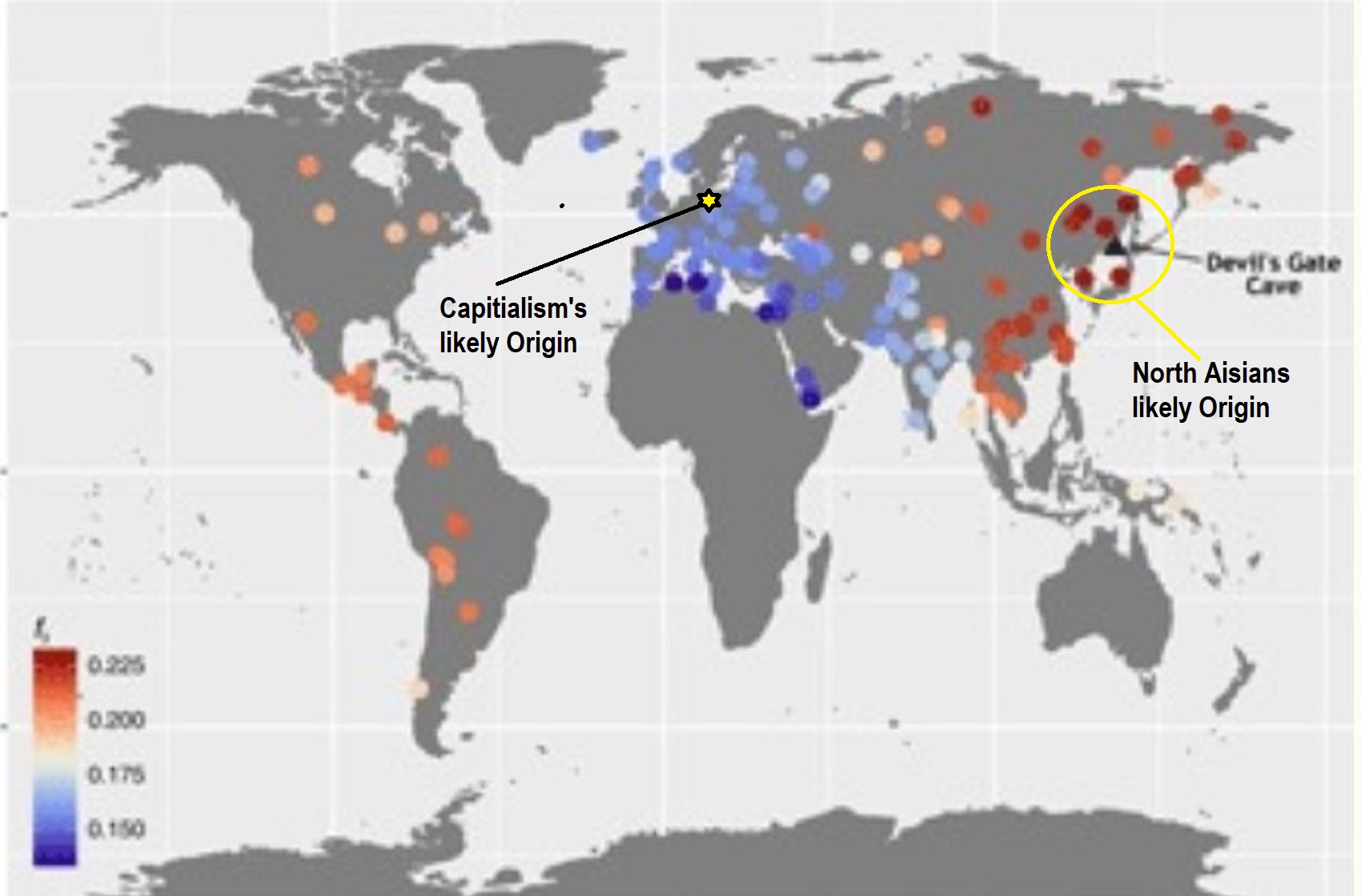
Pic ref
Ancient Women Found in a Russian Cave Turn Out to Be Closely Related to The Modern Population https://www.sciencealert.com/ancient-women-found-in-a-russian-cave-turn-out-to-be-closely-related-to-the-modern-population
Abstract
“Ancient genomes have revolutionized our understanding of Holocene prehistory and, particularly, the Neolithic transition in western Eurasia. In contrast, East Asia has so far received little attention, despite representing a core region at which the Neolithic transition took place independently ~3 millennia after its onset in the Near East. We report genome-wide data from two hunter-gatherers from Devil’s Gate, an early Neolithic cave site (dated to ~7.7 thousand years ago) located in East Asia, on the border between Russia and Korea. Both of these individuals are genetically most similar to geographically close modern populations from the Amur Basin, all speaking Tungusic languages, and, in particular, to the Ulchi. The similarity to nearby modern populations and the low levels of additional genetic material in the Ulchi imply a high level of genetic continuity in this region during the Holocene, a pattern that markedly contrasts with that reported for Europe.” ref
Chertovy Vorota Cave (known as Devil’s Gate Cave in English)
“Three of the specimens (including the only adult male plus NEO235/Skull G and another adult female, labeled as Skull Е, DevilsGate1, or NEO240, who has been genetically determined to be a first-degree relative of NEO235/Skull G) have been assigned to mtDNA haplogroup D4m; a previous genetic analysis of one of these adult female specimens determined her mtDNA haplogroup to be D4. Another three specimens (including the juvenile female, the DevilsGate2 specimen, and another adult female; both the juvenile female and the DevilsGate2 specimen have been determined to be first-degree relatives of the other adult female, and the juvenile female and the DevilsGate2 specimen also have been determined to be second-degree relatives of each other) have been assigned to haplogroup D4; a previous genetic analysis of the DevilsGate2 specimen determined her mtDNA haplogroup to be M. The only specimen from the cave who has been confirmed to be male through genetic analysis has been assigned to Y-DNA haplogroup C2b-F6273/Y6704/Y6708, equivalent to C2b-L1373, the northern (Central Asian, Siberian, and indigenous American) branch of haplogroup C2-M217.” ref
“When compared against all populations on record, ancient or modern, the ancient Chertovy Vorota individuals were found to be genetically closest to the contemporary Ulchi, speakers of a Tungusic language from the lower Amur Basin. The DevilsGate1 and DevilsGate2 specimens were also found to be close to the Hezhen and Oroqen, two other contemporary Tungusic-speaking populations from the basin of the Amur River, as well as contemporary Koreans, and Nganasans. When compared against an outgroup from southern Africa (Khomani), outgroup f3 statistics indicate that DevilsGate1 and DevilsGate2 exhibit greatest shared drift with representatives of the same six populations, though in slightly different rank order: DevilsGate1 shares greatest drift with Ulchi followed in order by Oroqen, Hezhen, Korean, and Nganasan, whereas DevilsGate2 shares greatest drift with Ulchi followed in order by Nganasan, Hezhen, Korean, Japanese, and Oroqen. The outgroup f3 statistics also reveal a tendency for the DevilsGate2 specimen to exhibit slightly greater shared drift with contemporary populations than the DevilsGate1 specimen shares with contemporary populations. The ancient Chertovy Vorota individuals are genetically closest to the Ulchi, followed by the Oroqen and Hezhen. The genetic distance from the ancient Chertovy Vorota individuals to Mal’ta boy is the same as that from modern East Asian populations to Mal’ta boy.” ref
“Haplogroup C-M217, also known as C2 (and previously as C3), is a Y-chromosome DNA haplogroup. It is the most frequently occurring branch of the wider Haplogroup C (M130). It is found mostly in Central Asia, Eastern Siberia and significant frequencies in parts of East Asia and Southeast Asia including some populations in the Caucasus, Middle East, South Asia, East Europe. It is found in a much more widespread areas with a low frequency of less than 2%. The haplogroup C-M217 is now found at high frequencies among Central Asian peoples, indigenous Siberians, and some Native peoples of North America. In particular, males belonging to peoples such as the Buryats, Evens, Evenks, Itelmens, Kalmyks, Kazakhs, Koryaks, Mongolians, Negidals, Nivkhs, Udege, and Ulchi have high levels of M217.” ref
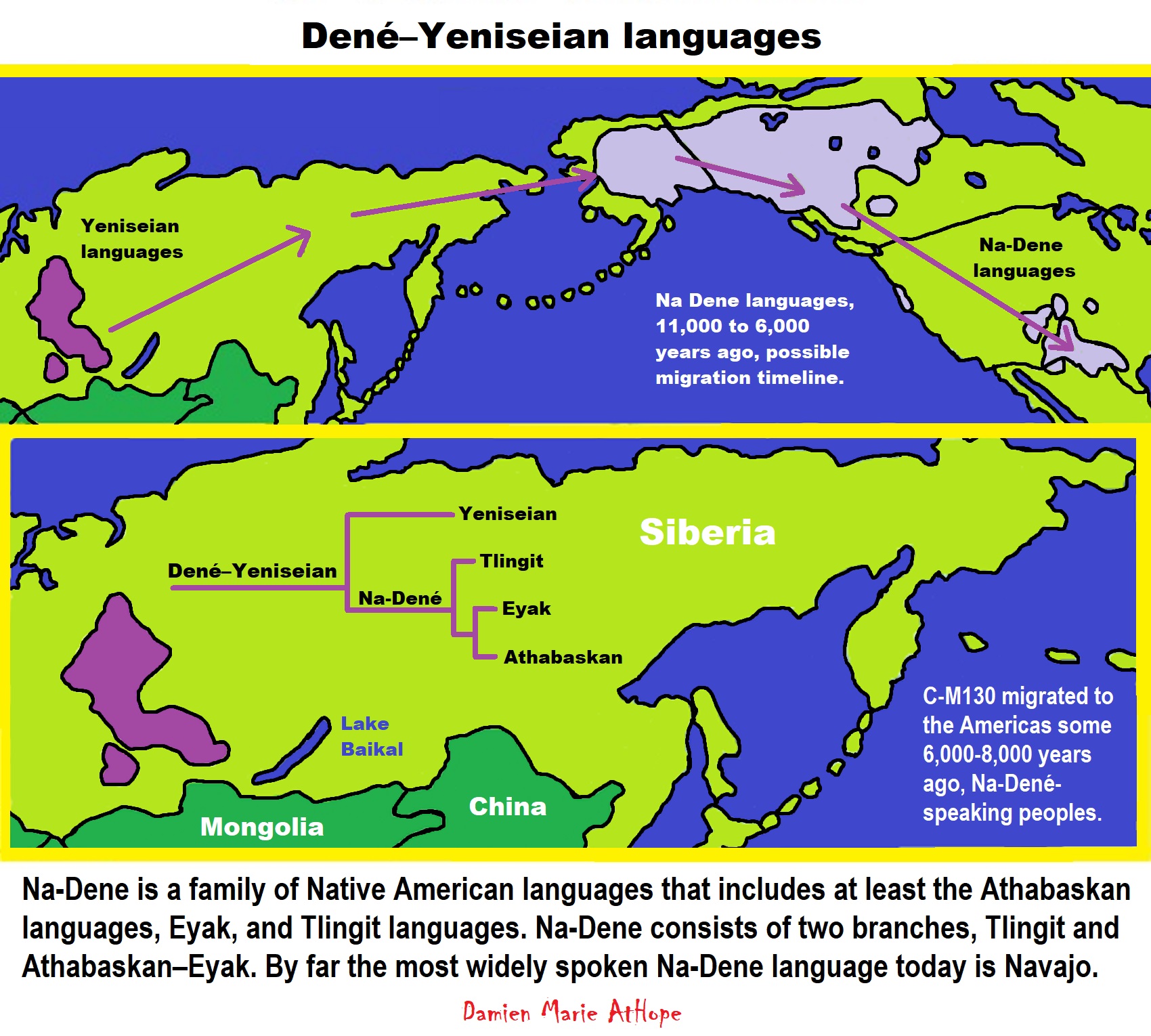
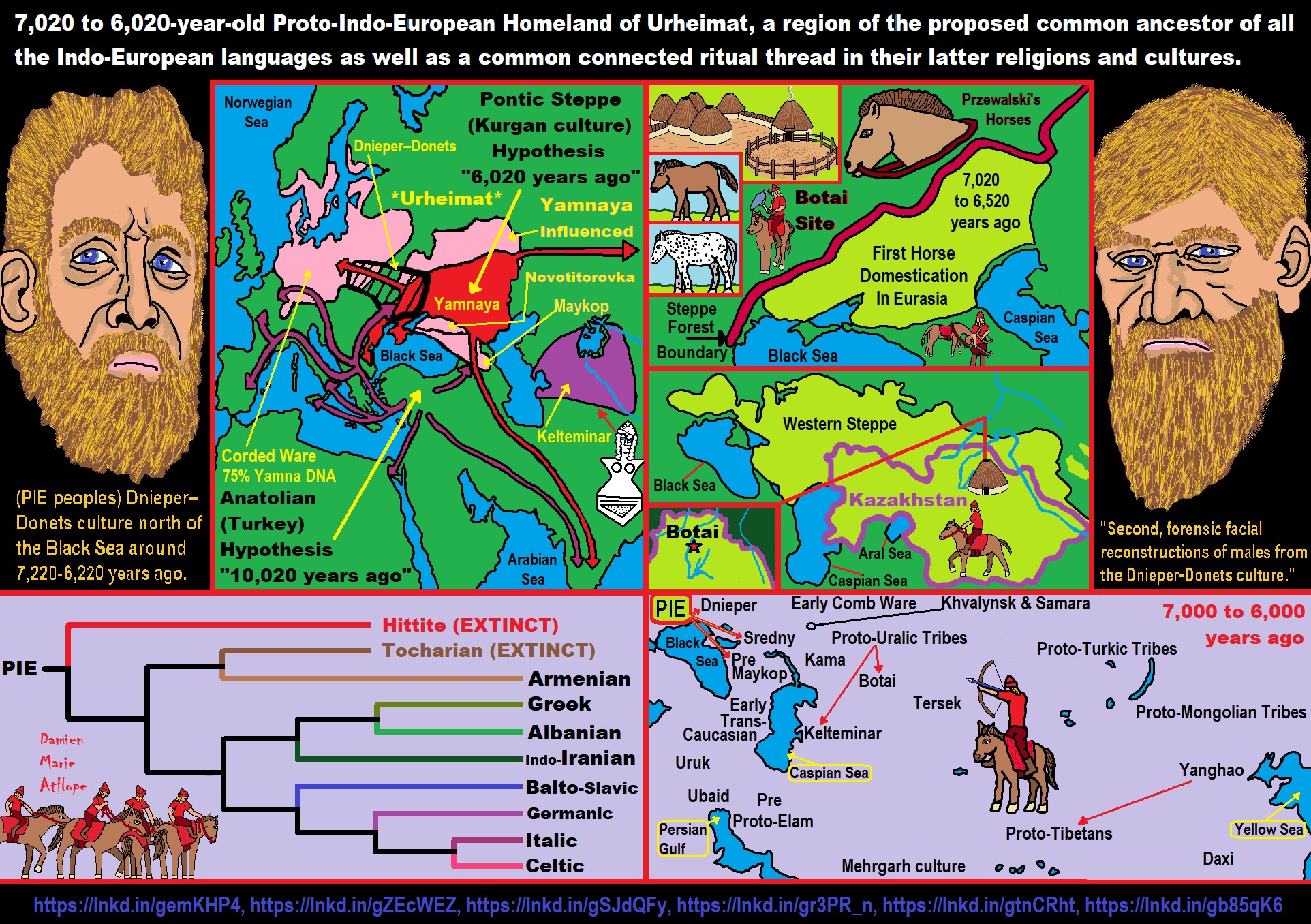
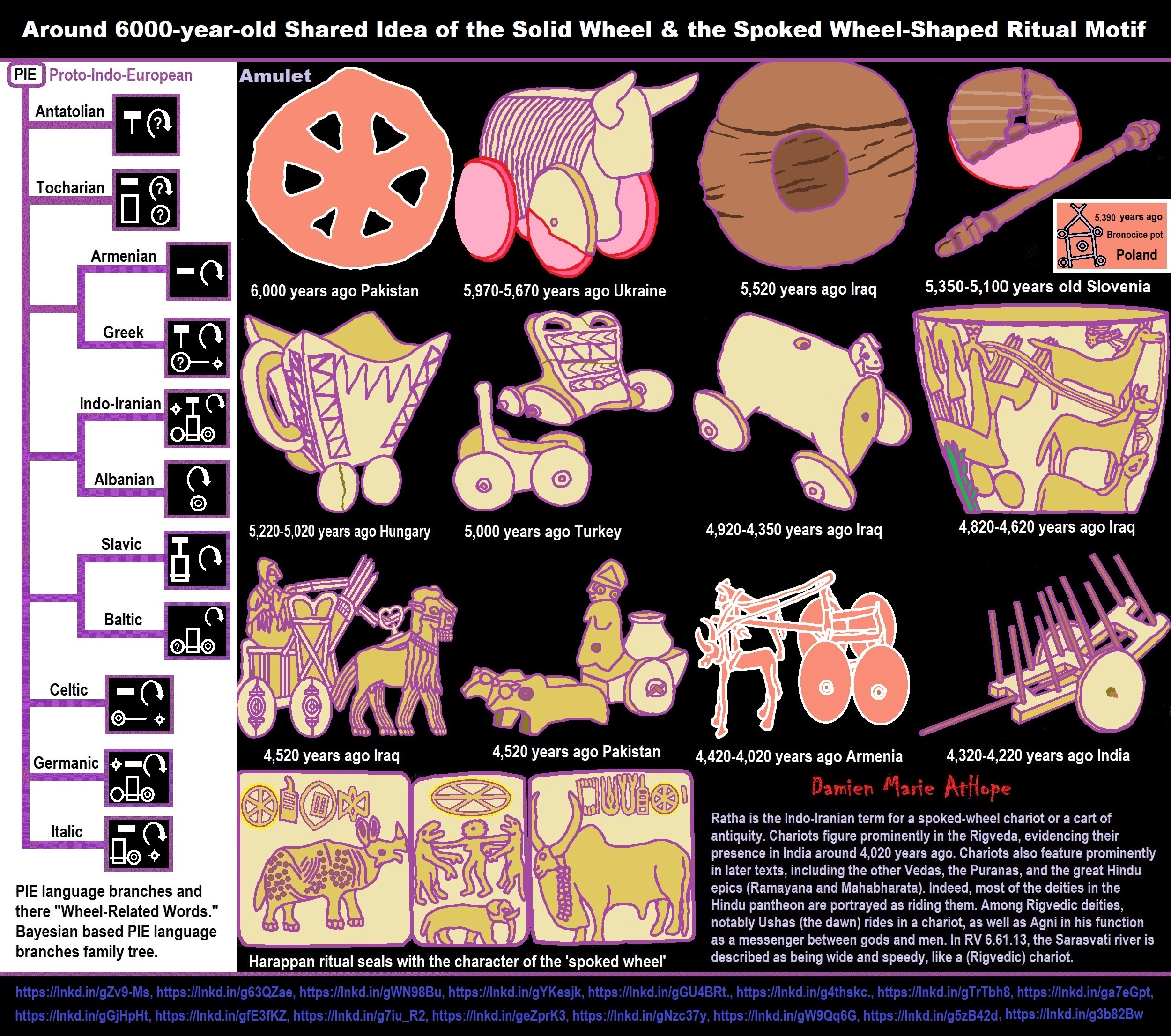
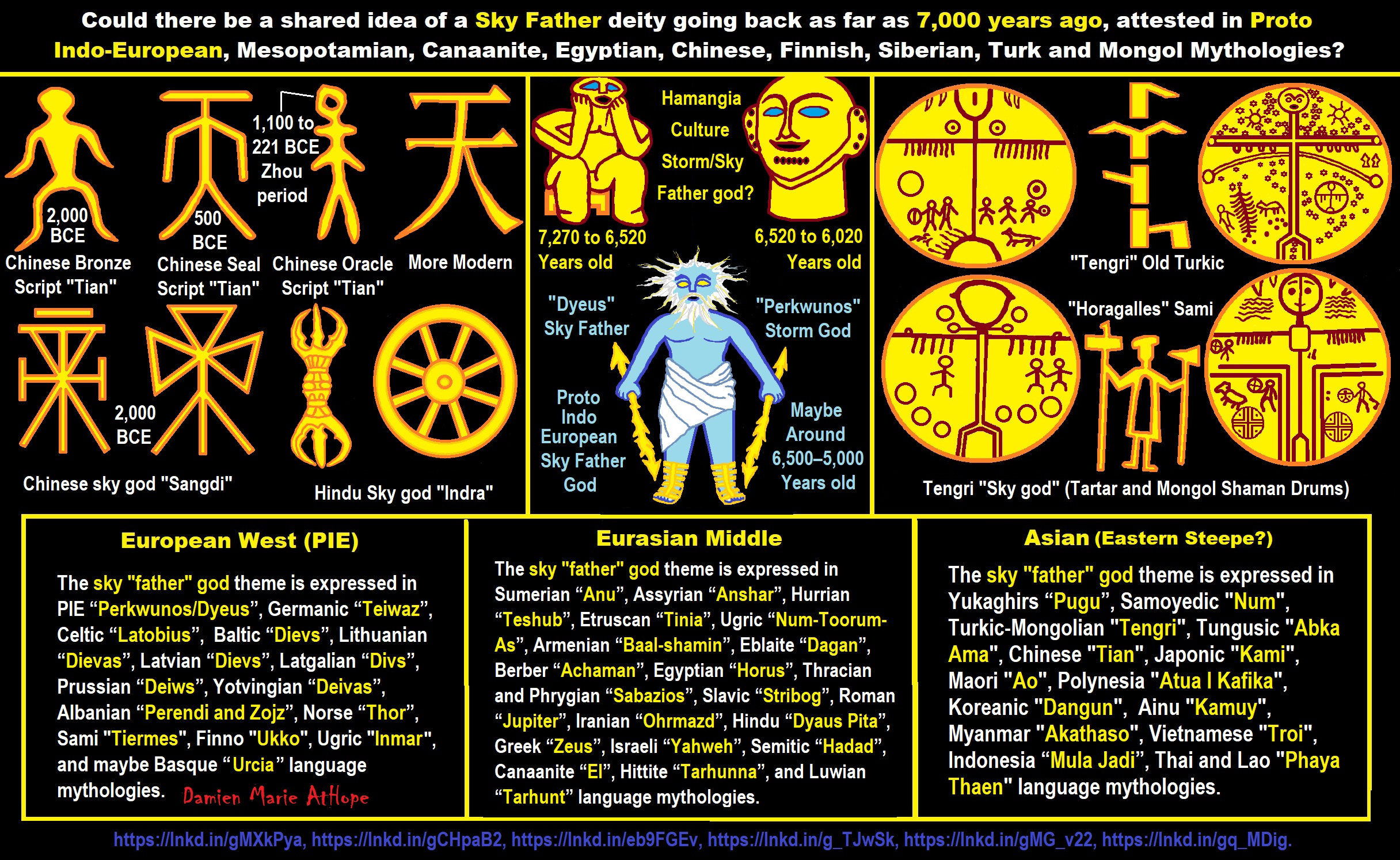
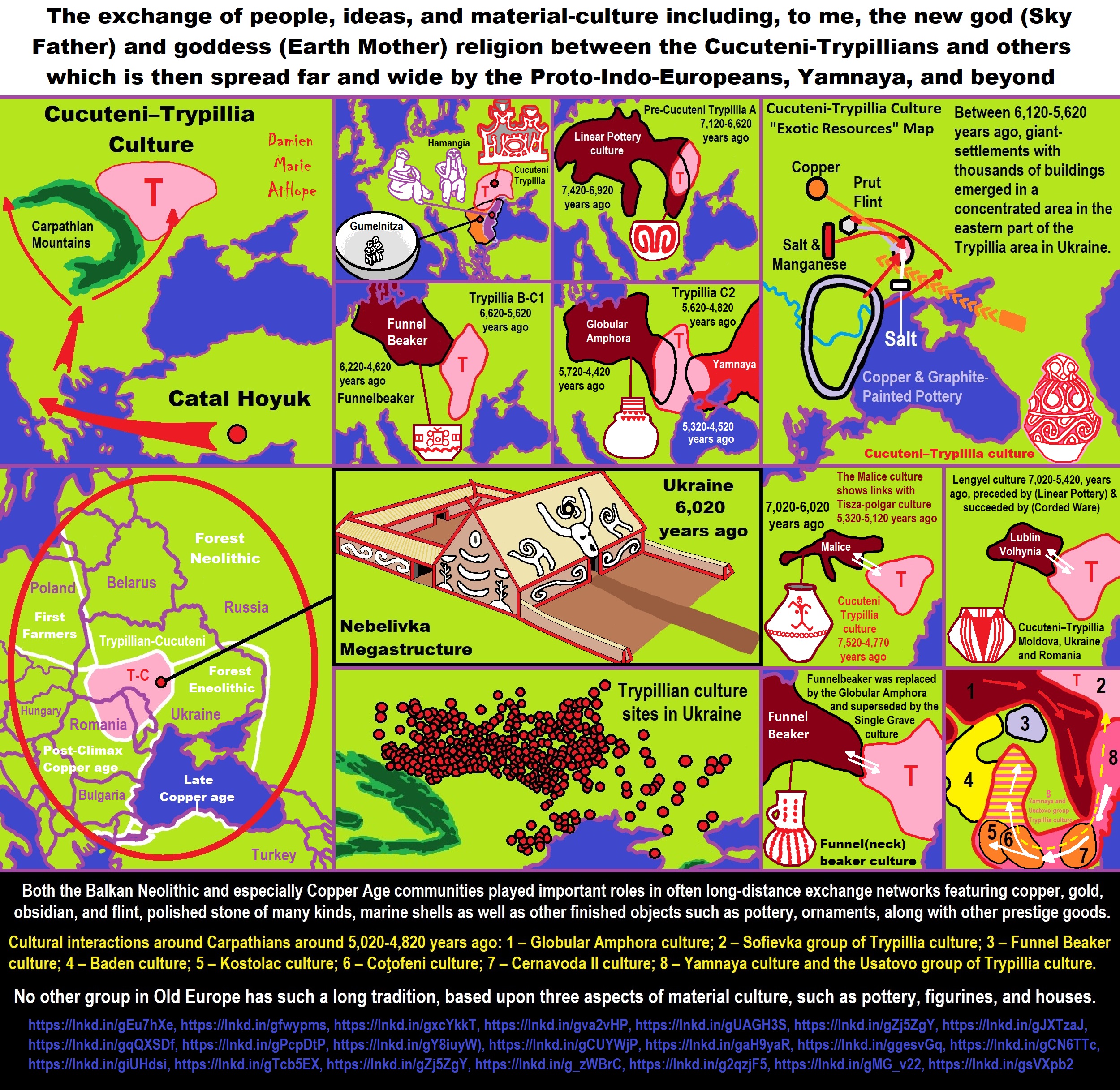
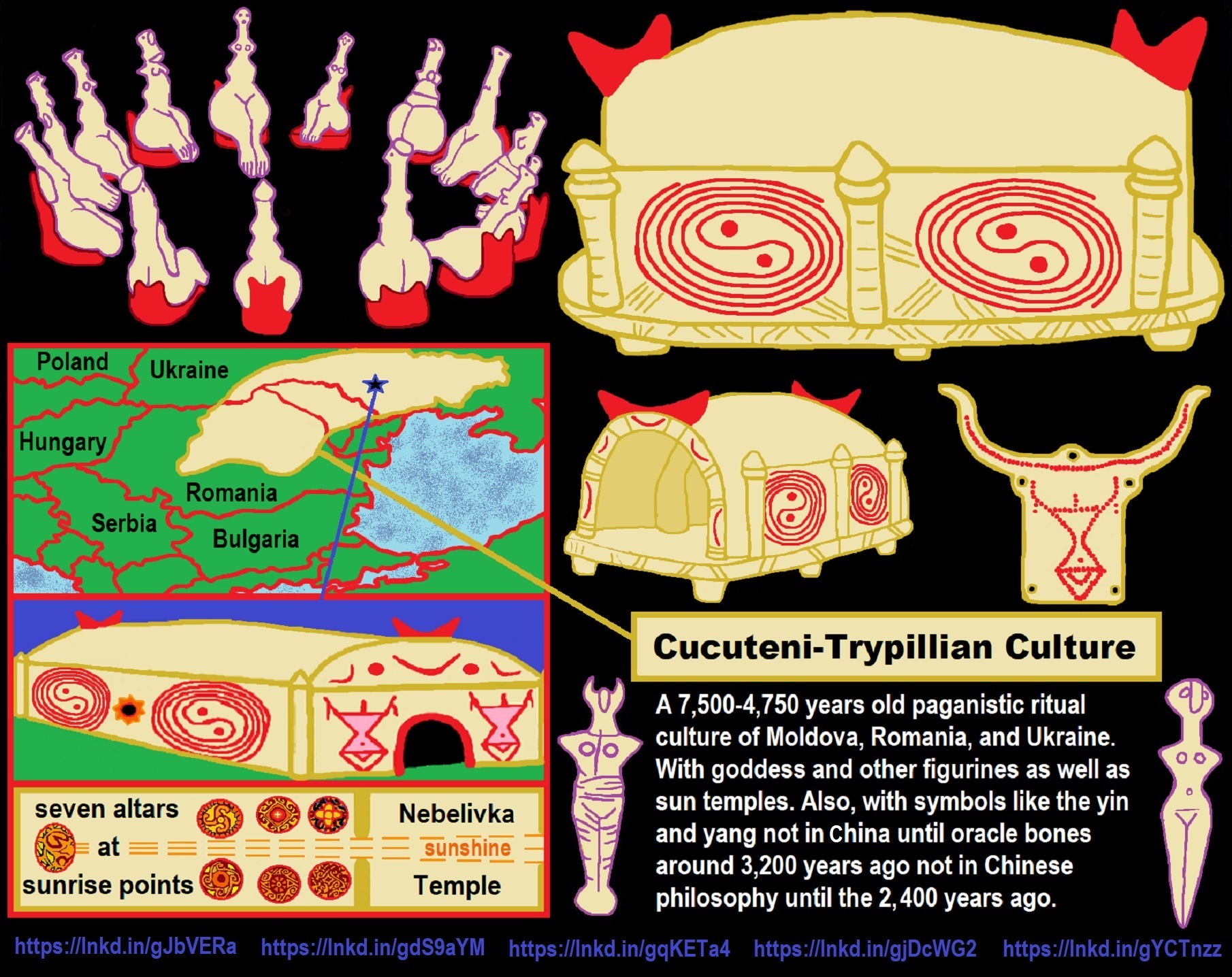
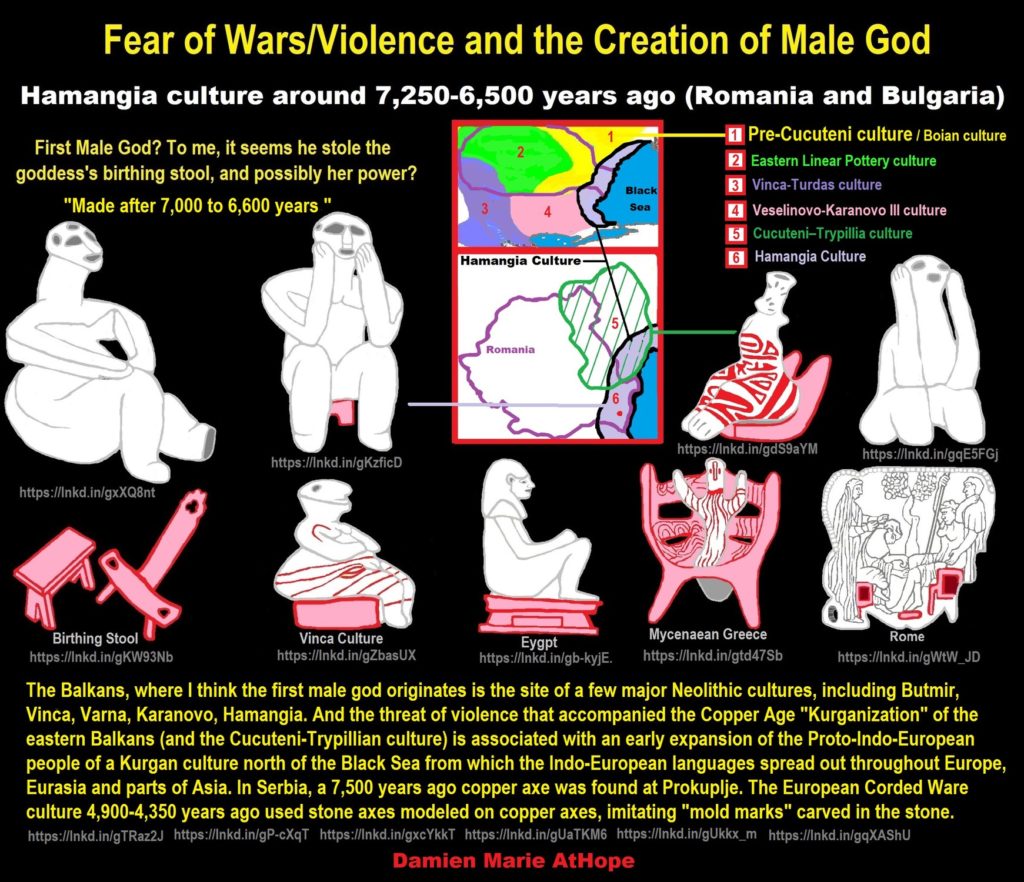
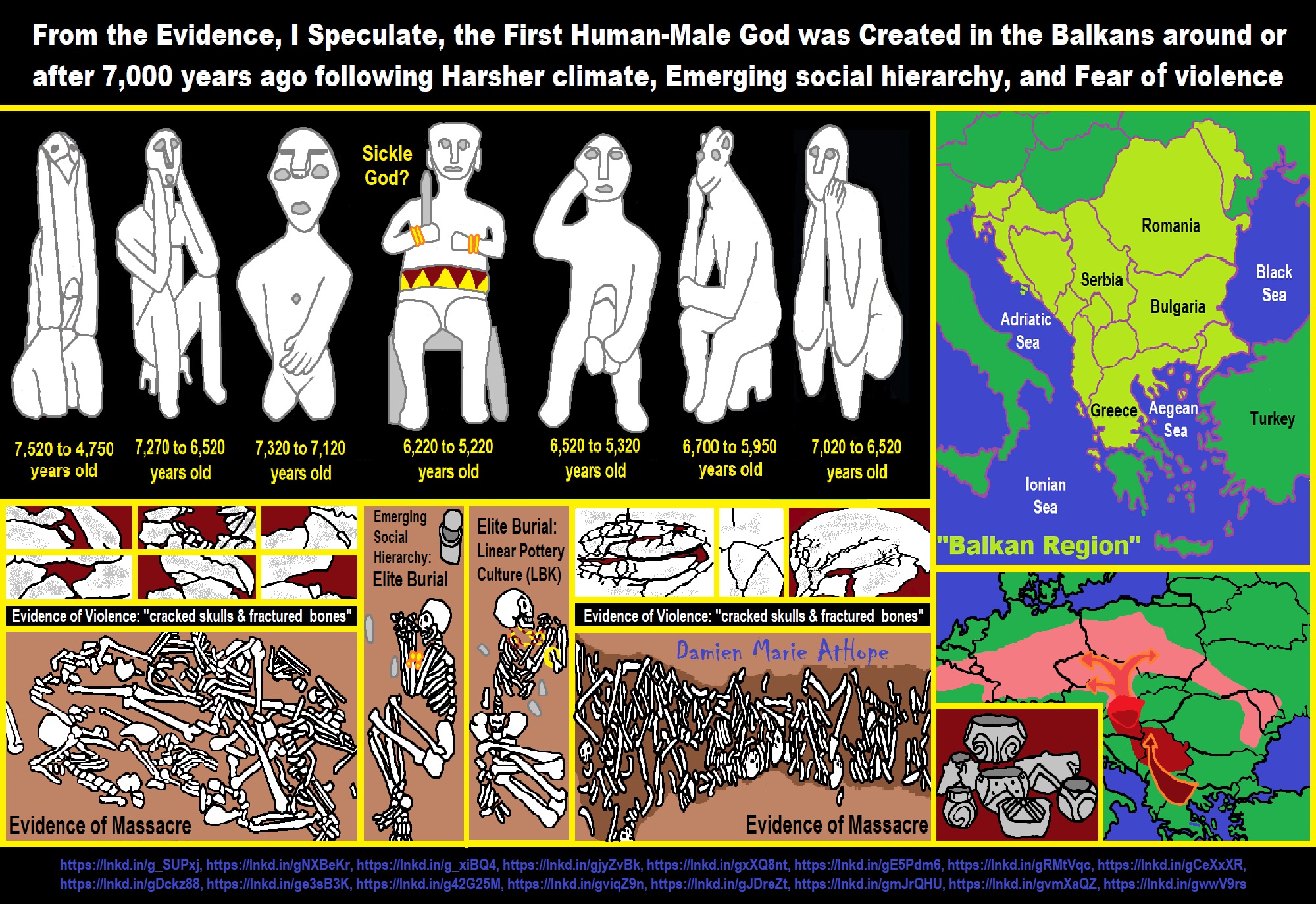
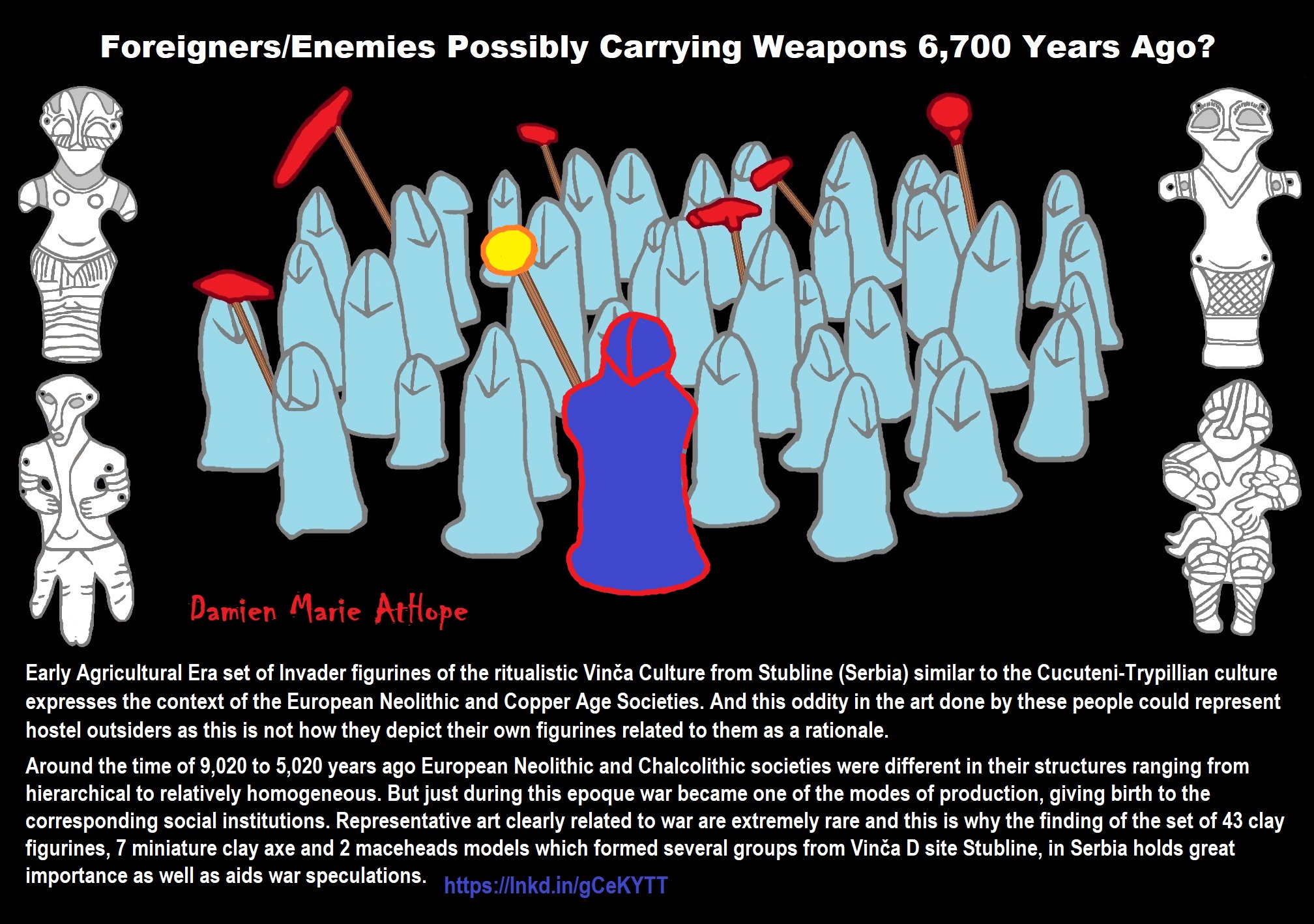
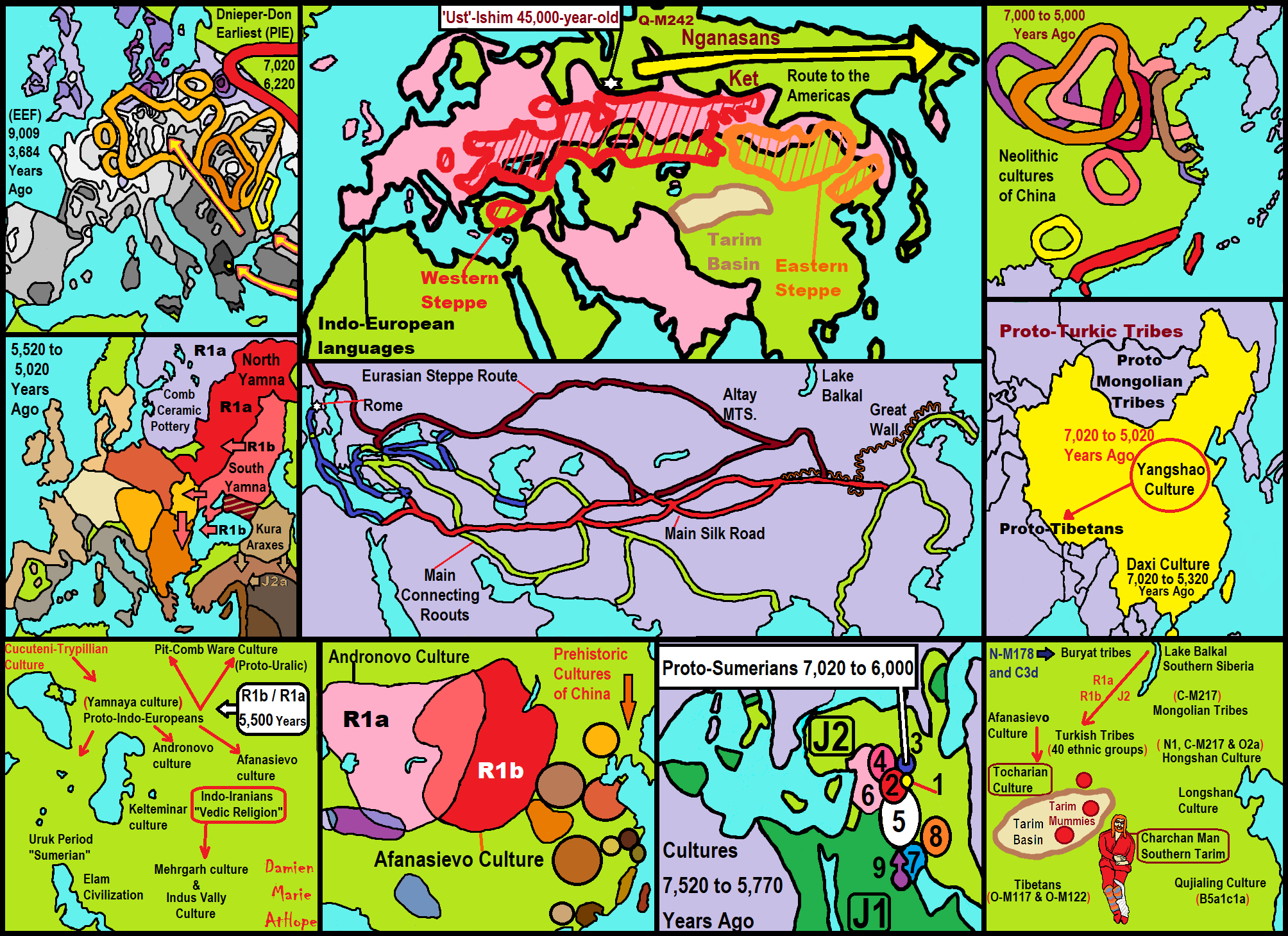
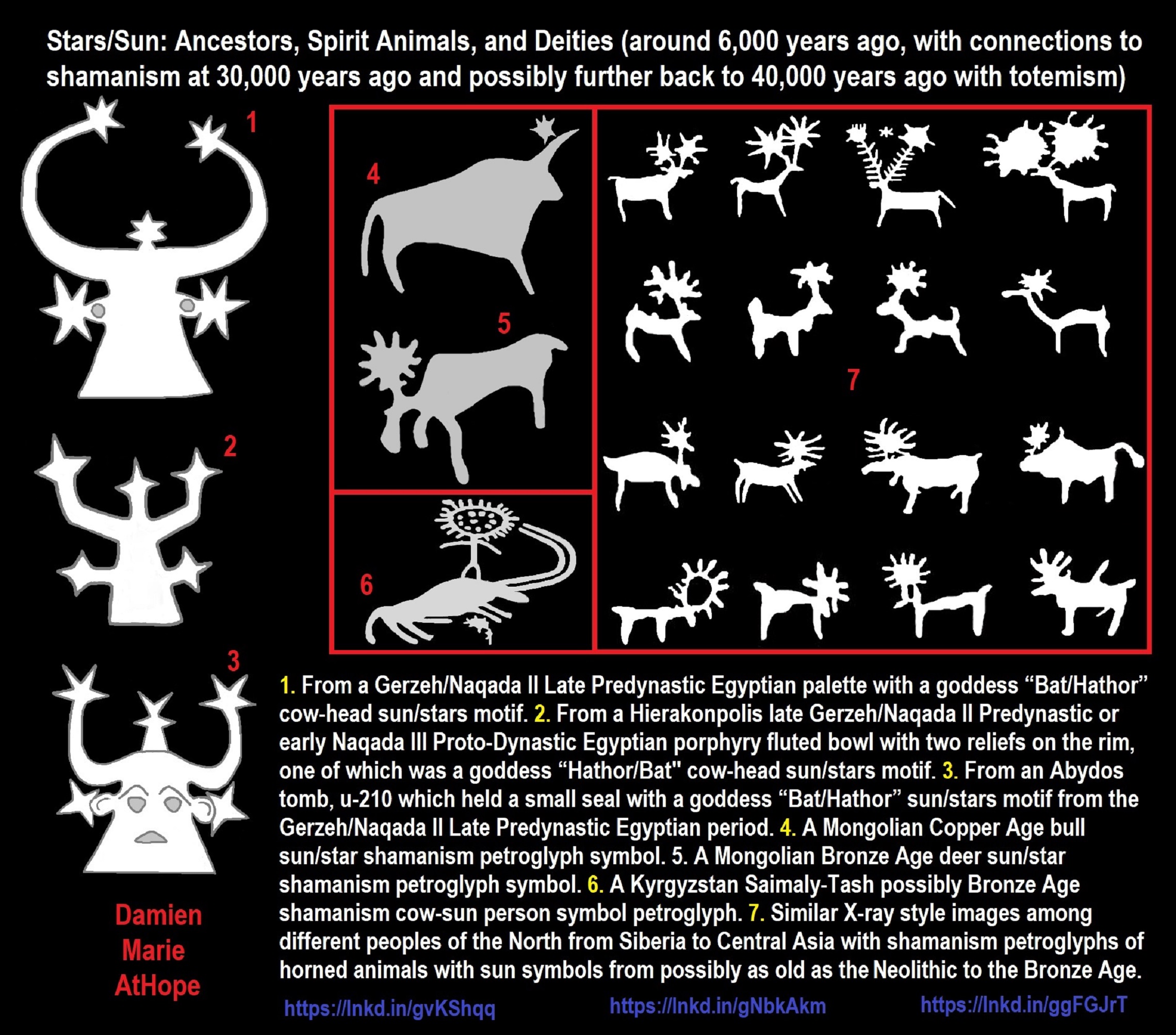
- From a Gerzeh/Naqada II Late Predynastic Egyptian palette with a goddess “Bat/Hathor” cow-head sun/stars motif.
- From a Hierakonpolis late Gerzeh/Naqada II Predynastic or early Naqada III Proto-Dynastic Egyptian porphyry fluted bowl with two reliefs on the rim, one of which was a goddess “Hathor/Bat” cow-head sun/stars motif.
- From an Abydos tomb, u-210 which held a small seal with a goddess “Bat/Hathor” sun/stars motif from the Gerzeh/Naqada II Late Predynastic Egyptian period.
- A Mongolian Copper Age bull sun/star shamanism petroglyph
- A Mongolian Bronze Age deer sun/star shamanism petroglyph symbol.
- A Kyrgyzstan Saimaly-Tash possibly Bronze Age shamanism cow-sun person symbol petroglyph.
- Similar X-ray style images among different peoples of the North from Siberia to Central Asia with shamanism petroglyphs of horned animals with sun symbols from possibly as old as the Neolithic to the Bronze Age. ref, ref, ref
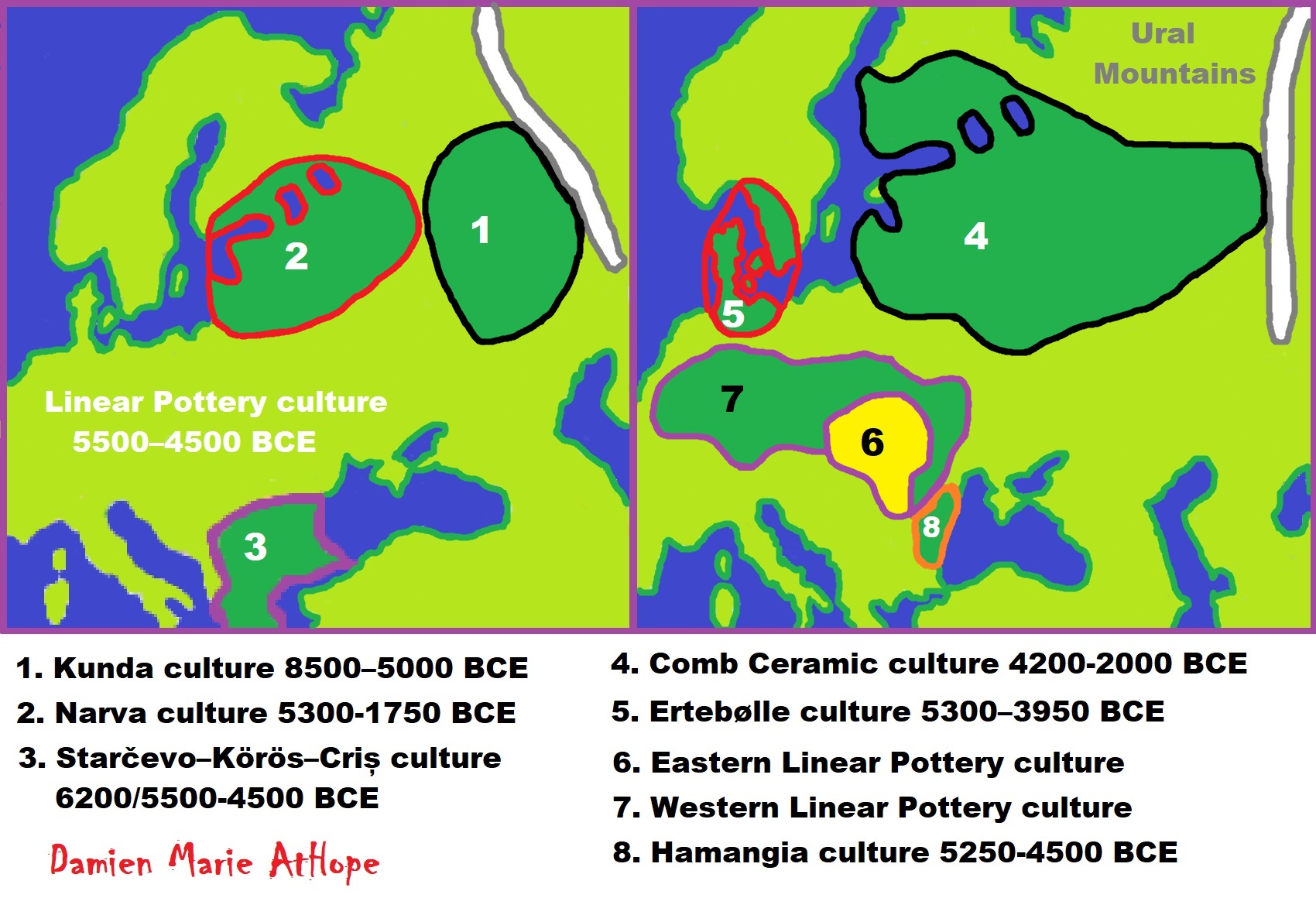
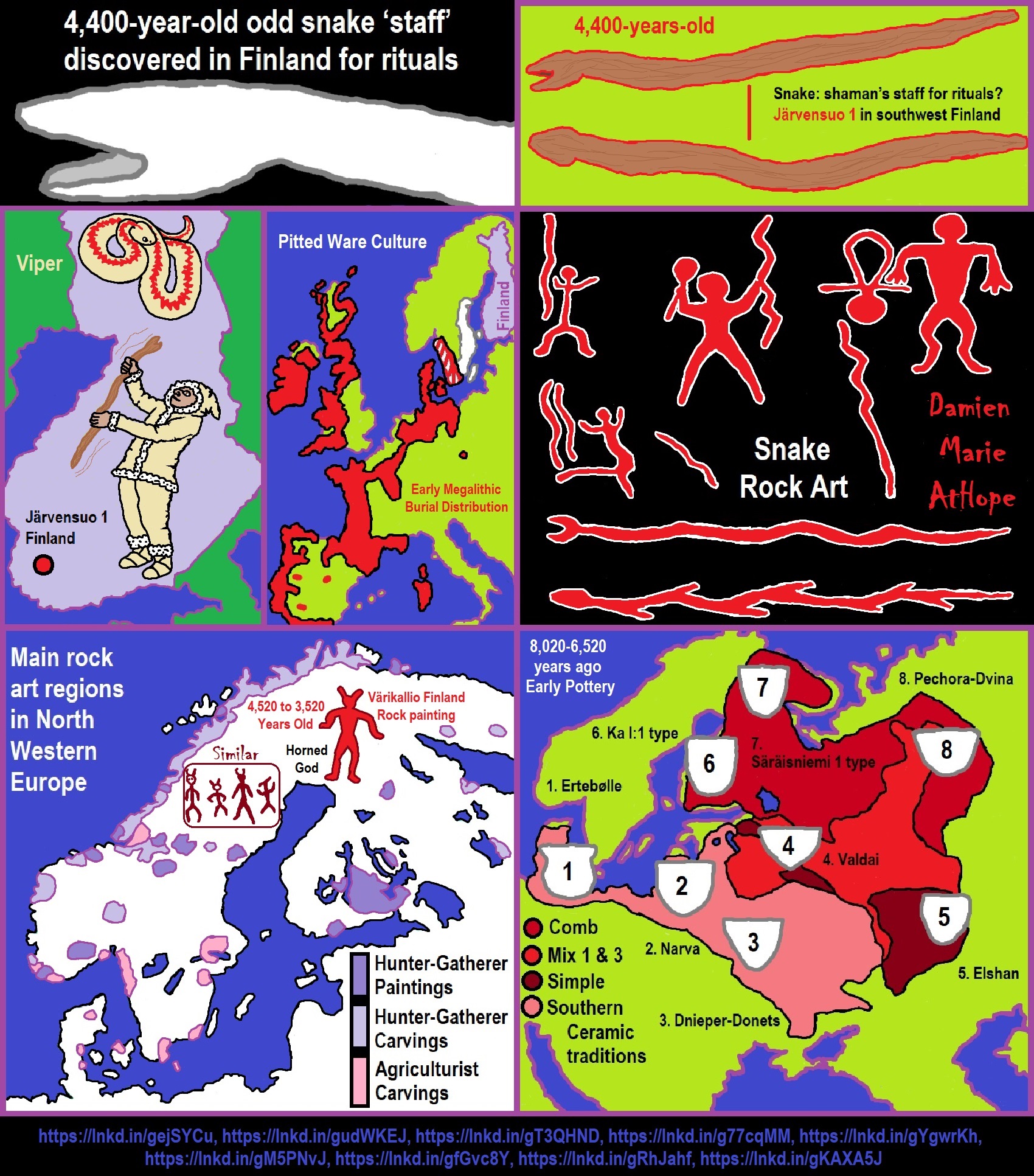
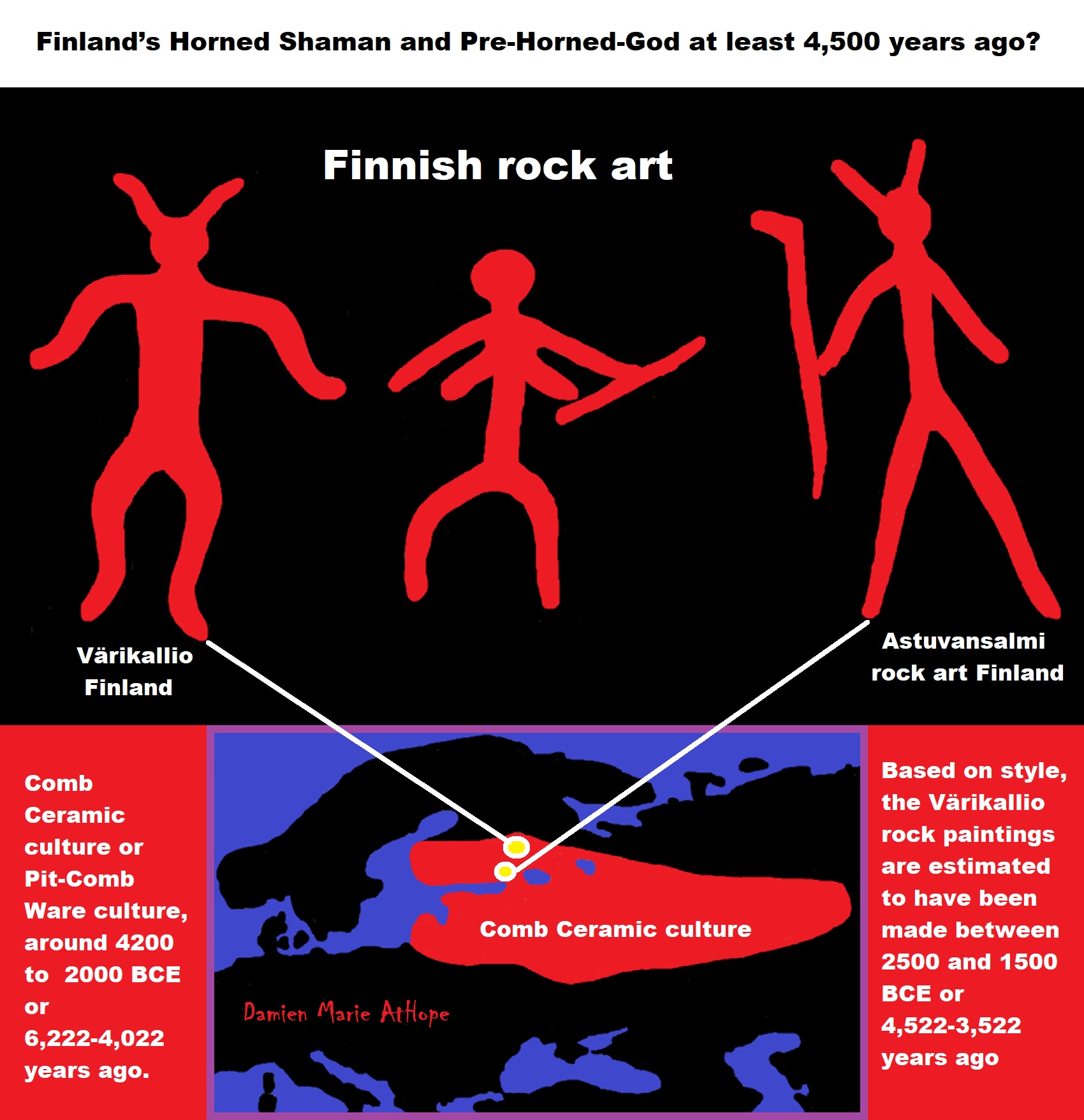
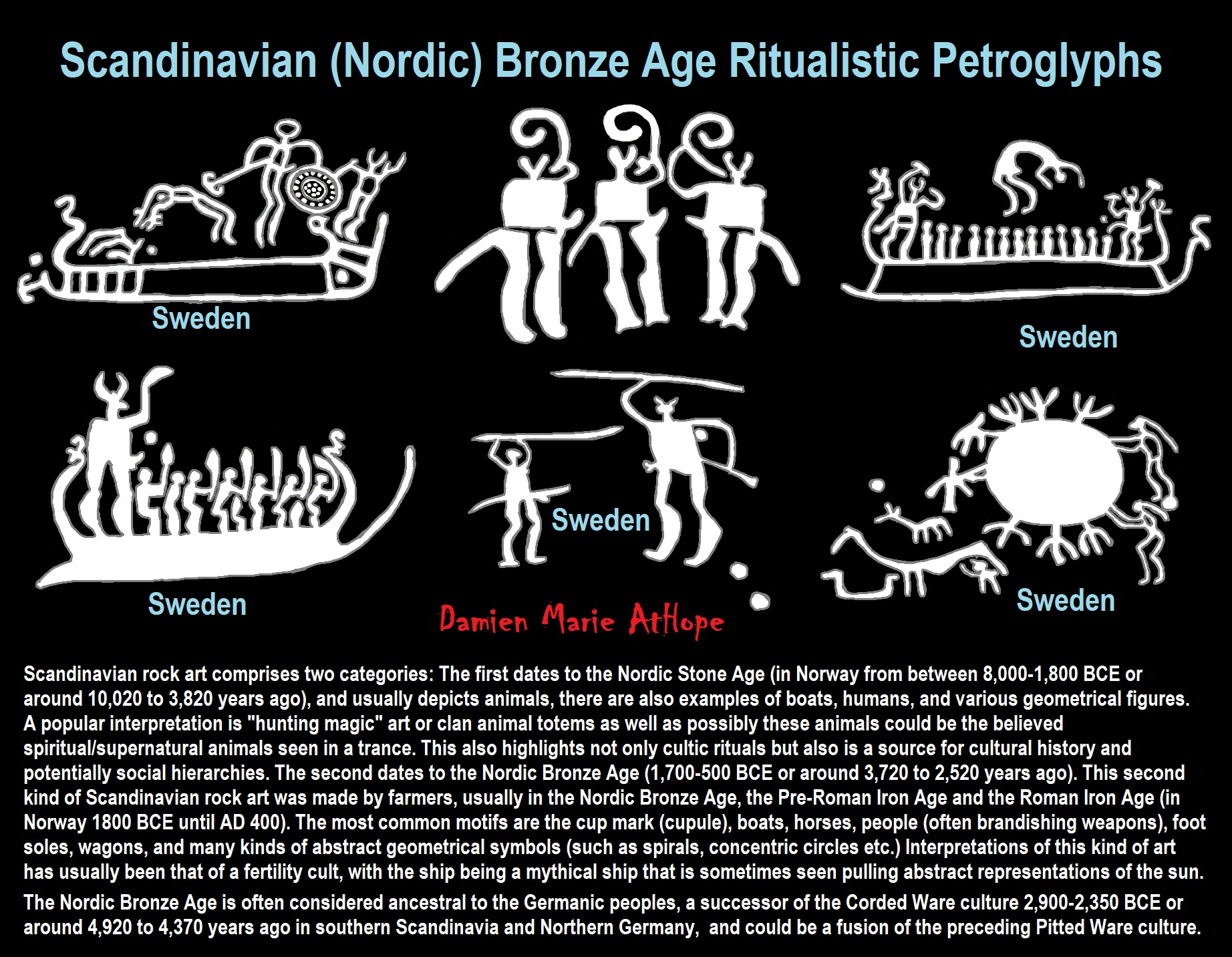
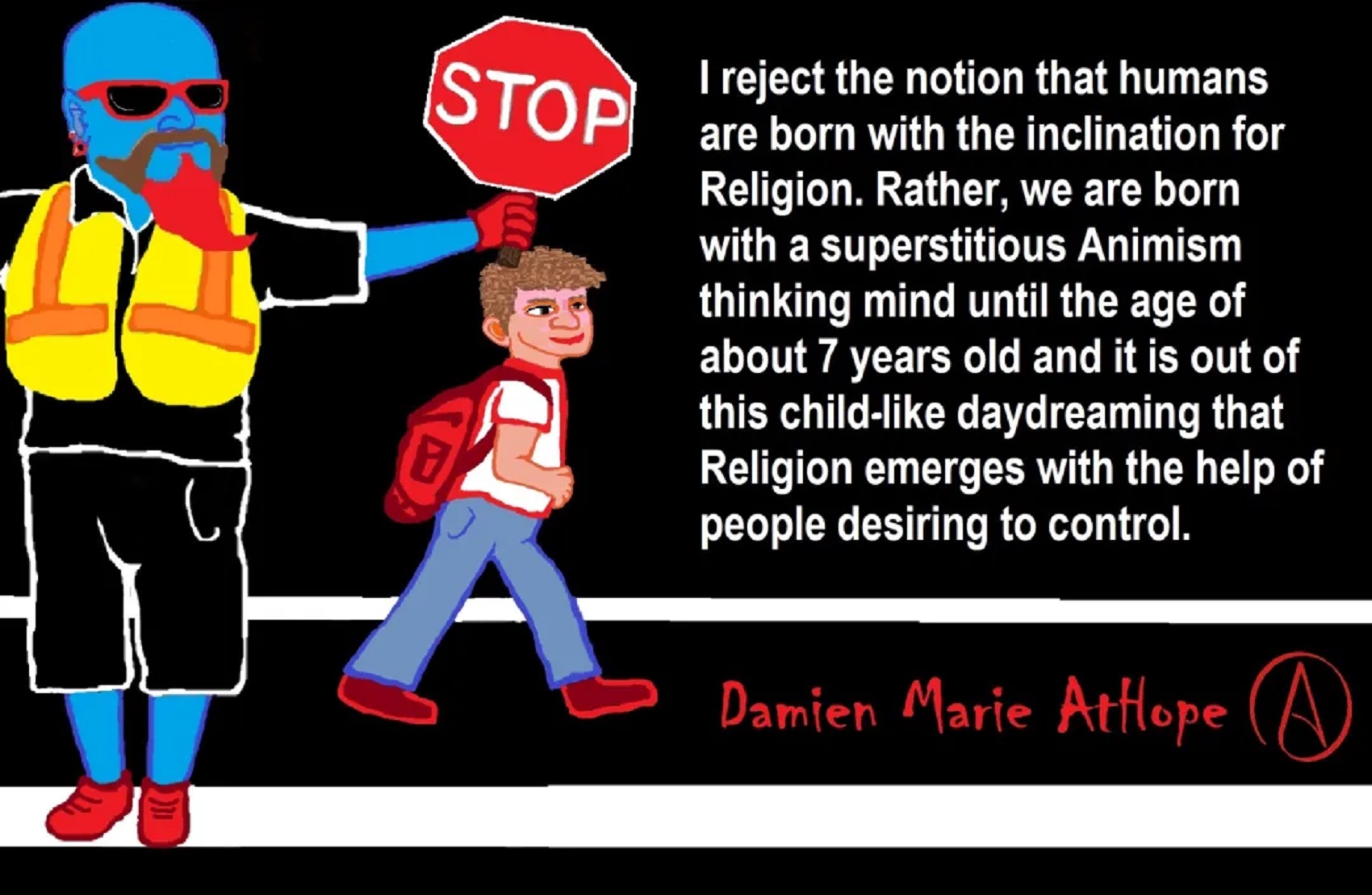
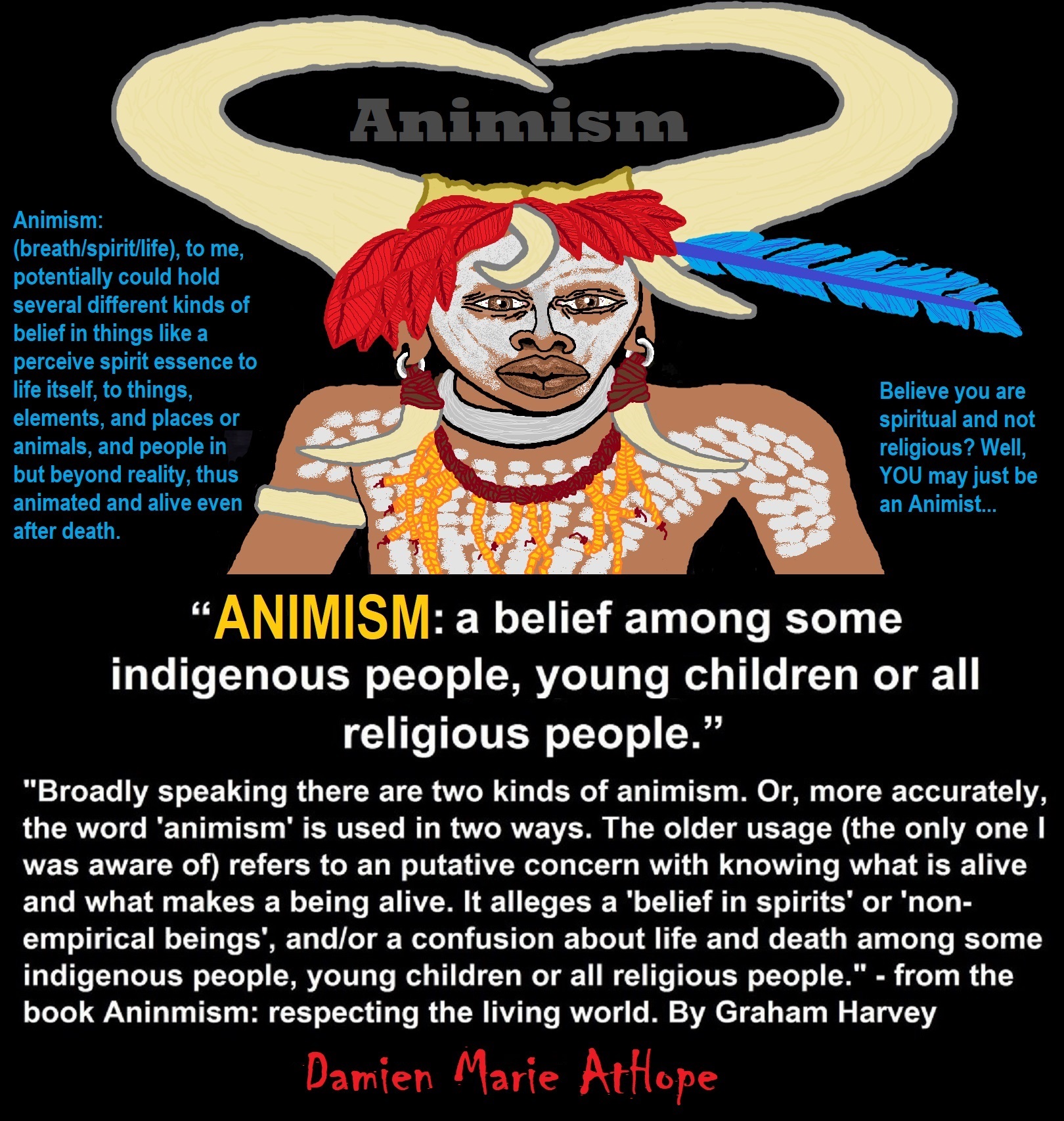
Animism: Respecting the Living World by Graham Harvey
“How have human cultures engaged with and thought about animals, plants, rocks, clouds, and other elements in their natural surroundings? Do animals and other natural objects have a spirit or soul? What is their relationship to humans? In this new study, Graham Harvey explores current and past animistic beliefs and practices of Native Americans, Maori, Aboriginal Australians, and eco-pagans. He considers the varieties of animism found in these cultures as well as their shared desire to live respectfully within larger natural communities. Drawing on his extensive casework, Harvey also considers the linguistic, performative, ecological, and activist implications of these different animisms.” ref
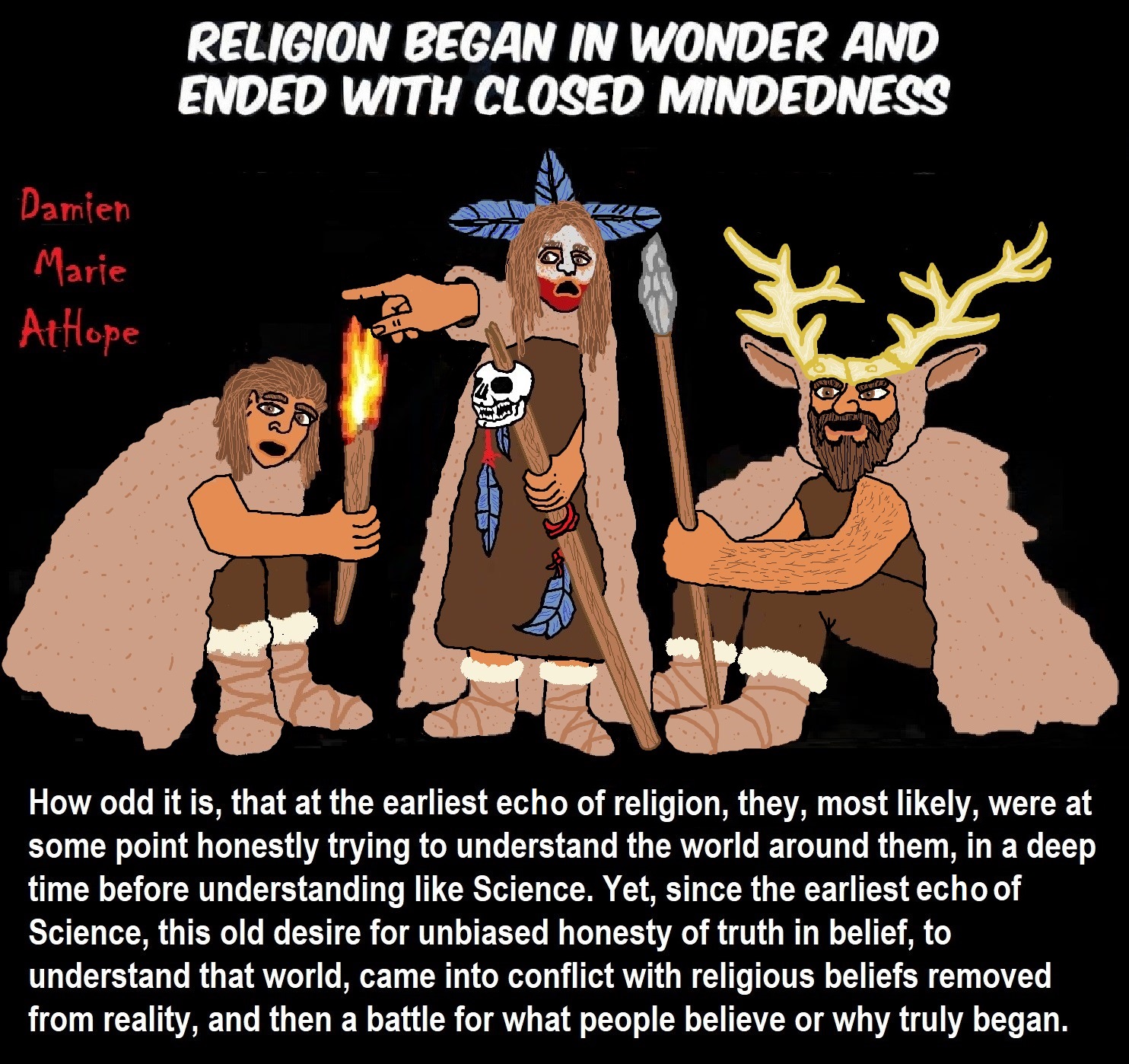
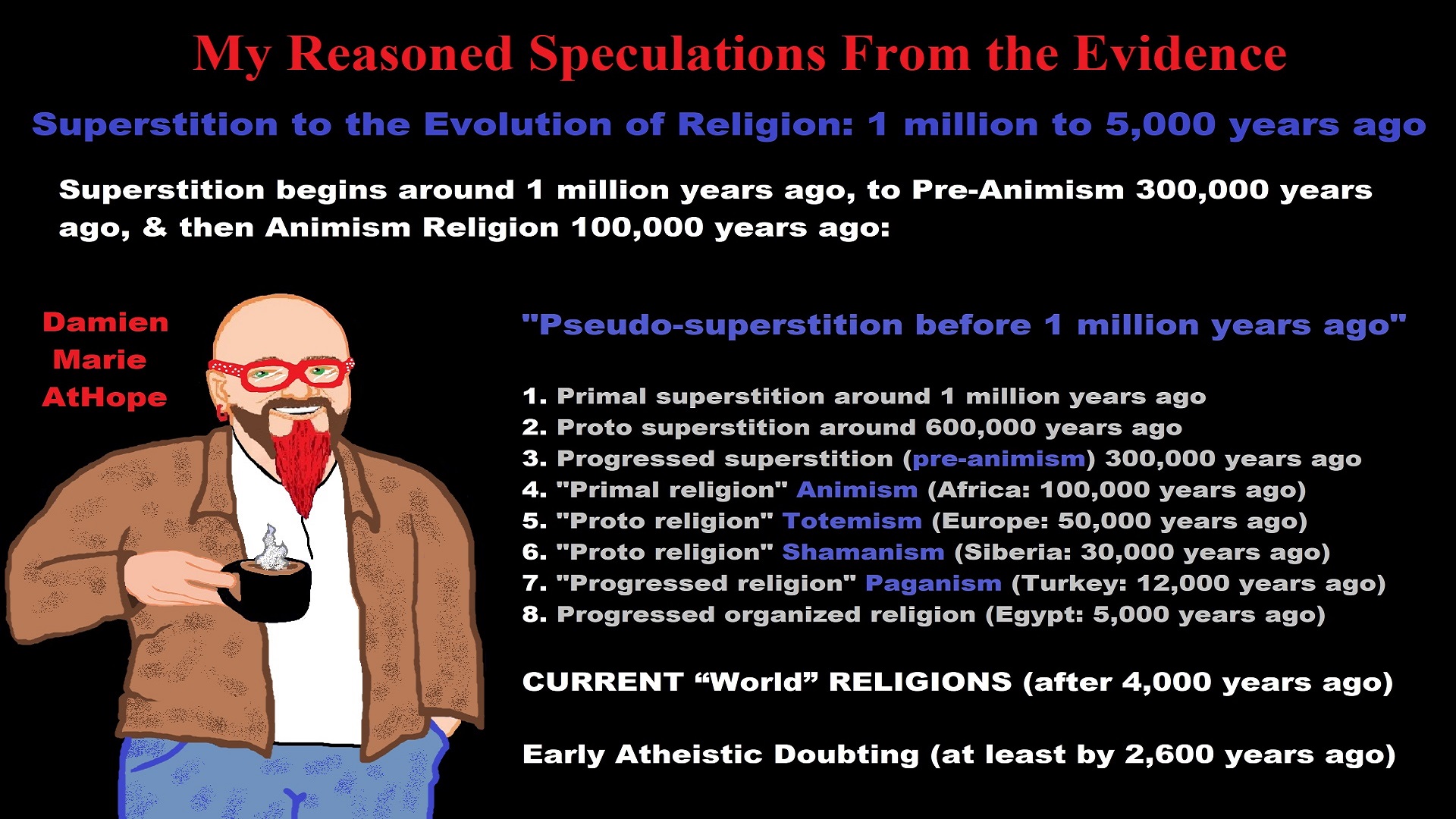
My thoughts on Religion Evolution with external links for more info:
- (Pre-Animism Africa mainly, but also Europe, and Asia at least 300,000 years ago), (Pre-Animism – Oxford Dictionaries)
- (Animism Africa around 100,000 years ago), (Animism – Britannica.com)
- (Totemism Europe around 50,000 years ago), (Totemism – Anthropology)
- (Shamanism Siberia around 30,000 years ago), (Shamanism – Britannica.com)
- (Paganism Turkey around 12,000 years ago), (Paganism – BBC Religion)
- (Progressed Organized Religion “Institutional Religion” Egypt around 5,000 years ago), (Ancient Egyptian Religion – Britannica.com)
- (CURRENT “World” RELIGIONS after 4,000 years ago) (Origin of Major Religions – Sacred Texts)
- (Early Atheistic Doubting at least by 2,600 years ago) (History of Atheism – Wikipedia)
“Religion is an Evolved Product” and Yes, Religion is Like Fear Given Wings…
Atheists talk about gods and religions for the same reason doctors talk about cancer, they are looking for a cure, or a firefighter talks about fires because they burn people and they care to stop them. We atheists too often feel a need to help the victims of mental slavery, held in the bondage that is the false beliefs of gods and the conspiracy theories of reality found in religions.
Understanding Religion Evolution:
- Pre-Animism (at least 300,000 years ago)
- Animism (Africa: 100,000 years ago)
- Totemism (Europe: 50,000 years ago)
- Shamanism (Siberia: 30,000 years ago)
- Paganism (Turkey: 12,000 years ago)
- Progressed organized religion (Egypt: 5,000 years ago), (Egypt, the First Dynasty 5,150 years ago)
- CURRENT “World” RELIGIONS (after 4,000 years ago)
- Early Atheistic Doubting (at least by 2,600 years ago)
“An Archaeological/Anthropological Understanding of Religion Evolution”
It seems ancient peoples had to survived amazing threats in a “dangerous universe (by superstition perceived as good and evil),” and human “immorality or imperfection of the soul” which was thought to affect the still living, leading to ancestor worship. This ancestor worship presumably led to the belief in supernatural beings, and then some of these were turned into the belief in gods. This feeble myth called gods were just a human conceived “made from nothing into something over and over, changing, again and again, taking on more as they evolve, all the while they are thought to be special,” but it is just supernatural animistic spirit-belief perceived as sacred.
Quick Evolution of Religion?
Pre-Animism (at least 300,000 years ago) pre-religion is a beginning that evolves into later Animism. So, Religion as we think of it, to me, all starts in a general way with Animism (Africa: 100,000 years ago) (theoretical belief in supernatural powers/spirits), then this is physically expressed in or with Totemism (Europe: 50,000 years ago) (theoretical belief in mythical relationship with powers/spirits through a totem item), which then enlists a full-time specific person to do this worship and believed interacting Shamanism (Siberia/Russia: 30,000 years ago) (theoretical belief in access and influence with spirits through ritual), and then there is the further employment of myths and gods added to all the above giving you Paganism (Turkey: 12,000 years ago) (often a lot more nature-based than most current top world religions, thus hinting to their close link to more ancient religious thinking it stems from). My hypothesis is expressed with an explanation of the building of a theatrical house (modern religions development). Progressed organized religion (Egypt: 5,000 years ago) with CURRENT “World” RELIGIONS (after 4,000 years ago).
Historically, in large city-state societies (such as Egypt or Iraq) starting around 5,000 years ago culminated to make religion something kind of new, a sociocultural-governmental-religious monarchy, where all or at least many of the people of such large city-state societies seem familiar with and committed to the existence of “religion” as the integrated life identity package of control dynamics with a fixed closed magical doctrine, but this juggernaut integrated religion identity package of Dogmatic-Propaganda certainly did not exist or if developed to an extent it was highly limited in most smaller prehistoric societies as they seem to lack most of the strong control dynamics with a fixed closed magical doctrine (magical beliefs could be at times be added or removed). Many people just want to see developed religious dynamics everywhere even if it is not. Instead, all that is found is largely fragments until the domestication of religion.
Religions, as we think of them today, are a new fad, even if they go back to around 6,000 years in the timeline of human existence, this amounts to almost nothing when seen in the long slow evolution of religion at least around 70,000 years ago with one of the oldest ritual worship. Stone Snake of South Africa: “first human worship” 70,000 years ago. This message of how religion and gods among them are clearly a man-made thing that was developed slowly as it was invented and then implemented peace by peace discrediting them all. Which seems to be a simple point some are just not grasping how devastating to any claims of truth when we can see the lie clearly in the archeological sites.
I wish people fought as hard for the actual values as they fight for the group/clan names political or otherwise they think support values. Every amount spent on war is theft to children in need of food or the homeless kept from shelter.
Here are several of my blog posts on history:
- To Find Truth You Must First Look
- (Magdalenian/Iberomaurusian) Connections to the First Paganists of the early Neolithic Near East Dating from around 17,000 to 12,000 Years Ago
- Natufians: an Ancient People at the Origins of Agriculture and Sedentary Life
- Possible Clan Leader/Special “MALE” Ancestor Totem Poles At Least 13,500 years ago?
- Jewish People with DNA at least 13,200 years old, Judaism, and the Origins of Some of its Ideas
- Baltic Reindeer Hunters: Swiderian, Lyngby, Ahrensburgian, and Krasnosillya cultures 12,020 to 11,020 years ago are evidence of powerful migratory waves during the last 13,000 years and a genetic link to Saami and the Finno-Ugric peoples.
- The Rise of Inequality: patriarchy and state hierarchy inequality
- Fertile Crescent 12,500 – 9,500 Years Ago: fertility and death cult belief system?
- 12,400 – 11,700 Years Ago – Kortik Tepe (Turkey) Pre/early-Agriculture Cultic Ritualism
- Ritualistic Bird Symbolism at Gobekli Tepe and its “Ancestor Cult”
- Male-Homosexual (female-like) / Trans-woman (female) Seated Figurine from Gobekli Tepe
- Could a 12,000-year-old Bull Geoglyph at Göbekli Tepe relate to older Bull and Female Art 25,000 years ago and Later Goddess and the Bull cults like Catal Huyuk?
- Sedentism and the Creation of goddesses around 12,000 years ago as well as male gods after 7,000 years ago.
- Alcohol, where Agriculture and Religion Become one? Such as Gobekli Tepe’s Ritualistic use of Grain as Food and Ritual Drink
- Neolithic Ritual Sites with T-Pillars and other Cultic Pillars
- Paganism: Goddesses around 12,000 years ago then Male Gods after 7,000 years ago
- First Patriarchy: Split of Women’s Status around 12,000 years ago & First Hierarchy: fall of Women’s Status around 5,000 years ago.
- Natufians: an Ancient People at the Origins of Agriculture and Sedentary Life
- J DNA and the Spread of Agricultural Religion (paganism)
- Paganism: an approximately 12,000-year-old belief system
- Paganism 12,000 years old: related to “Anarchism and Socialism” (Pre-Capitalism)
- Shaman burial in Israel 12,000 years ago and the Shamanism Phenomena
- Need to Mythicized: gods and goddesses
- 12,000 – 7,000 Years Ago – Paleo-Indian Culture (The Americas)
- 12,000 – 2,000 Years Ago – Indigenous-Scandinavians (Nordic)
- Norse did not wear helmets with horns?
- Pre-Pottery Neolithic Skull Cult around 11,500 to 8,400 Years Ago?
- 10,400 – 10,100 Years Ago, in Turkey the Nevail Cori Religious Settlement
- 9,000-6,500 Years Old Submerged Pre-Pottery/Pottery Neolithic Ritual Settlements off Israel’s Coast
- Catal Huyuk “first religious designed city” around 9,500 to 7,700 years ago (Turkey)
- Cultic Hunting at Catal Huyuk “first religious designed city”
- Special Items and Art as well as Special Elite Burials at Catal Huyuk
- New Rituals and Violence with the appearance of Pottery and People?
- Haplogroup N and its related Uralic Languages and Cultures
- Ainu people, Sámi people, Native Americans, the Ancient North Eurasians, and Paganistic-Shamanism with Totemism
- Ideas, Technology and People from Turkey, Europe, to China and Back again 9,000 to 5,000 years ago?
- First Pottery of Europe and the Related Cultures
- 9,000 years old Neolithic Artifacts Judean Desert and Hills Israel
- 9,000-7,000 years-old Sex and Death Rituals: Cult Sites in Israel, Jordan, and the Sinai
- 9,000-8500 year old Horned Female shaman Bad Dürrenberg Germany
- Neolithic Jewelry and the Spread of Farming in Europe Emerging out of West Turkey
- 8,600-year-old Tortoise Shells in Neolithic graves in central China have Early Writing and Shamanism
- Swing of the Mace: the rise of Elite, Forced Authority, and Inequality begin to Emerge 8,500 years ago?
- Migrations and Changing Europeans Beginning around 8,000 Years Ago
- My “Steppe-Anatolian-Kurgan hypothesis” 8,000/7,000 years ago
- Around 8,000-year-old Shared Idea of the Mistress of Animals, “Ritual” Motif
- Pre-Columbian Red-Paint (red ochre) Maritime Archaic Culture 8,000-3,000 years ago
- 7,522-6,522 years ago Linear Pottery culture which I think relates to Arcane Capitalism’s origins
- Arcane Capitalism: Primitive socialism, Primitive capital, Private ownership, Means of production, Market capitalism, Class discrimination, and Petite bourgeoisie (smaller capitalists)
- 7,500-4,750 years old Ritualistic Cucuteni-Trypillian culture of Moldova, Romania, and Ukraine
- Roots of a changing early society 7,200-6,700 years ago Jordan and Israel
- Agriculture religion (Paganism) with farming reached Britain between about 7,000 to 6,500 or so years ago and seemingly expressed in things like Western Europe’s Long Barrows
- My Thoughts on Possible Migrations of “R” DNA and Proto-Indo-European?
- “Millet” Spreading from China 7,022 years ago to Europe and related Language may have Spread with it leading to Proto-Indo-European
- Proto-Indo-European (PIE), ancestor of Indo-European languages: DNA, Society, Language, and Mythology
- The Dnieper–Donets culture and Asian varieties of Millet from China to the Black Sea region of Europe by 7,022 years ago
- Kurgan 6,000 years ago/dolmens 7,000 years ago: funeral, ritual, and other?
- 7,020 to 6,020-year-old Proto-Indo-European Homeland of Urheimat or proposed home of their Language and Religion
- Ancient Megaliths: Kurgan, Ziggurat, Pyramid, Menhir, Trilithon, Dolman, Kromlech, and Kromlech of Trilithons
- The Mytheme of Ancient North Eurasian Sacred-Dog belief and similar motifs are found in Indo-European, Native American, and Siberian comparative mythology
- Elite Power Accumulation: Ancient Trade, Tokens, Writing, Wealth, Merchants, and Priest-Kings
- Sacred Mounds, Mountains, Kurgans, and Pyramids may hold deep connections?
- Between 7,000-5,000 Years ago, rise of unequal hierarchy elite, leading to a “birth of the State” or worship of power, strong new sexism, oppression of non-elites, and the fall of Women’s equal status
- Paganism 7,000-5,000 years old: related to “Anarchism and Socialism” (Capitalism) (World War 0) Elite & their slaves
- Hell and Underworld mythologies starting maybe as far back as 7,000 to 5,000 years ago with the Proto-Indo-Europeans?
- The First Expression of the Male God around 7,000 years ago?
- White (light complexion skin) Bigotry and Sexism started 7,000 years ago?
- Around 7,000-year-old Shared Idea of the Divine Bird (Tutelary and/or Trickster spirit/deity), “Ritual” Motif
- Nekhbet an Ancient Egyptian Vulture Goddess and Tutelary Deity
- 6,720 to 4,920 years old Ritualistic Hongshan Culture of Inner Mongolia with 5,000-year-old Pyramid Mounds and Temples
- First proto-king in the Balkans, Varna culture around 6,500 years ago?
- 6,500–5,800 years ago in Israel Late Chalcolithic (Copper Age) Period in the Southern Levant Seems to Express Northern Levant Migrations, Cultural and Religious Transfer
- KING OF BEASTS: Master of Animals “Ritual” Motif, around 6,000 years old or older…
- Around 6000-year-old Shared Idea of the Solid Wheel & the Spoked Wheel-Shaped Ritual Motif
- “The Ghassulian Star,” a mysterious 6,000-year-old mural from Jordan; a Proto-Star of Ishtar, Star of Inanna or Star of Venus?
- Religious/Ritual Ideas, including goddesses and gods as well as ritual mounds or pyramids from Northeastern Asia at least 6,000 years old, seemingly filtering to Iran, Iraq, the Mediterranean, Europe, Egypt, and the Americas?
- Maykop (5,720–5,020 years ago) Caucasus region Bronze Age culture-related to Copper Age farmers from the south, influenced by the Ubaid period and Leyla-Tepe culture, as well as influencing the Kura-Araxes culture
- 5-600-year-old Tomb, Mummy, and First Bearded Male Figurine in a Grave
- Kura-Araxes Cultural 5,520 to 4,470 years old DNA traces to the Canaanites, Arabs, and Jews
- Minoan/Cretan (Keftiu) Civilization and Religion around 5,520 to 3,120 years ago
- Evolution Of Science at least by 5,500 years ago
- 5,500 Years old birth of the State, the rise of Hierarchy, and the fall of Women’s status
- “Jiroft culture” 5,100 – 4,200 years ago and the History of Iran
- Stonehenge: Paganistic Burial and Astrological Ritual Complex, England (5,100-3,600 years ago)
- Around 5,000-year-old Shared Idea of the “Tree of Life” Ritual Motif
- Complex rituals for elite, seen from China to Egypt, at least by 5,000 years ago
- Around 5,000 years ago: “Birth of the State” where Religion gets Military Power and Influence
- The Center of the World “Axis Mundi” and/or “Sacred Mountains” Mythology Could Relate to the Altai Mountains, Heart of the Steppe
- Progressed organized religion starts, an approximately 5,000-year-old belief system
- China’s Civilization between 5,000-3,000 years ago, was a time of war and class struggle, violent transition from free clans to a Slave or Elite society
- Origin of Logics is Naturalistic Observation at least by around 5,000 years ago.
- Paganism 5,000 years old: progressed organized religion and the state: related to “Anarchism and Socialism” (Kings and the Rise of the State)
- Ziggurats (multi-platform temples: 4,900 years old) to Pyramids (multi-platform tombs: 4,700 years old)
- Did a 4,520–4,420-year-old Volcano In Turkey Inspire the Bible God?
- Finland’s Horned Shaman and Pre-Horned-God at least 4,500 years ago?
- 4,000-year-Old Dolmens in Israel: A Connected Dolmen Religious Phenomenon?
- Creation myths: From chaos, Ex nihilo, Earth-diver, Emergence, World egg, and World parent
- Bronze Age “Ritual” connections of the Bell Beaker culture with the Corded Ware/Single Grave culture, which were related to the Yamnaya culture and Proto-Indo-European Languages/Religions
- Low Gods (Earth/ Tutelary deity), High Gods (Sky/Supreme deity), and Moralistic Gods (Deity enforcement/divine order)
- The exchange of people, ideas, and material-culture including, to me, the new god (Sky Father) and goddess (Earth Mother) religion between the Cucuteni-Trypillians and others which is then spread far and wide
- Koryaks: Indigenous People of the Russian Far East and Big Raven myths also found in Tlingit, Haida, Tsimshian, and other Indigenous People of North America
- 42 Principles Of Maat (Egyptian Goddess of the justice) around 4,400 years ago, 2000 Years Before Ten Commandments
- “Happy Easter” Well Happy Eostre/Ishter
- 4,320-3,820 years old “Shimao” (North China) site with Totemistic-Shamanistic Paganism and a Stepped Pyramid
- 4,250 to 3,400 Year old Stonehenge from Russia: Arkaim?
- 4,100-year-old beaker with medicinal & flowering plants in a grave of a woman in Scotland
- Early European Farmer ancestry, Kelif el Boroud people with the Cardial Ware culture, and the Bell Beaker culture Paganists too, spread into North Africa, then to the Canary Islands off West Africa
- Flood Accounts: Gilgamesh epic (4,100 years ago) Noah in Genesis (2,600 years ago)
- Paganism 4,000 years old: related to “Anarchism and Socialism” (First Moralistic gods, then the Origin time of Monotheism)
- When was the beginning: TIMELINE OF CURRENT RELIGIONS, which start around 4,000 years ago.
- Early Religions Thought to Express Proto-Monotheistic Systems around 4,000 years ago
- Kultepe? An archaeological site with a 4,000 years old women’s rights document.
- Single God Religions (Monotheism) = “Man-o-theism” started around 4,000 years ago with the Great Sky Spirit/God Tiān (天)?
- Confucianism’s Tiān (Shangdi god 4,000 years old): Supernaturalism, Pantheism or Theism?
- Yes, Your Male God is Ridiculous
- Mythology, a Lunar Deity is a Goddess or God of the Moon
- Sacred Land, Hills, and Mountains: Sami Mythology (Paganistic Shamanism)
- Horse Worship/Sacrifice: mythical union of Ruling Elite/Kingship and the Horse
- The Amorite/Amurru people’s God Amurru “Lord of the Steppe”, relates to the Origins of the Bible God?
- Bronze Age Exotic Trade Routes Spread Quite Far as well as Spread Religious Ideas with Them
- Sami and the Northern Indigenous Peoples Landscape, Language, and its Connection to Religion
- Prototype of Ancient Analemmatic Sundials around 3,900-3,150 years ago and a Possible Solar Connection to gods?
- Judaism is around 3,450 or 3,250 years old. (“Paleo-Hebrew” 3,000 years ago and Torah 2,500 years ago)
- The Weakening of Ancient Trade and the Strengthening of Religions around 3000 years ago?
- Are you aware that there are religions that worship women gods, explain now religion tears women down?
- Animistic, Totemistic, and Paganistic Superstition Origins of bible god and the bible’s Religion.
- Myths and Folklore: “Trickster gods and goddesses”
- Jews, Judaism, and the Origins of Some of its Ideas
- An Old Branch of Religion Still Giving Fruit: Sacred Trees
- Dating the BIBLE: naming names and telling times (written less than 3,000 years ago, provable to 2,200 years ago)
- Did a Volcano Inspire the bible god?
- The Amorite/Amurru people’s God Amurru “Lord of the Steppe”, relates to the Origins of the Bible God?
- Dené–Yeniseian language, Old Copper Complex, and Pre-Columbian Mound Builders?
- No “dinosaurs and humans didn’t exist together just because some think they are in the bible itself”
- Sacred Shit and Sacred Animals?
- Everyone Killed in the Bible Flood? “Nephilim” (giants)?
- Hey, Damien dude, I have a question for you regarding “the bible” Exodus.
- Archaeology Disproves the Bible
- Bible Battle, Just More, Bible Babble
- The Jericho Conquest lie?
- Canaanites and Israelites?
- Accurate Account on how did Christianity Began?
- Let’s talk about Christianity.
- So the 10 commandments isn’t anything to go by either right?
- Misinformed christian
- Debunking Jesus?
- Paulism vs Jesus
- Ok, you seem confused so let’s talk about Buddhism.
- Unacknowledged Buddhism: Gods, Savior, Demons, Rebirth, Heavens, Hells, and Terrorism
- His Foolishness The Dalai Lama
- Yin and Yang is sexist with an ORIGIN around 2,300 years ago?
- I Believe Archaeology, not Myths & Why Not, as the Religious Myths Already Violate Reason!
- Archaeological, Scientific, & Philosophic evidence shows the god myth is man-made nonsense.
- Aquatic Ape Theory/Hypothesis? As Always, Just Pseudoscience.
- Ancient Aliens Conspiracy Theorists are Pseudohistorians
- The Pseudohistoric and Pseudoscientific claims about “Bakoni Ruins” of South Africa
- Why do people think Religion is much more than supernaturalism and superstitionism?
- Religion is an Evolved Product
- Was the Value of Ancient Women Different?
- 1000 to 1100 CE, human sacrifice Cahokia Mounds a pre-Columbian Native American site
- Feminist atheists as far back as the 1800s?
- Promoting Religion as Real is Mentally Harmful to a Flourishing Humanity
- Screw All Religions and Their Toxic lies, they are all fraud
- Forget Religions’ Unfounded Myths, I Have Substantiated “Archaeology Facts.”
- Religion Dispersal throughout the World
- I Hate Religion Just as I Hate all Pseudoscience
- Exposing Scientology, Eckankar, Wicca and Other Nonsense?
- Main deity or religious belief systems
- Quit Trying to Invent Your God From the Scraps of Science.
- Archaeological, Scientific, & Philosophic evidence shows the god myth is man-made nonsense.
- Ancient Alien Conspiracy Theorists: Misunderstanding, Rhetoric, Misinformation, Fabrications, and Lies
- Misinformation, Distortion, and Pseudoscience in Talking with a Christian Creationist
- Judging the Lack of Goodness in Gods, Even the Norse God Odin
- Challenging the Belief in God-like Aliens and Gods in General
- A Challenge to Christian use of Torture Devices?
- Yes, Hinduism is a Religion
- Trump is One of the Most Reactionary Forces of Far-right Christian Extremism
- Was the Bull Head a Symbol of God? Yes!
- Primate Death Rituals
- Christian – “God and Christianity are objectively true”
- Australopithecus afarensis Death Ritual?
- You Claim Global Warming is a Hoax?
- Doubter of Science and Defamer of Atheists?
- I think that sounds like the Bible?
- History of the Antifa (“anti-fascist”) Movements
- Indianapolis Anti-Blasphemy Laws #Free Soheil Rally
- Damien, you repeat the golden rule in so many forms then you say religion is dogmatic?
- Science is a Trustable Methodology whereas Faith is not Trustable at all!
- Was I ever a believer, before I was an atheist?
- Atheists rise in reason
- Mistrust of science?
- Open to Talking About the Definition of ‘God’? But first, we address Faith.
- ‘United Monarchy’ full of splendor and power – Saul, David, and Solomon? Most likely not.
- Is there EXODUS ARCHAEOLOGY? The short answer is “no.”
- Lacking Proof of Bigfoots, Unicorns, and Gods is Just a Lack of Research?
- Religion and Politics: Faith Beliefs vs. Rational Thinking
- Hammer of Truth that lying pig RELIGION: challenged by an archaeologist
- “The Hammer of Truth” -ontology question- What do You Mean by That?
- Navigation of a bad argument: Ad Hominem vs. Attack
- Why is it Often Claimed that Gods have a Gender?
- Why are basically all monotheistic religions ones that have a male god?
- Shifting through the Claims in support of Faith
- Dear Mr. AtHope, The 20th Century is an Indictment of Secularism and a Failed Atheist Century
- An Understanding of the Worldwide Statistics and Dynamics of Terrorist Incidents and Suicide Attacks
- Intoxication and Evolution? Addressing and Assessing the “Stoned Ape” or “Drunken Monkey” Theories as Catalysts in Human Evolution
- Sacred Menstrual cloth? Inanna’s knot, Isis knot, and maybe Ma’at’s feather?
- Damien, why don’t the Hebrews accept the bible stories?
- Dealing with a Troll and Arguing Over Word Meaning
- Knowledge without Belief? Justified beliefs or disbeliefs worthy of Knowledge?
- Afrocentrism and African Religions
- Crecganford @crecganford offers history & stories of the people, places, gods, & culture
- Empiricism-Denier?
I am not an academic. I am a revolutionary that teaches in public, in places like social media, and in the streets. I am not a leader by some title given but from my commanding leadership style of simply to start teaching everywhere to everyone, all manner of positive education.
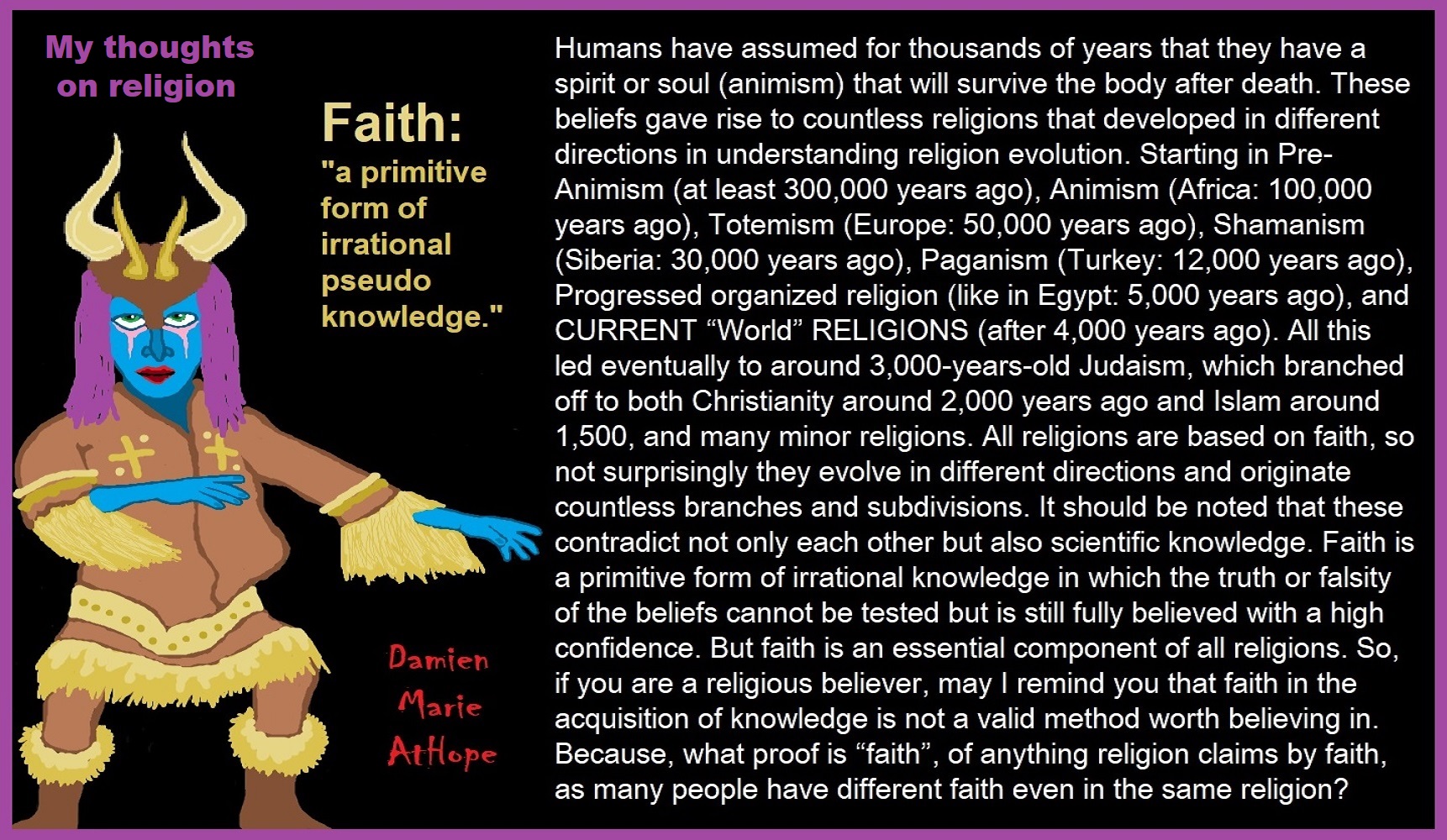
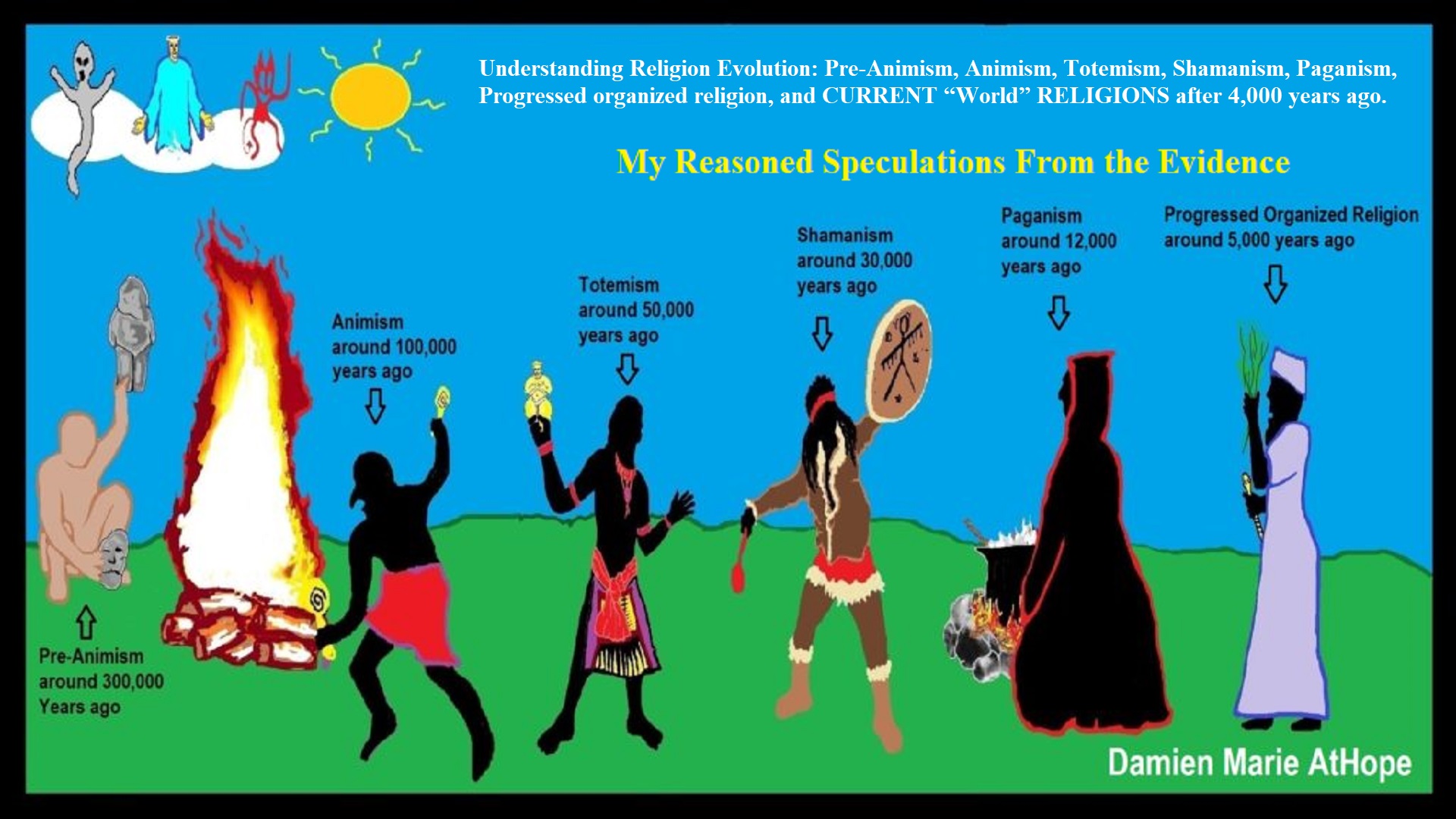
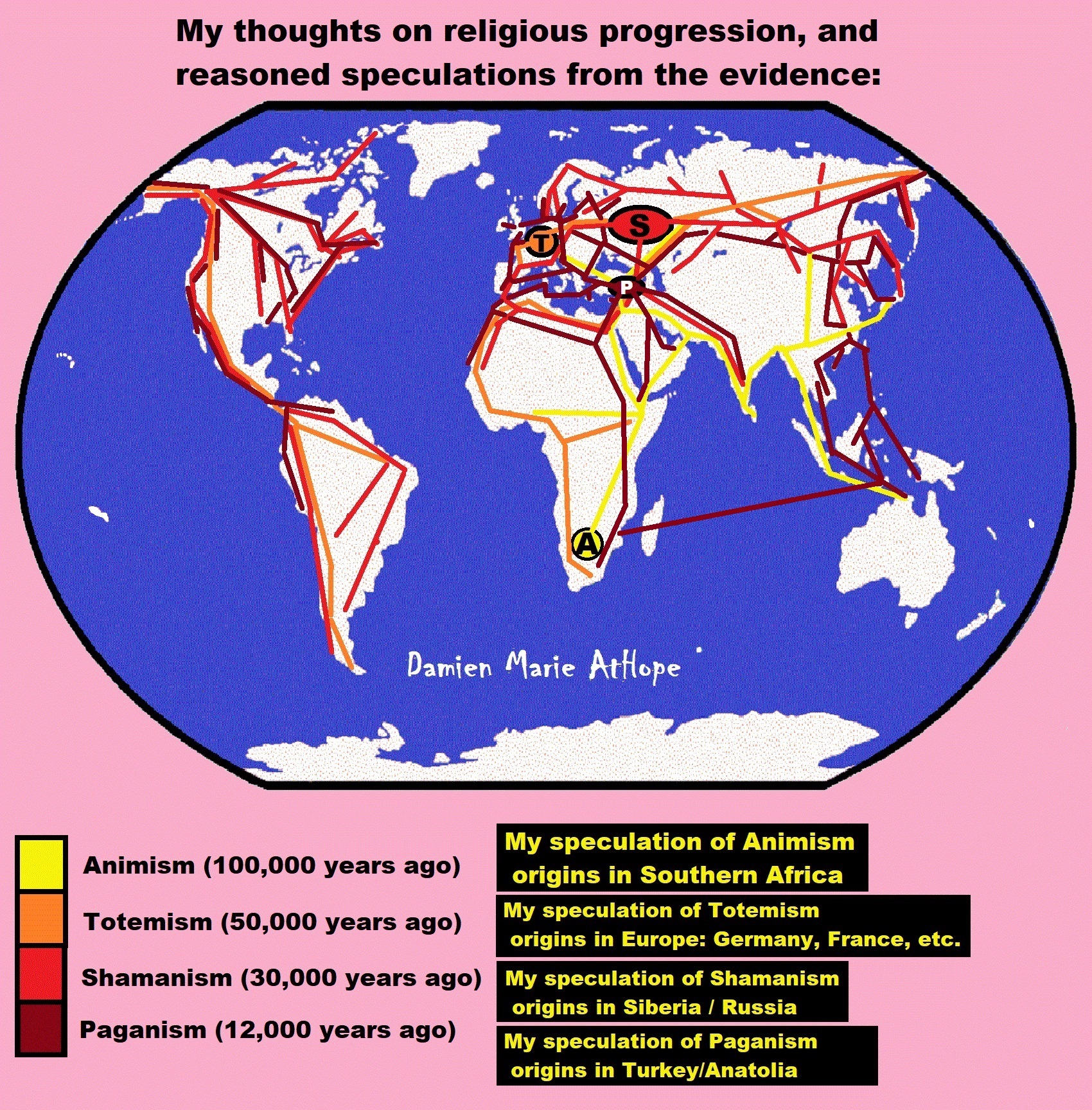
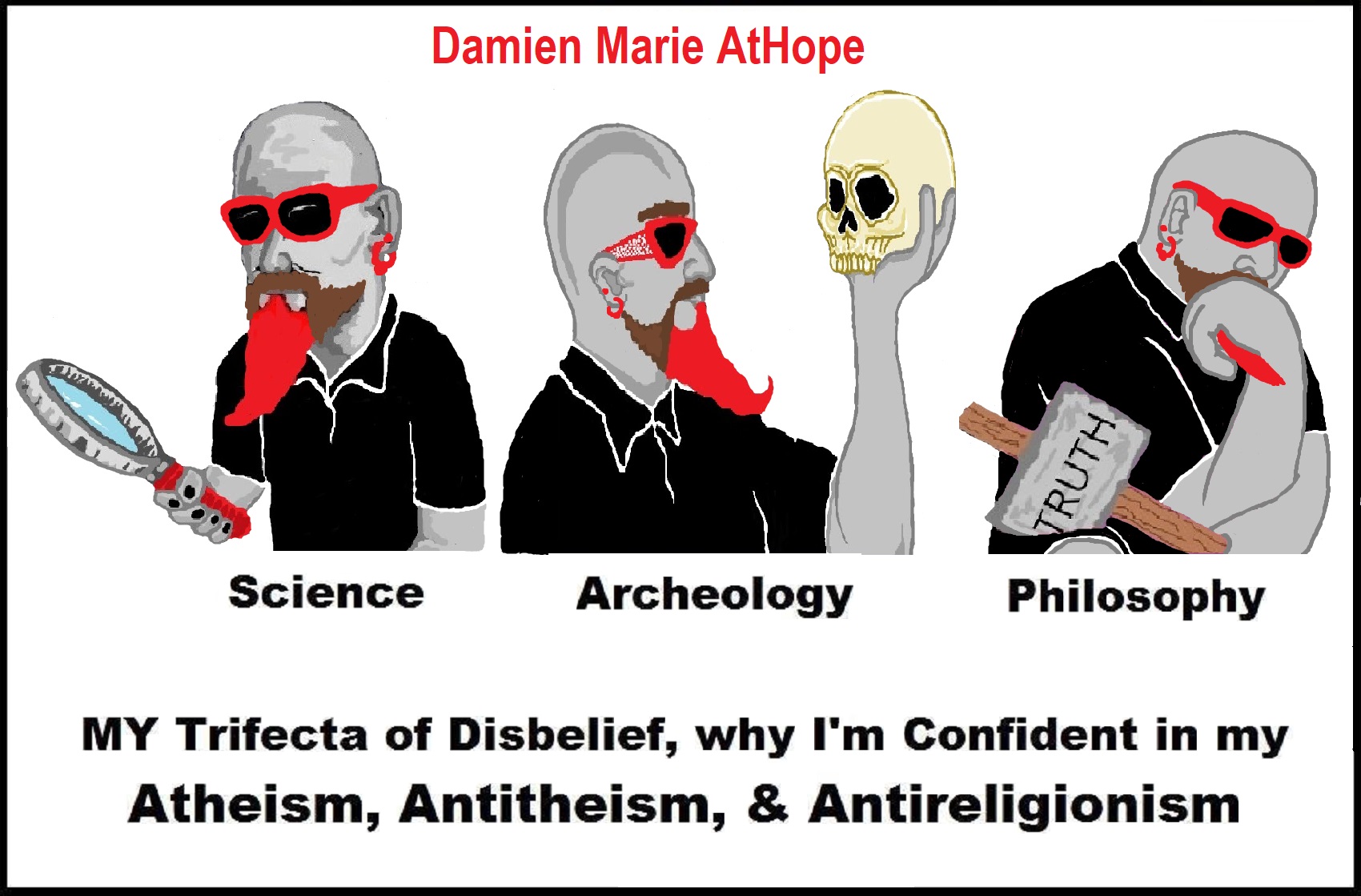
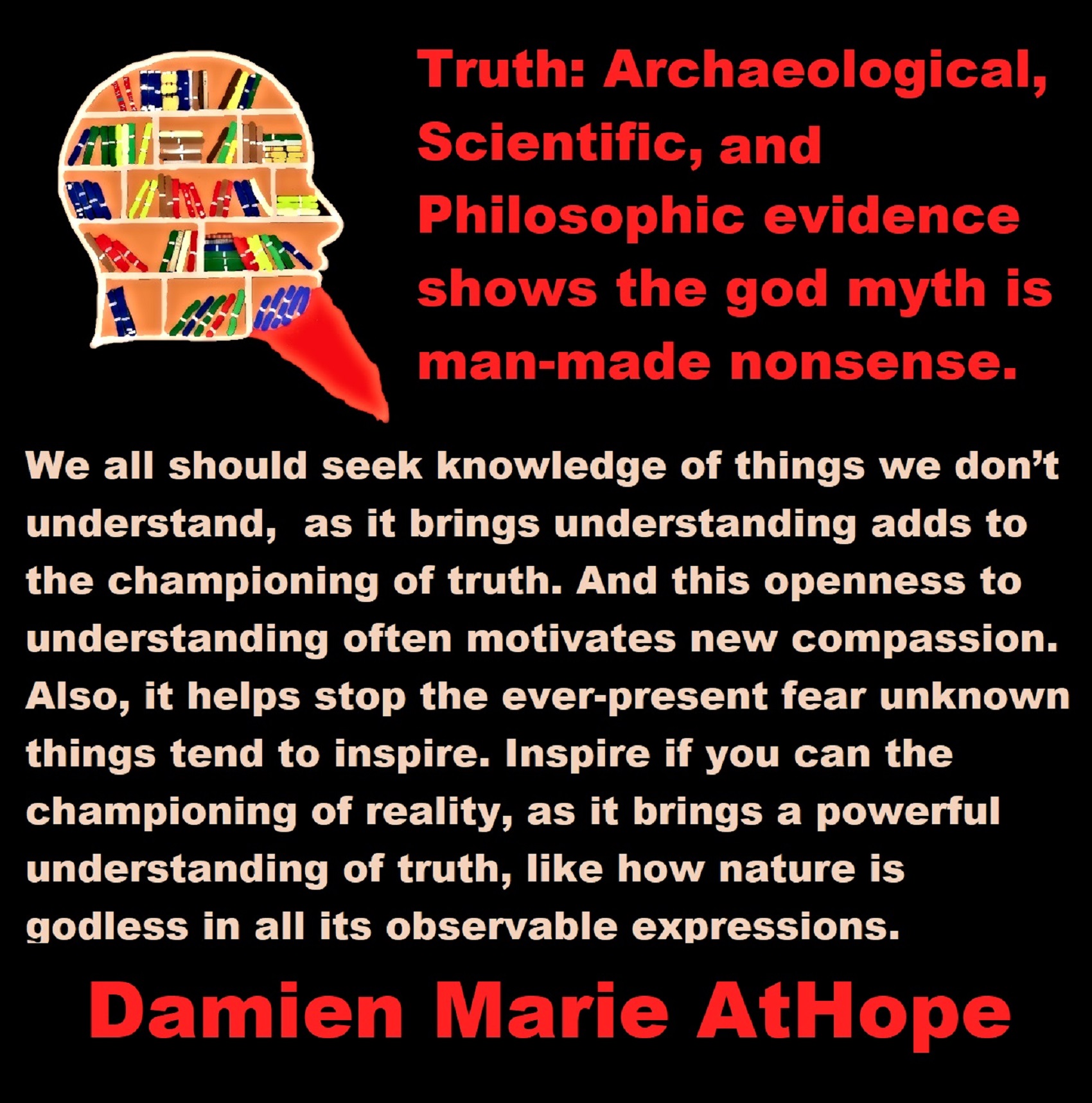
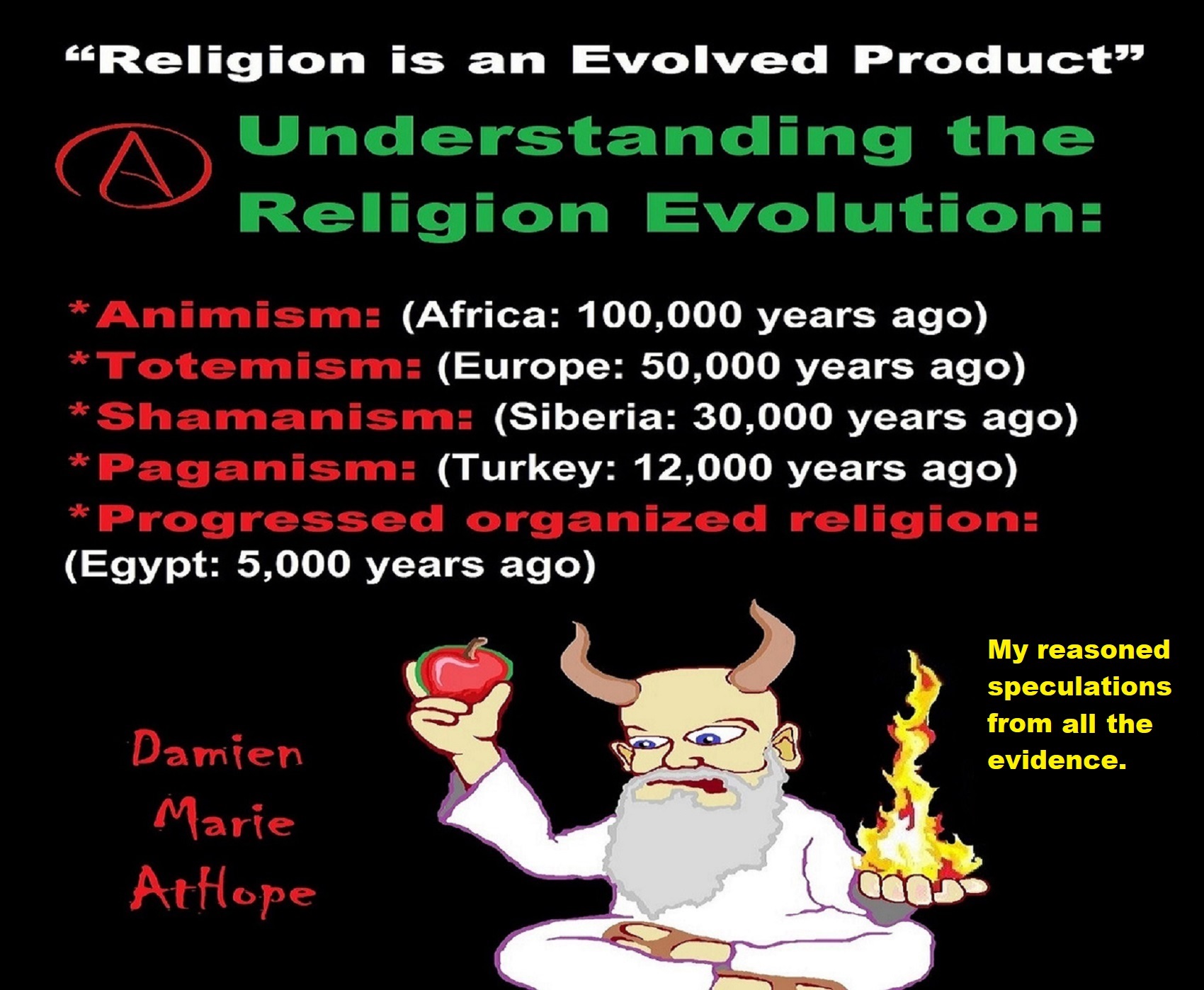
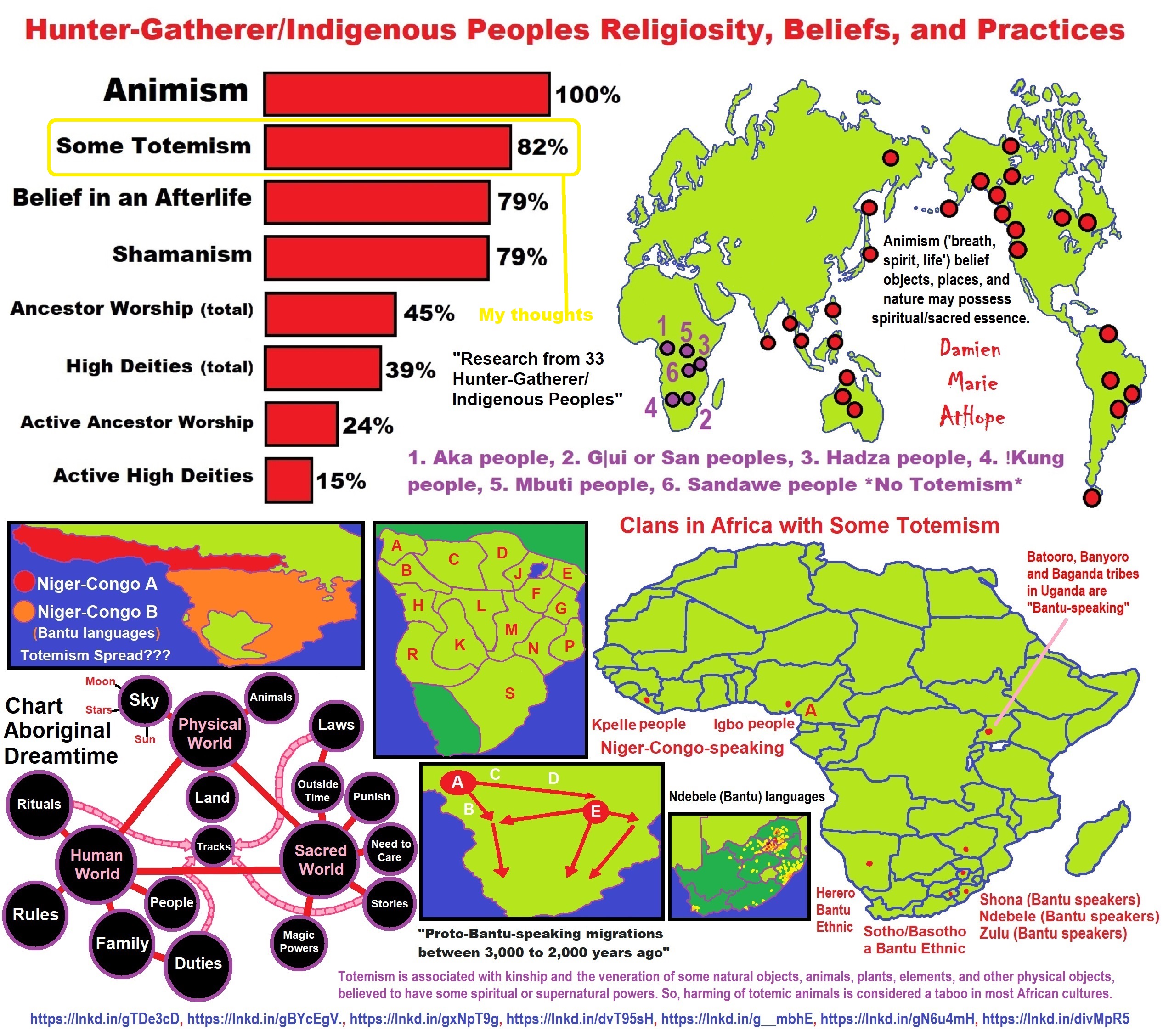
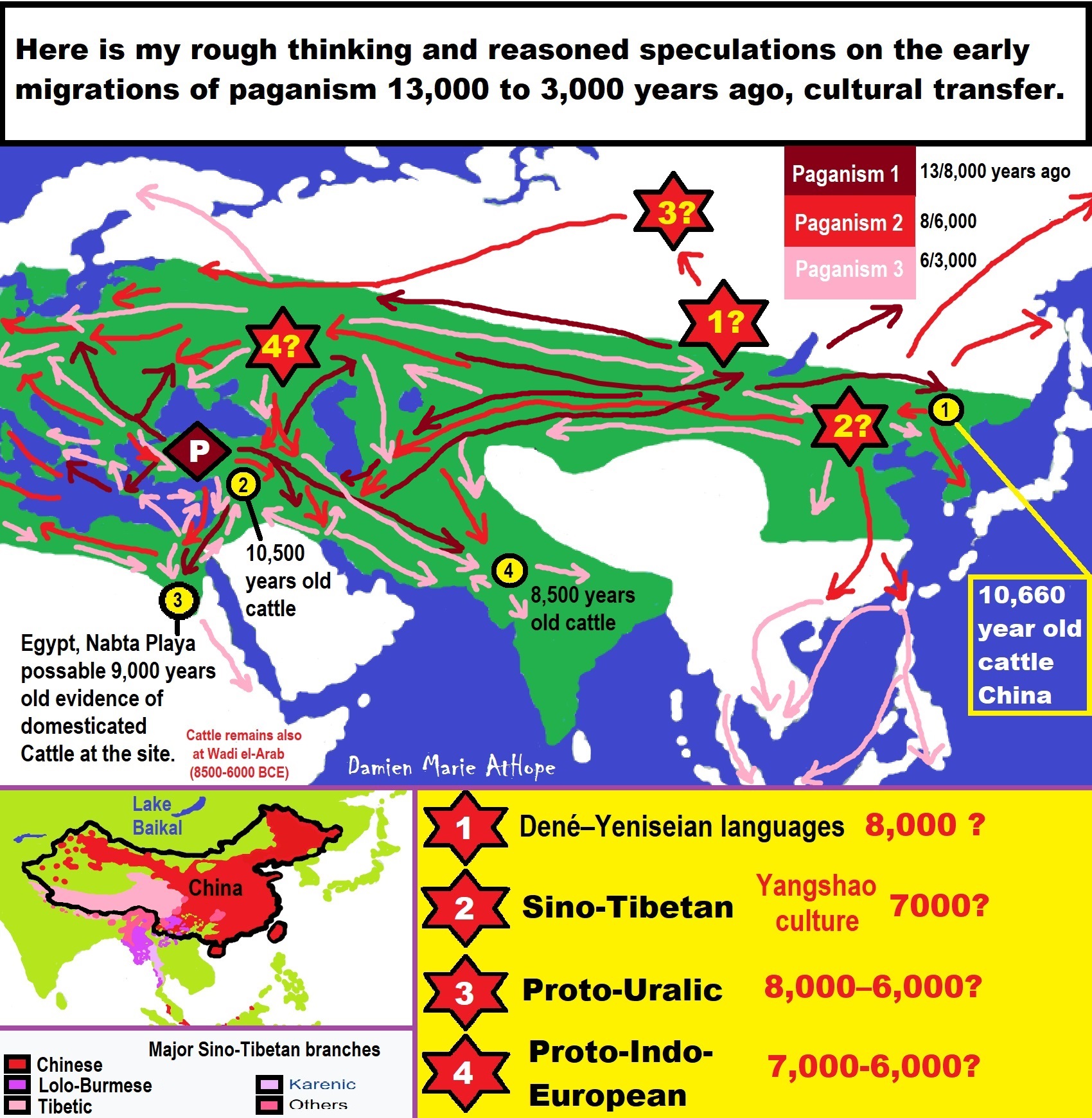
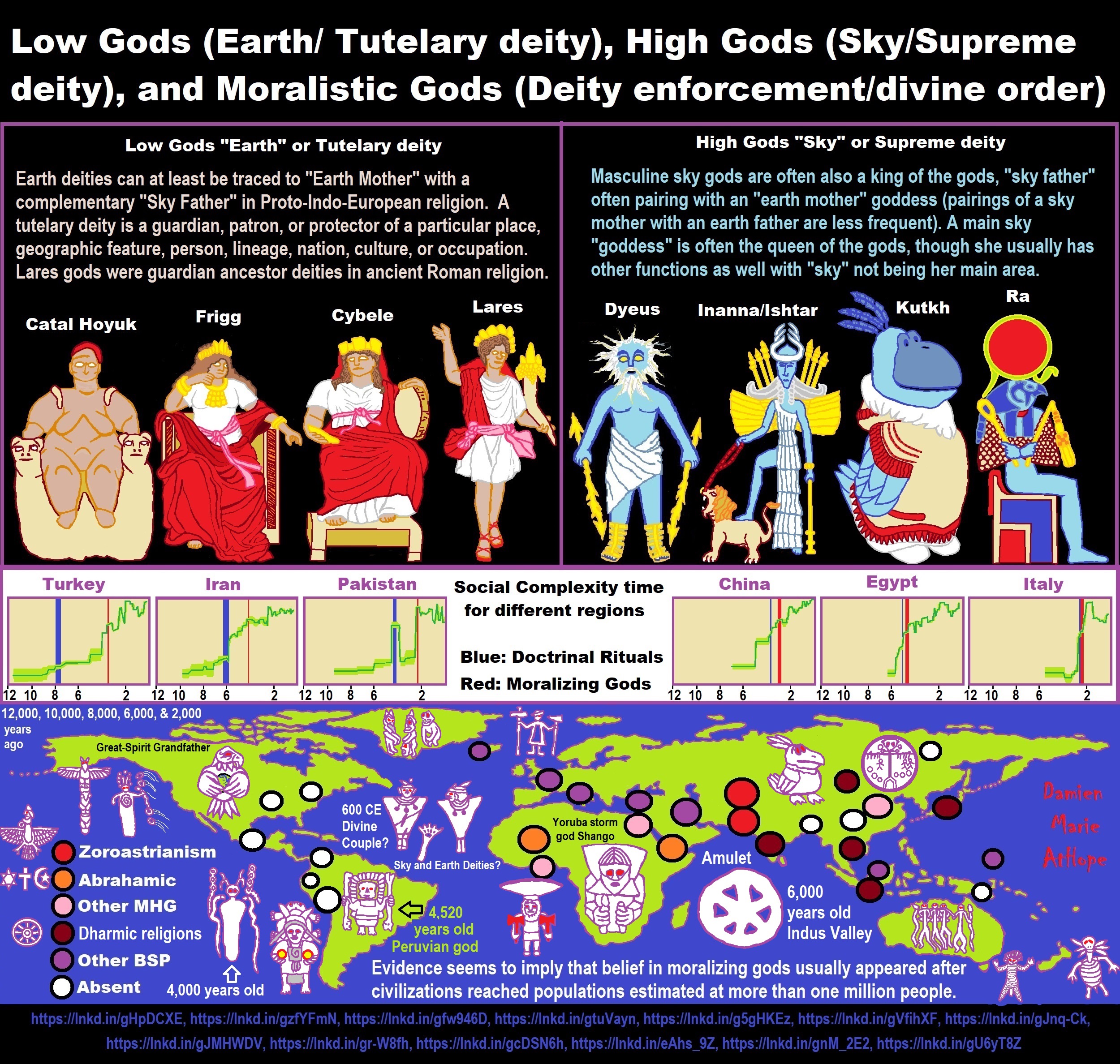
ref, ref, ref, ref, ref, ref, ref, ref, ref, ref, ref, ref, ref, ref, ref, ref, ref, ref, ref, ref, ref
Low Gods “Earth” or Tutelary deity and High Gods “Sky” or Supreme deity
“An Earth goddess is a deification of the Earth. Earth goddesses are often associated with the “chthonic” deities of the underworld. Ki and Ninhursag are Mesopotamian earth goddesses. In Greek mythology, the Earth is personified as Gaia, corresponding to Roman Terra, Indic Prithvi/Bhūmi, etc. traced to an “Earth Mother” complementary to the “Sky Father” in Proto-Indo-European religion. Egyptian mythology exceptionally has a sky goddess and an Earth god.” ref
“A mother goddess is a goddess who represents or is a personification of nature, motherhood, fertility, creation, destruction or who embodies the bounty of the Earth. When equated with the Earth or the natural world, such goddesses are sometimes referred to as Mother Earth or as the Earth Mother. In some religious traditions or movements, Heavenly Mother (also referred to as Mother in Heaven or Sky Mother) is the wife or feminine counterpart of the Sky father or God the Father.” ref
“Any masculine sky god is often also king of the gods, taking the position of patriarch within a pantheon. Such king gods are collectively categorized as “sky father” deities, with a polarity between sky and earth often being expressed by pairing a “sky father” god with an “earth mother” goddess (pairings of a sky mother with an earth father are less frequent). A main sky goddess is often the queen of the gods and may be an air/sky goddess in her own right, though she usually has other functions as well with “sky” not being her main. In antiquity, several sky goddesses in ancient Egypt, Mesopotamia, and the Near East were called Queen of Heaven. Neopagans often apply it with impunity to sky goddesses from other regions who were never associated with the term historically. The sky often has important religious significance. Many religions, both polytheistic and monotheistic, have deities associated with the sky.” ref
“In comparative mythology, sky father is a term for a recurring concept in polytheistic religions of a sky god who is addressed as a “father”, often the father of a pantheon and is often either a reigning or former King of the Gods. The concept of “sky father” may also be taken to include Sun gods with similar characteristics, such as Ra. The concept is complementary to an “earth mother“. “Sky Father” is a direct translation of the Vedic Dyaus Pita, etymologically descended from the same Proto-Indo-European deity name as the Greek Zeûs Pater and Roman Jupiter and Germanic Týr, Tir or Tiwaz, all of which are reflexes of the same Proto-Indo-European deity’s name, *Dyēus Ph₂tḗr. While there are numerous parallels adduced from outside of Indo-European mythology, there are exceptions (e.g. In Egyptian mythology, Nut is the sky mother and Geb is the earth father).” ref
Tutelary deity
“A tutelary (also tutelar) is a deity or spirit who is a guardian, patron, or protector of a particular place, geographic feature, person, lineage, nation, culture, or occupation. The etymology of “tutelary” expresses the concept of safety and thus of guardianship. In late Greek and Roman religion, one type of tutelary deity, the genius, functions as the personal deity or daimon of an individual from birth to death. Another form of personal tutelary spirit is the familiar spirit of European folklore.” ref
“A tutelary (also tutelar) in Korean shamanism, jangseung and sotdae were placed at the edge of villages to frighten off demons. They were also worshiped as deities. Seonangshin is the patron deity of the village in Korean tradition and was believed to embody the Seonangdang. In Philippine animism, Diwata or Lambana are deities or spirits that inhabit sacred places like mountains and mounds and serve as guardians. Such as: Maria Makiling is the deity who guards Mt. Makiling and Maria Cacao and Maria Sinukuan. In Shinto, the spirits, or kami, which give life to human bodies come from nature and return to it after death. Ancestors are therefore themselves tutelaries to be worshiped. And similarly, Native American beliefs such as Tonás, tutelary animal spirit among the Zapotec and Totems, familial or clan spirits among the Ojibwe, can be animals.” ref
“A tutelary (also tutelar) in Austronesian beliefs such as: Atua (gods and spirits of the Polynesian peoples such as the Māori or the Hawaiians), Hanitu (Bunun of Taiwan‘s term for spirit), Hyang (Kawi, Sundanese, Javanese, and Balinese Supreme Being, in ancient Java and Bali mythology and this spiritual entity, can be either divine or ancestral), Kaitiaki (New Zealand Māori term used for the concept of guardianship, for the sky, the sea, and the land), Kawas (mythology) (divided into 6 groups: gods, ancestors, souls of the living, spirits of living things, spirits of lifeless objects, and ghosts), Tiki (Māori mythology, Tiki is the first man created by either Tūmatauenga or Tāne and represents deified ancestors found in most Polynesian cultures). ” ref, ref, ref, ref, ref, ref, ref
Mesopotamian Tutelary Deities can be seen as ones related to City-States
“Historical city-states included Sumerian cities such as Uruk and Ur; Ancient Egyptian city-states, such as Thebes and Memphis; the Phoenician cities (such as Tyre and Sidon); the five Philistine city-states; the Berber city-states of the Garamantes; the city-states of ancient Greece (the poleis such as Athens, Sparta, Thebes, and Corinth); the Roman Republic (which grew from a city-state into a vast empire); the Italian city-states from the Middle Ages to the early modern period, such as Florence, Siena, Ferrara, Milan (which as they grew in power began to dominate neighboring cities) and Genoa and Venice, which became powerful thalassocracies; the Mayan and other cultures of pre-Columbian Mesoamerica (including cities such as Chichen Itza, Tikal, Copán and Monte Albán); the central Asian cities along the Silk Road; the city-states of the Swahili coast; Ragusa; states of the medieval Russian lands such as Novgorod and Pskov; and many others.” ref
“The Uruk period (ca. 4000 to 3100 BCE; also known as Protoliterate period) of Mesopotamia, named after the Sumerian city of Uruk, this period saw the emergence of urban life in Mesopotamia and the Sumerian civilization. City-States like Uruk and others had a patron tutelary City Deity along with a Priest-King.” ref
“Chinese folk religion, both past, and present, includes myriad tutelary deities. Exceptional individuals, highly cultivated sages, and prominent ancestors can be deified and honored after death. Lord Guan is the patron of military personnel and police, while Mazu is the patron of fishermen and sailors. Such as Tu Di Gong (Earth Deity) is the tutelary deity of a locality, and each individual locality has its own Earth Deity and Cheng Huang Gong (City God) is the guardian deity of an individual city, worshipped by local officials and locals since imperial times.” ref
“A tutelary (also tutelar) in Hinduism, personal tutelary deities are known as ishta-devata, while family tutelary deities are known as Kuladevata. Gramadevata are guardian deities of villages. Devas can also be seen as tutelary. Shiva is the patron of yogis and renunciants. City goddesses include: Mumbadevi (Mumbai), Sachchika (Osian); Kuladevis include: Ambika (Porwad), and Mahalakshmi. In NorthEast India Meitei mythology and religion (Sanamahism) of Manipur, there are various types of tutelary deities, among which Lam Lais are the most predominant ones. Tibetan Buddhism has Yidam as a tutelary deity. Dakini is the patron of those who seek knowledge.” ref
“A tutelary (also tutelar) The Greeks also thought deities guarded specific places: for instance, Athena was the patron goddess of the city of Athens. Socrates spoke of hearing the voice of his personal spirit or daimonion:
You have often heard me speak of an oracle or sign which comes to me … . This sign I have had ever since I was a child. The sign is a voice which comes to me and always forbids me to do something which I am going to do, but never commands me to do anything, and this is what stands in the way of my being a politician.” ref
“Tutelary deities who guard and preserve a place or a person are fundamental to ancient Roman religion. The tutelary deity of a man was his Genius, that of a woman her Juno. In the Imperial era, the Genius of the Emperor was a focus of Imperial cult. An emperor might also adopt a major deity as his personal patron or tutelary, as Augustus did Apollo. Precedents for claiming the personal protection of a deity were established in the Republican era, when for instance the Roman dictator Sulla advertised the goddess Victory as his tutelary by holding public games (ludi) in her honor.” ref
“Each town or city had one or more tutelary deities, whose protection was considered particularly vital in time of war and siege. Rome itself was protected by a goddess whose name was to be kept ritually secret on pain of death (for a supposed case, see Quintus Valerius Soranus). The Capitoline Triad of Juno, Jupiter, and Minerva were also tutelaries of Rome. The Italic towns had their own tutelary deities. Juno often had this function, as at the Latin town of Lanuvium and the Etruscan city of Veii, and was often housed in an especially grand temple on the arx (citadel) or other prominent or central location. The tutelary deity of Praeneste was Fortuna, whose oracle was renowned.” ref
“The Roman ritual of evocatio was premised on the belief that a town could be made vulnerable to military defeat if the power of its tutelary deity were diverted outside the city, perhaps by the offer of superior cult at Rome. The depiction of some goddesses such as the Magna Mater (Great Mother, or Cybele) as “tower-crowned” represents their capacity to preserve the city. A town in the provinces might adopt a deity from within the Roman religious sphere to serve as its guardian, or syncretize its own tutelary with such; for instance, a community within the civitas of the Remi in Gaul adopted Apollo as its tutelary, and at the capital of the Remi (present-day Rheims), the tutelary was Mars Camulus.” ref
Household deity (a kind of or related to a Tutelary deity)
“A household deity is a deity or spirit that protects the home, looking after the entire household or certain key members. It has been a common belief in paganism as well as in folklore across many parts of the world. Household deities fit into two types; firstly, a specific deity – typically a goddess – often referred to as a hearth goddess or domestic goddess who is associated with the home and hearth, such as the ancient Greek Hestia.” ref
“The second type of household deities are those that are not one singular deity, but a type, or species of animistic deity, who usually have lesser powers than major deities. This type was common in the religions of antiquity, such as the Lares of ancient Roman religion, the Gashin of Korean shamanism, and Cofgodas of Anglo-Saxon paganism. These survived Christianisation as fairy-like creatures existing in folklore, such as the Anglo-Scottish Brownie and Slavic Domovoy.” ref
“Household deities were usually worshipped not in temples but in the home, where they would be represented by small idols (such as the teraphim of the Bible, often translated as “household gods” in Genesis 31:19 for example), amulets, paintings, or reliefs. They could also be found on domestic objects, such as cosmetic articles in the case of Tawaret. The more prosperous houses might have a small shrine to the household god(s); the lararium served this purpose in the case of the Romans. The gods would be treated as members of the family and invited to join in meals, or be given offerings of food and drink.” ref
“In many religions, both ancient and modern, a god would preside over the home. Certain species, or types, of household deities, existed. An example of this was the Roman Lares. Many European cultures retained house spirits into the modern period. Some examples of these include:
- Brownie (Scotland and England) or Hob (England) / Kobold (Germany) / Goblin / Hobgoblin
- Domovoy (Slavic)
- Nisse (Norwegian or Danish) / Tomte (Swedish) / Tonttu (Finnish)
- Húsvættir (Norse)” ref
“Although the cosmic status of household deities was not as lofty as that of the Twelve Olympians or the Aesir, they were also jealous of their dignity and also had to be appeased with shrines and offerings, however humble. Because of their immediacy they had arguably more influence on the day-to-day affairs of men than the remote gods did. Vestiges of their worship persisted long after Christianity and other major religions extirpated nearly every trace of the major pagan pantheons. Elements of the practice can be seen even today, with Christian accretions, where statues to various saints (such as St. Francis) protect gardens and grottos. Even the gargoyles found on older churches, could be viewed as guardians partitioning a sacred space.” ref
“For centuries, Christianity fought a mop-up war against these lingering minor pagan deities, but they proved tenacious. For example, Martin Luther‘s Tischreden have numerous – quite serious – references to dealing with kobolds. Eventually, rationalism and the Industrial Revolution threatened to erase most of these minor deities, until the advent of romantic nationalism rehabilitated them and embellished them into objects of literary curiosity in the 19th century. Since the 20th century this literature has been mined for characters for role-playing games, video games, and other fantasy personae, not infrequently invested with invented traits and hierarchies somewhat different from their mythological and folkloric roots.” ref
“In contradistinction to both Herbert Spencer and Edward Burnett Tylor, who defended theories of animistic origins of ancestor worship, Émile Durkheim saw its origin in totemism. In reality, this distinction is somewhat academic, since totemism may be regarded as a particularized manifestation of animism, and something of a synthesis of the two positions was attempted by Sigmund Freud. In Freud’s Totem and Taboo, both totem and taboo are outward expressions or manifestations of the same psychological tendency, a concept which is complementary to, or which rather reconciles, the apparent conflict. Freud preferred to emphasize the psychoanalytic implications of the reification of metaphysical forces, but with particular emphasis on its familial nature. This emphasis underscores, rather than weakens, the ancestral component.” ref
“William Edward Hearn, a noted classicist, and jurist, traced the origin of domestic deities from the earliest stages as an expression of animism, a belief system thought to have existed also in the neolithic, and the forerunner of Indo-European religion. In his analysis of the Indo-European household, in Chapter II “The House Spirit”, Section 1, he states:
The belief which guided the conduct of our forefathers was … the spirit rule of dead ancestors.” ref
“In Section 2 he proceeds to elaborate:
It is thus certain that the worship of deceased ancestors is a vera causa, and not a mere hypothesis. …
In the other European nations, the Slavs, the Teutons, and the Kelts, the House Spirit appears with no less distinctness. … [T]he existence of that worship does not admit of doubt. … The House Spirits had a multitude of other names which it is needless here to enumerate, but all of which are more or less expressive of their friendly relations with man. … In [England] … [h]e is the Brownie. … In Scotland this same Brownie is well known. He is usually described as attached to particular families, with whom he has been known to reside for centuries, threshing the corn, cleaning the house, and performing similar household tasks. His favorite gratification was milk and honey.” ref
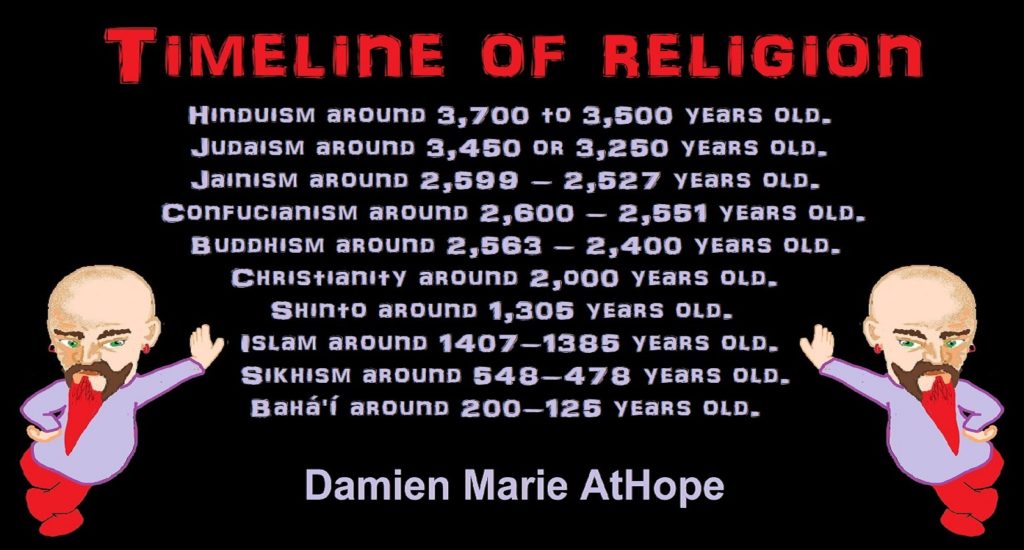
Hinduism around 3,700 to 3,500 years old. ref
Judaism around 3,450 or 3,250 years old. (The first writing in the bible was “Paleo-Hebrew” dated to around 3,000 years ago Khirbet Qeiyafa is the site of an ancient fortress city overlooking the Elah Valley. And many believe the religious Jewish texts were completed around 2,500) ref, ref
Judaism is around 3,450 or 3,250 years old. (“Paleo-Hebrew” 3,000 years ago and Torah 2,500 years ago)
“Judaism is an Abrahamic, its roots as an organized religion in the Middle East during the Bronze Age. Some scholars argue that modern Judaism evolved from Yahwism, the religion of ancient Israel and Judah, by the late 6th century BCE, and is thus considered to be one of the oldest monotheistic religions.” ref
“Yahwism is the name given by modern scholars to the religion of ancient Israel, essentially polytheistic, with a plethora of gods and goddesses. Heading the pantheon was Yahweh, the national god of the Israelite kingdoms of Israel and Judah, with his consort, the goddess Asherah; below them were second-tier gods and goddesses such as Baal, Shamash, Yarikh, Mot, and Astarte, all of whom had their own priests and prophets and numbered royalty among their devotees, and a third and fourth tier of minor divine beings, including the mal’ak, the messengers of the higher gods, who in later times became the angels of Judaism, Christianity and Islam. Yahweh, however, was not the ‘original’ god of Israel “Isra-El”; it is El, the head of the Canaanite pantheon, whose name forms the basis of the name “Israel”, and none of the Old Testament patriarchs, the tribes of Israel, the Judges, or the earliest monarchs, have a Yahwistic theophoric name (i.e., one incorporating the name of Yahweh).” ref
“El is a Northwest Semitic word meaning “god” or “deity“, or referring (as a proper name) to any one of multiple major ancient Near Eastern deities. A rarer form, ‘ila, represents the predicate form in Old Akkadian and in Amorite. The word is derived from the Proto-Semitic *ʔil-, meaning “god”. Specific deities known as ‘El or ‘Il include the supreme god of the ancient Canaanite religion and the supreme god of East Semitic speakers in Mesopotamia’s Early Dynastic Period. ʼĒl is listed at the head of many pantheons. In some Canaanite and Ugaritic sources, ʼĒl played a role as father of the gods, of creation, or both. For example, in the Ugaritic texts, ʾil mlk is understood to mean “ʼĒl the King” but ʾil hd as “the god Hadad“. The Semitic root ʾlh (Arabic ʾilāh, Aramaic ʾAlāh, ʾElāh, Hebrew ʾelōah) may be ʾl with a parasitic h, and ʾl may be an abbreviated form of ʾlh. In Ugaritic the plural form meaning “gods” is ʾilhm, equivalent to Hebrew ʾelōhîm “powers”. In the Hebrew texts this word is interpreted as being semantically singular for “god” by biblical commentators. However the documentary hypothesis for the Old Testament (corresponds to the Jewish Torah) developed originally in the 1870s, identifies these that different authors – the Jahwist, Elohist, Deuteronomist, and the Priestly source – were responsible for editing stories from a polytheistic religion into those of a monotheistic religion. Inconsistencies that arise between monotheism and polytheism in the texts are reflective of this hypothesis.” ref
Jainism around 2,599 – 2,527 years old. ref
Confucianism around 2,600 – 2,551 years old. ref
Buddhism around 2,563/2,480 – 2,483/2,400 years old. ref
Christianity around 2,o00 years old. ref
Shinto around 1,305 years old. ref
Islam around 1407–1385 years old. ref
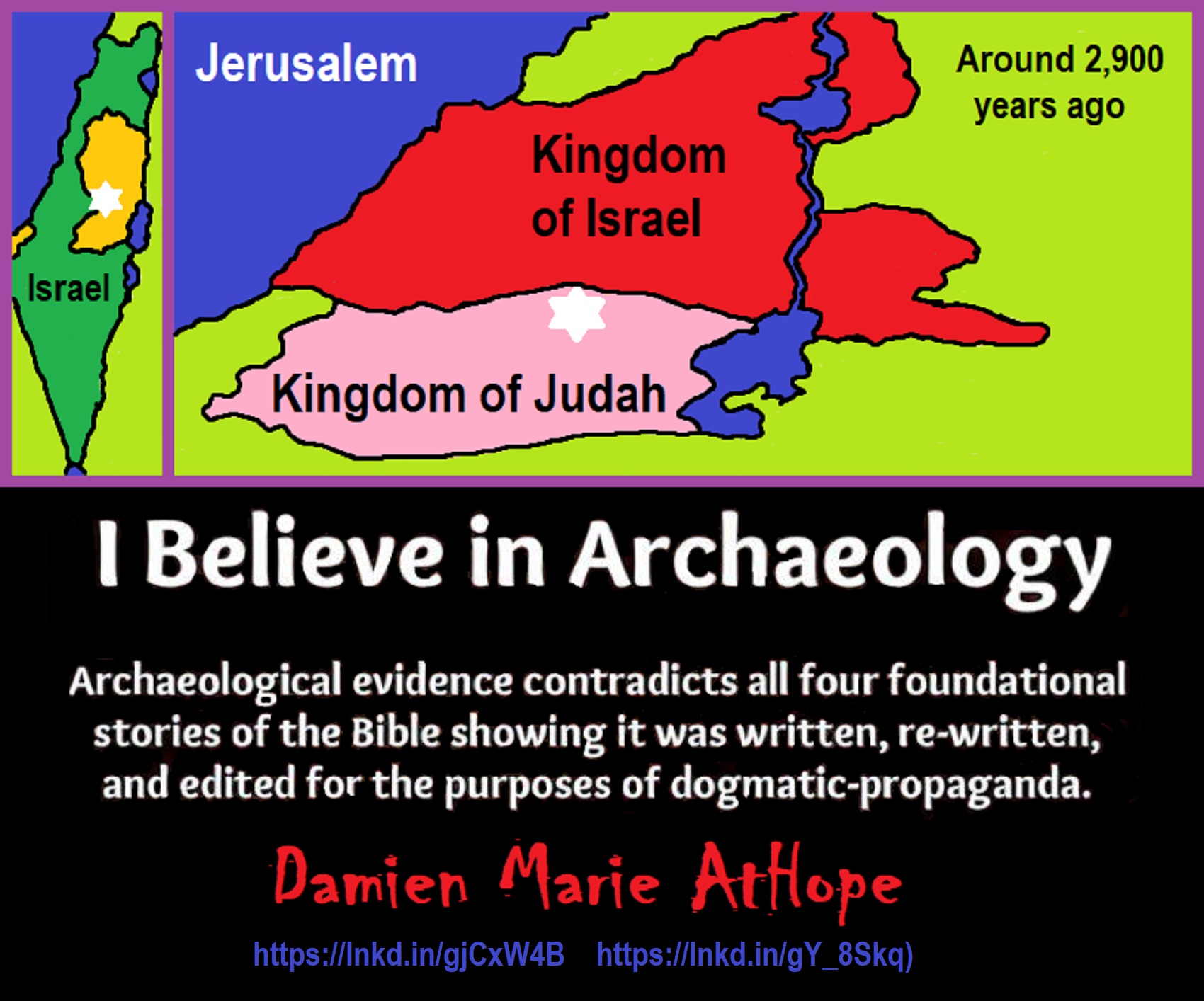
Knowledge to Ponder:
Stars/Astrology:
- Possibly, around 30,000 years ago (in simpler form) to 6,000 years ago, Stars/Astrology are connected to Ancestors, Spirit Animals, and Deities.
- The star also seems to be a possible proto-star for Star of Ishtar, Star of Inanna, or Star of Venus.
- Around 7,000 to 6,000 years ago, Star Constellations/Astrology have connections to the “Kurgan phenomenon” of below-ground “mound” stone/wood burial structures and “Dolmen phenomenon” of above-ground stone burial structures.
- Around 6,500–5,800 years ago, The Northern Levant migrations into Jordon and Israel in the Southern Levant brought new cultural and religious transfer from Turkey and Iran.
- “The Ghassulian Star,” a mysterious 6,000-year-old mural from Jordan may have connections to the European paganstic kurgan/dolmens phenomenon.
“Astrology is a range of divinatory practices, recognized as pseudoscientific since the 18th century, that claim to discern information about human affairs and terrestrial events by studying the apparent positions of celestial objects. Different cultures have employed forms of astrology since at least the 2nd millennium BCE, these practices having originated in calendrical systems used to predict seasonal shifts and to interpret celestial cycles as signs of divine communications. Most, if not all, cultures have attached importance to what they observed in the sky, and some—such as the Hindus, Chinese, and the Maya—developed elaborate systems for predicting terrestrial events from celestial observations. Western astrology, one of the oldest astrological systems still in use, can trace its roots to 19th–17th century BCE Mesopotamia, from where it spread to Ancient Greece, Rome, the Islamicate world and eventually Central and Western Europe. Contemporary Western astrology is often associated with systems of horoscopes that purport to explain aspects of a person’s personality and predict significant events in their lives based on the positions of celestial objects; the majority of professional astrologers rely on such systems.” ref
Around 5,500 years ago, Science evolves, The first evidence of science was 5,500 years ago and was demonstrated by a body of empirical, theoretical, and practical knowledge about the natural world. ref
Around 5,000 years ago, Origin of Logics is a Naturalistic Observation (principles of valid reasoning, inference, & demonstration) ref
Around 4,150 to 4,000 years ago: The earliest surviving versions of the Sumerian Epic of Gilgamesh, which was originally titled “He who Saw the Deep” (Sha naqba īmuru) or “Surpassing All Other Kings” (Shūtur eli sharrī) were written. ref
Hinduism:
- 3,700 years ago or so, the oldest of the Hindu Vedas (scriptures), the Rig Veda was composed.
- 3,500 years ago or so, the Vedic Age began in India after the collapse of the Indus Valley Civilization.
Judaism:
- around 3,000 years ago, the first writing in the bible was “Paleo-Hebrew”
- around 2,500 years ago, many believe the religious Jewish texts were completed
Myths: The bible inspired religion is not just one religion or one myth but a grouping of several religions and myths
- Around 3,450 or 3,250 years ago, according to legend, is the traditionally accepted period in which the Israelite lawgiver, Moses, provided the Ten Commandments.
- Around 2,500 to 2,400 years ago, a collection of ancient religious writings by the Israelites based primarily upon the Hebrew Bible, Tanakh, or Old Testament is the first part of Christianity’s bible.
- Around 2,400 years ago, the most accepted hypothesis is that the canon was formed in stages, first the Pentateuch (Torah).
- Around 2,140 to 2,116 years ago, the Prophets was written during the Hasmonean dynasty, and finally the remaining books.
- Christians traditionally divide the Old Testament into four sections:
- The first five books or Pentateuch (Torah).
- The proposed history books telling the history of the Israelites from their conquest of Canaan to their defeat and exile in Babylon.
- The poetic and proposed “Wisdom books” dealing, in various forms, with questions of good and evil in the world.
- The books of the biblical prophets, warning of the consequences of turning away from God:
- Henotheism:
- Exodus 20:23 “You shall not make other gods besides Me (not saying there are no other gods just not to worship them); gods of silver or gods of gold, you shall not make for yourselves.”
- Polytheism:
- Judges 10:6 “Then the sons of Israel again did evil in the sight of the LORD, served the Baals and the Ashtaroth, the gods of Aram, the gods of Sidon, the gods of Moab, the gods of the sons of Ammon, and the gods of the Philistines; thus they forsook the LORD and did not serve Him.”
- 1 Corinthians 8:5 “For even if there are so-called gods whether in heaven or on earth, as indeed there are many gods and many lords.”
- Monotheism:
- Isaiah 43:10 “You are my witnesses,” declares the LORD, “and my servant whom I have chosen, so that you may know and believe me and understand that I am he. Before me no god was formed, nor will there be one after me.
Around 2,570 to 2,270 Years Ago, there is a confirmation of atheistic doubting as well as atheistic thinking, mainly by Greek philosophers. However, doubting gods is likely as old as the invention of gods and should destroy the thinking that belief in god(s) is the “default belief”. The Greek word is apistos (a “not” and pistos “faithful,”), thus not faithful or faithless because one is unpersuaded and unconvinced by a god(s) claim. Short Definition: unbelieving, unbeliever, or unbelief.
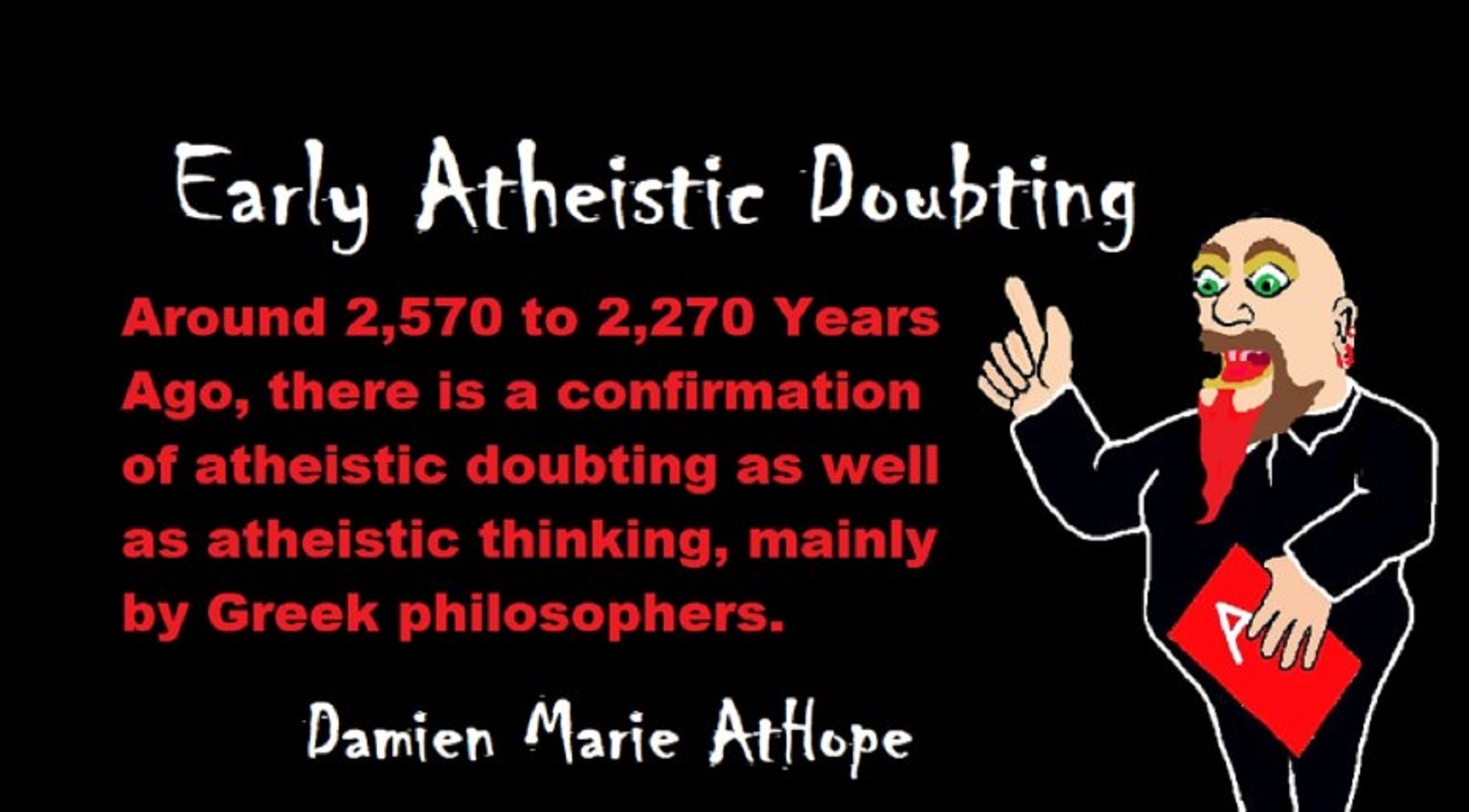
Expressions of Atheistic Thinking:
- Around 2,600 years ago, Ajita Kesakambali, ancient Indian philosopher, who is the first known proponent of Indian materialism. ref
- Around 2,535 to 2,475 years ago, Heraclitus, Greek pre-Socratic philosopher, a native of the Greek city Ephesus, Ionia, on the coast of Anatolia, also known as Asia Minor or modern Turkey. ref
- Around 2,500 to 2,400 years ago, according to The Story of Civilization book series certain African pygmy tribes have no identifiable gods, spirits, or religious beliefs or rituals, and even what burials accrue are without ceremony. ref
- Around 2,490 to 2,430 years ago, Empedocles, Greek pre-Socratic philosopher and a citizen of Agrigentum, a Greek city in Sicily. ref
- Around 2,460 to 2,370 years ago, Democritus, Greek pre-Socratic philosopher considered to be the “father of modern science” possibly had some disbelief amounting to atheism. ref
- Around 2,399 years ago or so, Socrates, a famous Greek philosopher was tried for sinfulness by teaching doubt of state gods. ref
- Around 2,341 to 2,270 years ago, Epicurus, a Greek philosopher known for composing atheistic critics and famously stated, “Is God willing to prevent evil, but not able? Then he is not omnipotent. Is he able, but not willing? Then he is malevolent. Is he both able and willing? Then whence cometh evil? Is he neither able nor willing? Then why call him god?” ref
This last expression by Epicurus, seems to be an expression of Axiological Atheism. To understand and utilize value or actually possess “Value Conscious/Consciousness” to both give a strong moral “axiological” argument (the problem of evil) as well as use it to fortify humanism and positive ethical persuasion of human helping and care responsibilities. Because value-blindness gives rise to sociopathic/psychopathic evil.
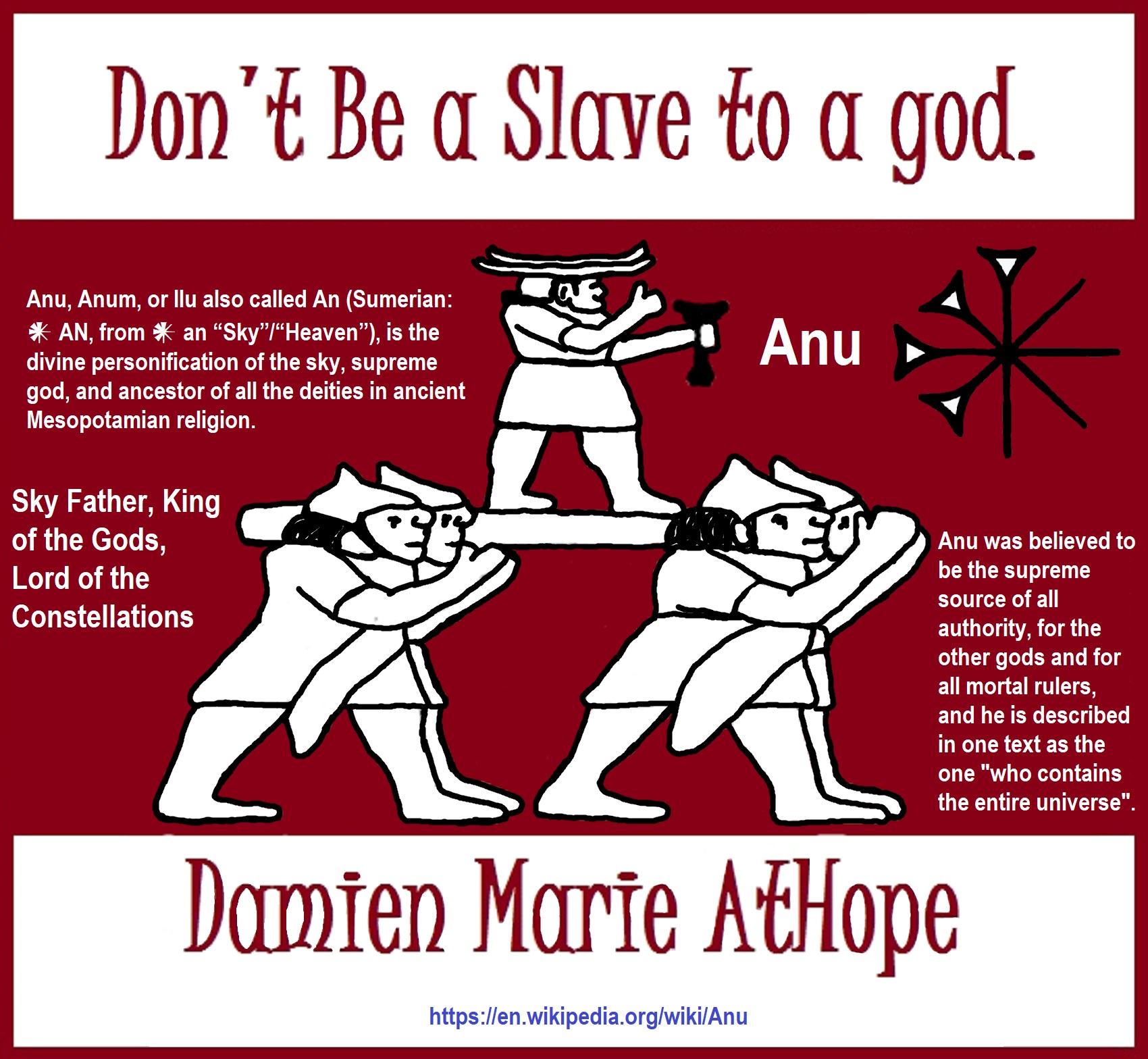
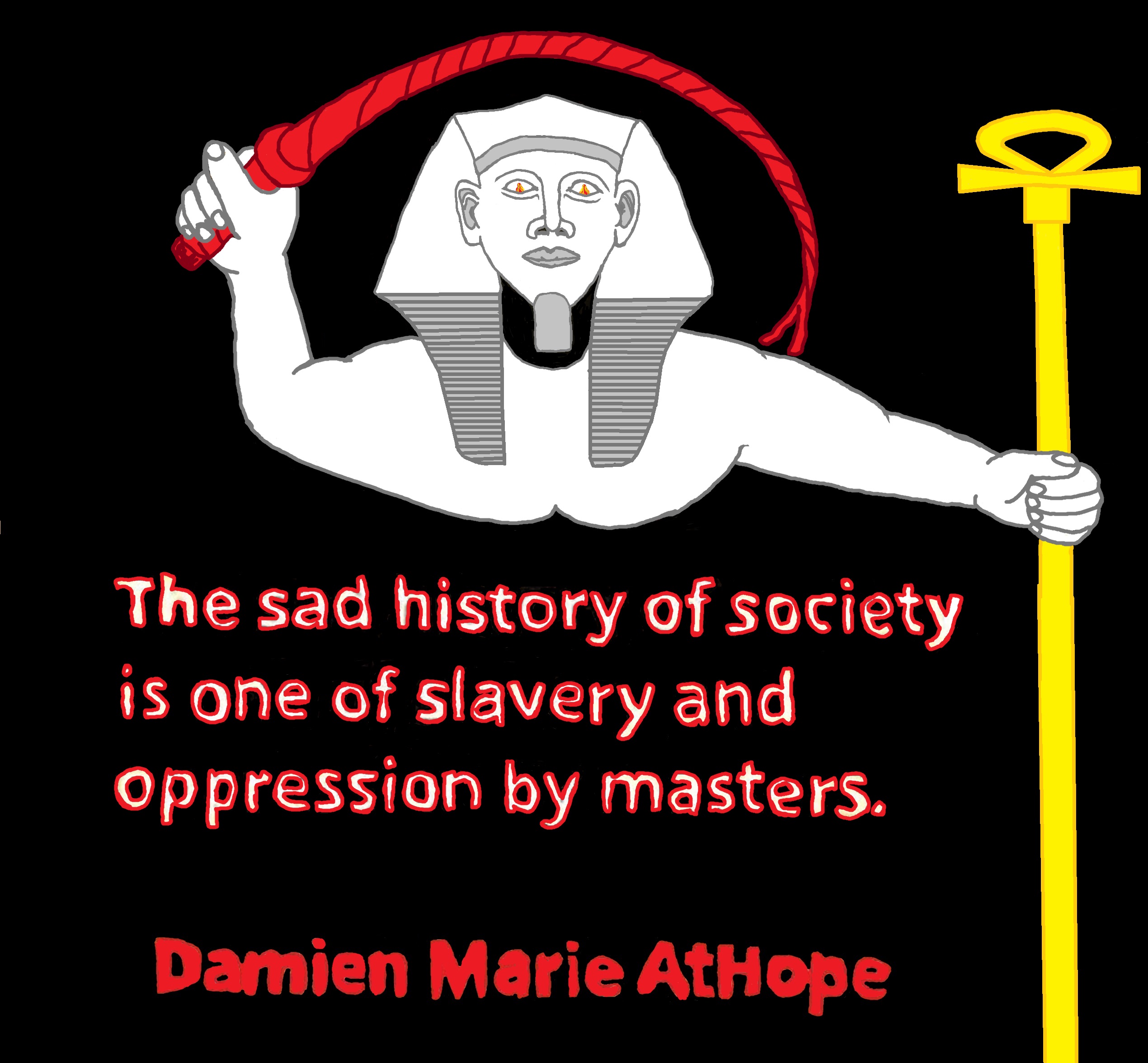
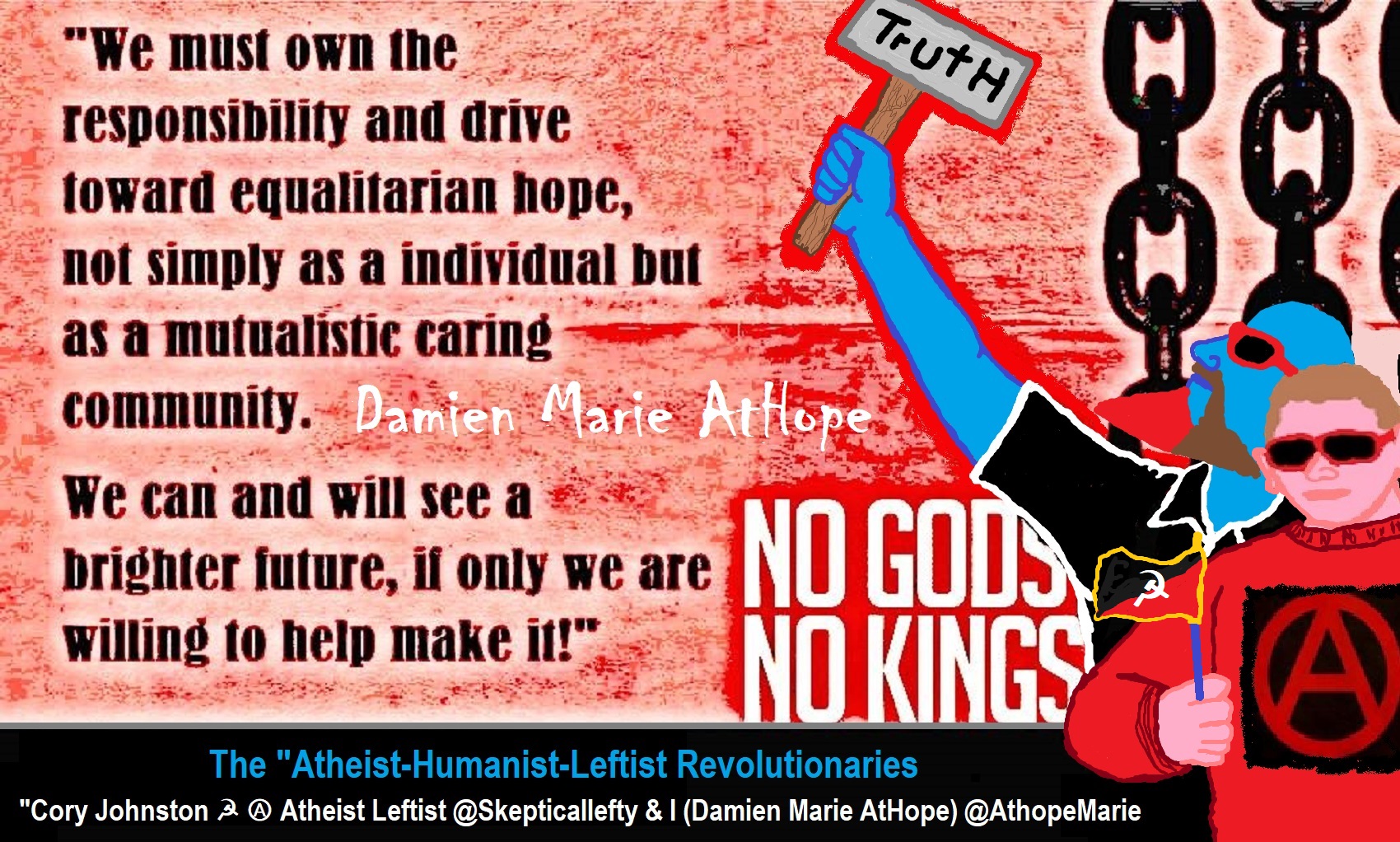
While hallucinogens are associated with shamanism, it is alcohol that is associated with paganism.
The Atheist-Humanist-Leftist Revolutionaries Shows in the prehistory series:
Show two: Pre-animism 300,000 years old and animism 100,000 years old: related to “Anarchism and Socialism”
Show tree: Totemism 50,000 years old: related to “Anarchism and Socialism”
Show four: Shamanism 30,000 years old: related to “Anarchism and Socialism”
Show five: Paganism 12,000 years old: related to “Anarchism and Socialism”
Show six: Emergence of hierarchy, sexism, slavery, and the new male god dominance: Paganism 7,000-5,000 years old: related to “Anarchism and Socialism” (Capitalism) (World War 0) Elite and their slaves!
Prehistory: related to “Anarchism and Socialism” the division of labor, power, rights, and recourses: VIDEO
Pre-animism 300,000 years old and animism 100,000 years old: related to “Anarchism and Socialism”: VIDEO
Totemism 50,000 years old: related to “Anarchism and Socialism”: VIDEO
Shamanism 30,000 years old: related to “Anarchism and Socialism”: VIDEO
Paganism 12,000 years old: related to “Anarchism and Socialism” (Pre-Capitalism): VIDEO
Paganism 7,000-5,000 years old: related to “Anarchism and Socialism” (Capitalism) (World War 0) Elite and their slaves: VIEDO
Paganism 5,000 years old: progressed organized religion and the state: related to “Anarchism and Socialism” (Kings and the Rise of the State): VIEDO
Paganism 4,000 years old: related to “Anarchism and Socialism” (First Moralistic gods, then the Origin time of Monotheism): VIEDO
I do not hate simply because I challenge and expose myths or lies any more than others being thought of as loving simply because of the protection and hiding from challenge their favored myths or lies.
The truth is best championed in the sunlight of challenge.
An archaeologist once said to me “Damien religion and culture are very different”
My response, So are you saying that was always that way, such as would you say Native Americans’ cultures are separate from their religions? And do you think it always was the way you believe?
I had said that religion was a cultural product. That is still how I see it and there are other archaeologists that think close to me as well. Gods too are the myths of cultures that did not understand science or the world around them, seeing magic/supernatural everywhere.
I personally think there is a goddess and not enough evidence to support a male god at Çatalhöyük but if there was both a male and female god and goddess then I know the kind of gods they were like Proto-Indo-European mythology.
This series idea was addressed in, Anarchist Teaching as Free Public Education or Free Education in the Public: VIDEO
Our 12 video series: Organized Oppression: Mesopotamian State Force and the Politics of power (9,000-4,000 years ago), is adapted from: The Complete and Concise History of the Sumerians and Early Bronze Age Mesopotamia (7000-2000 BC): https://www.youtube.com/watch?v=szFjxmY7jQA by “History with Cy“
Show #1: Mesopotamian State Force and the Politics of Power (Samarra, Halaf, Ubaid)
Show #2: Mesopotamian State Force and the Politics of Power
Show #3: Mesopotamian State Force and the Politics of Power (Uruk and the First Cities)
Show #4: Mesopotamian State Force and the Politics of Power (First Kings)
Show #5: Mesopotamian State Force and the Politics of Power (Early Dynastic Period)
Show #6: Mesopotamian State Force and the Politics of Power
Show #7: Mesopotamian State Force and the Politics of Power (Sargon and Akkadian Rule)
Show #9: Mesopotamian State Force and the Politics of Power (Gudea of Lagash and Utu-hegal)
Show #12: Mesopotamian State Force and the Politics of Power (Aftermath and Legacy of Sumer)
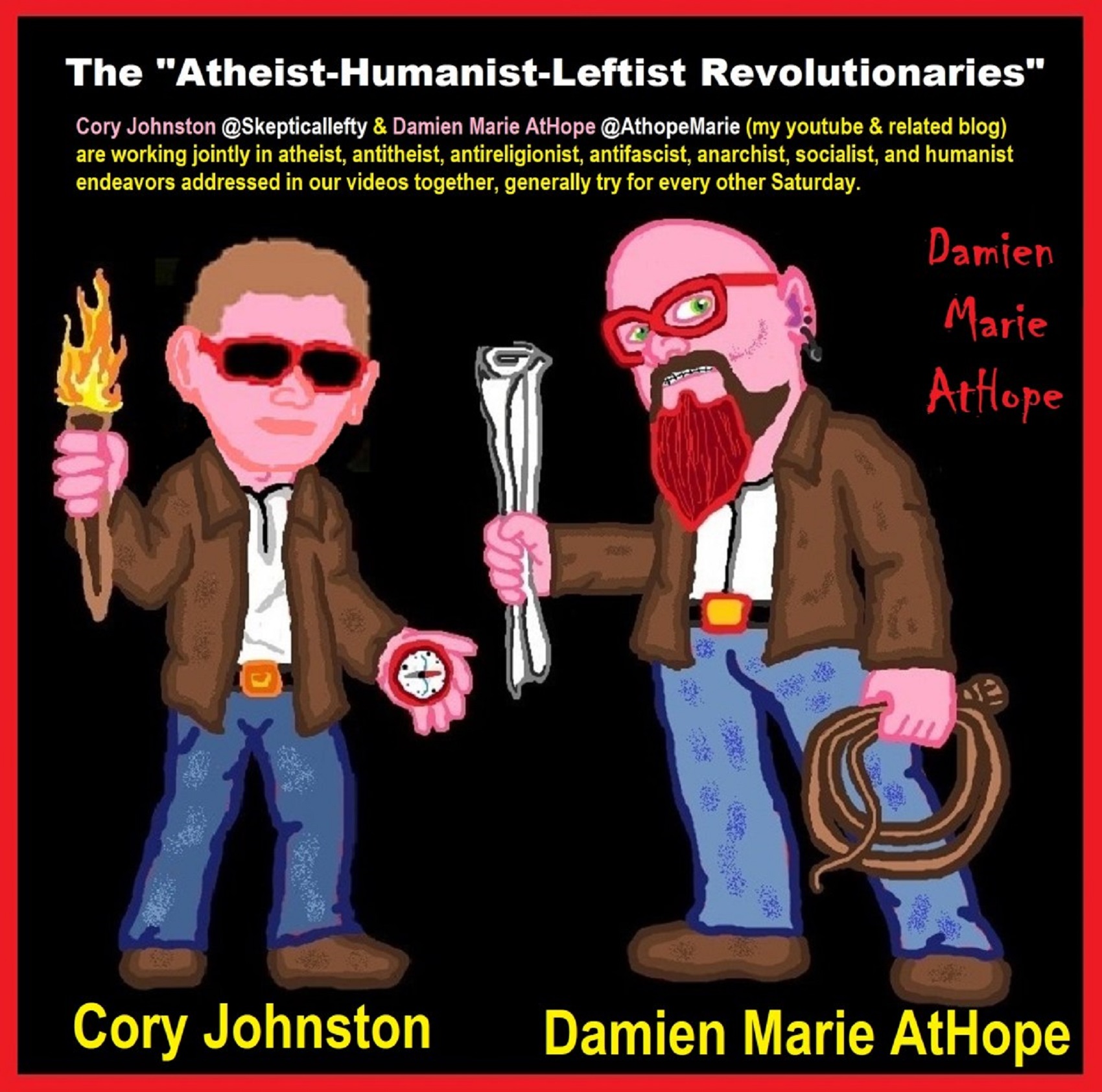
The “Atheist-Humanist-Leftist Revolutionaries”
Cory Johnston ☭ Ⓐ Atheist Leftist @Skepticallefty & I (Damien Marie AtHope) @AthopeMarie (my YouTube & related blog) are working jointly in atheist, antitheist, antireligionist, antifascist, anarchist, socialist, and humanist endeavors in our videos together, generally, every other Saturday.
Why Does Power Bring Responsibility?
Think, how often is it the powerless that start wars, oppress others, or commit genocide? So, I guess the question is to us all, to ask, how can power not carry responsibility in a humanity concept? I know I see the deep ethical responsibility that if there is power their must be a humanistic responsibility of ethical and empathic stewardship of that power. Will I be brave enough to be kind? Will I possess enough courage to be compassionate? Will my valor reach its height of empathy? I as everyone, earns our justified respect by our actions, that are good, ethical, just, protecting, and kind. Do I have enough self-respect to put my love for humanity’s flushing, over being brought down by some of its bad actors? May we all be the ones doing good actions in the world, to help human flourishing.
I create the world I want to live in, striving for flourishing. Which is not a place but a positive potential involvement and promotion; a life of humanist goal precision. To master oneself, also means mastering positive prosocial behaviors needed for human flourishing. I may have lost a god myth as an atheist, but I am happy to tell you, my friend, it is exactly because of that, leaving the mental terrorizer, god belief, that I truly regained my connected ethical as well as kind humanity.
Cory and I will talk about prehistory and theism, addressing the relevance to atheism, anarchism, and socialism.
At the same time as the rise of the male god, 7,000 years ago, there was also the very time there was the rise of violence, war, and clans to kingdoms, then empires, then states. It is all connected back to 7,000 years ago, and it moved across the world.
Cory Johnston: https://damienmarieathope.com/2021/04/cory-johnston-mind-of-a-skeptical-leftist/?v=32aec8db952d
The Mind of a Skeptical Leftist (YouTube)
Cory Johnston: Mind of a Skeptical Leftist @Skepticallefty
The Mind of a Skeptical Leftist By Cory Johnston: “Promoting critical thinking, social justice, and left-wing politics by covering current events and talking to a variety of people. Cory Johnston has been thoughtfully talking to people and attempting to promote critical thinking, social justice, and left-wing politics.” http://anchor.fm/skepticalleft
Cory needs our support. We rise by helping each other.
Cory Johnston ☭ Ⓐ @Skepticallefty Evidence-based atheist leftist (he/him) Producer, host, and co-host of 4 podcasts @skeptarchy @skpoliticspod and @AthopeMarie
Damien Marie AtHope (“At Hope”) Axiological Atheist, Anti-theist, Anti-religionist, Secular Humanist. Rationalist, Writer, Artist, Poet, Philosopher, Advocate, Activist, Psychology, and Armchair Archaeology/Anthropology/Historian.
Damien is interested in: Freedom, Liberty, Justice, Equality, Ethics, Humanism, Science, Atheism, Antiteism, Antireligionism, Ignosticism, Left-Libertarianism, Anarchism, Socialism, Mutualism, Axiology, Metaphysics, LGBTQI, Philosophy, Advocacy, Activism, Mental Health, Psychology, Archaeology, Social Work, Sexual Rights, Marriage Rights, Woman’s Rights, Gender Rights, Child Rights, Secular Rights, Race Equality, Ageism/Disability Equality, Etc. And a far-leftist, “Anarcho-Humanist.”
I am not a good fit in the atheist movement that is mostly pro-capitalist, I am anti-capitalist. Mostly pro-skeptic, I am a rationalist not valuing skepticism. Mostly pro-agnostic, I am anti-agnostic. Mostly limited to anti-Abrahamic religions, I am an anti-religionist.
To me, the “male god” seems to have either emerged or become prominent around 7,000 years ago, whereas the now favored monotheism “male god” is more like 4,000 years ago or so. To me, the “female goddess” seems to have either emerged or become prominent around 11,000-10,000 years ago or so, losing the majority of its once prominence around 2,000 years ago due largely to the now favored monotheism “male god” that grow in prominence after 4,000 years ago or so.
My Thought on the Evolution of Gods?
Animal protector deities from old totems/spirit animal beliefs come first to me, 13,000/12,000 years ago, then women as deities 11,000/10,000 years ago, then male gods around 7,000/8,000 years ago. Moralistic gods around 5,000/4,000 years ago, and monotheistic gods around 4,000/3,000 years ago.
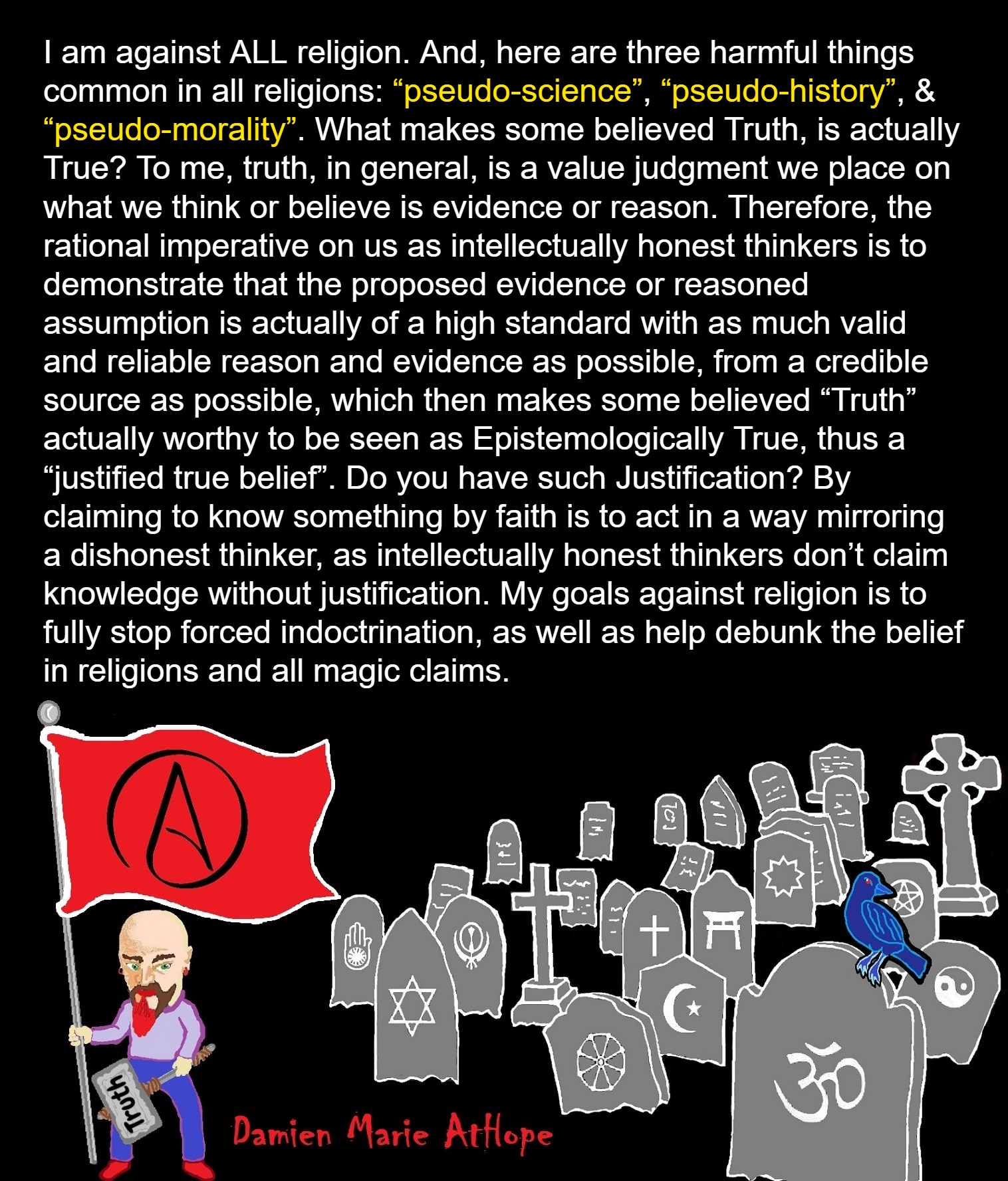
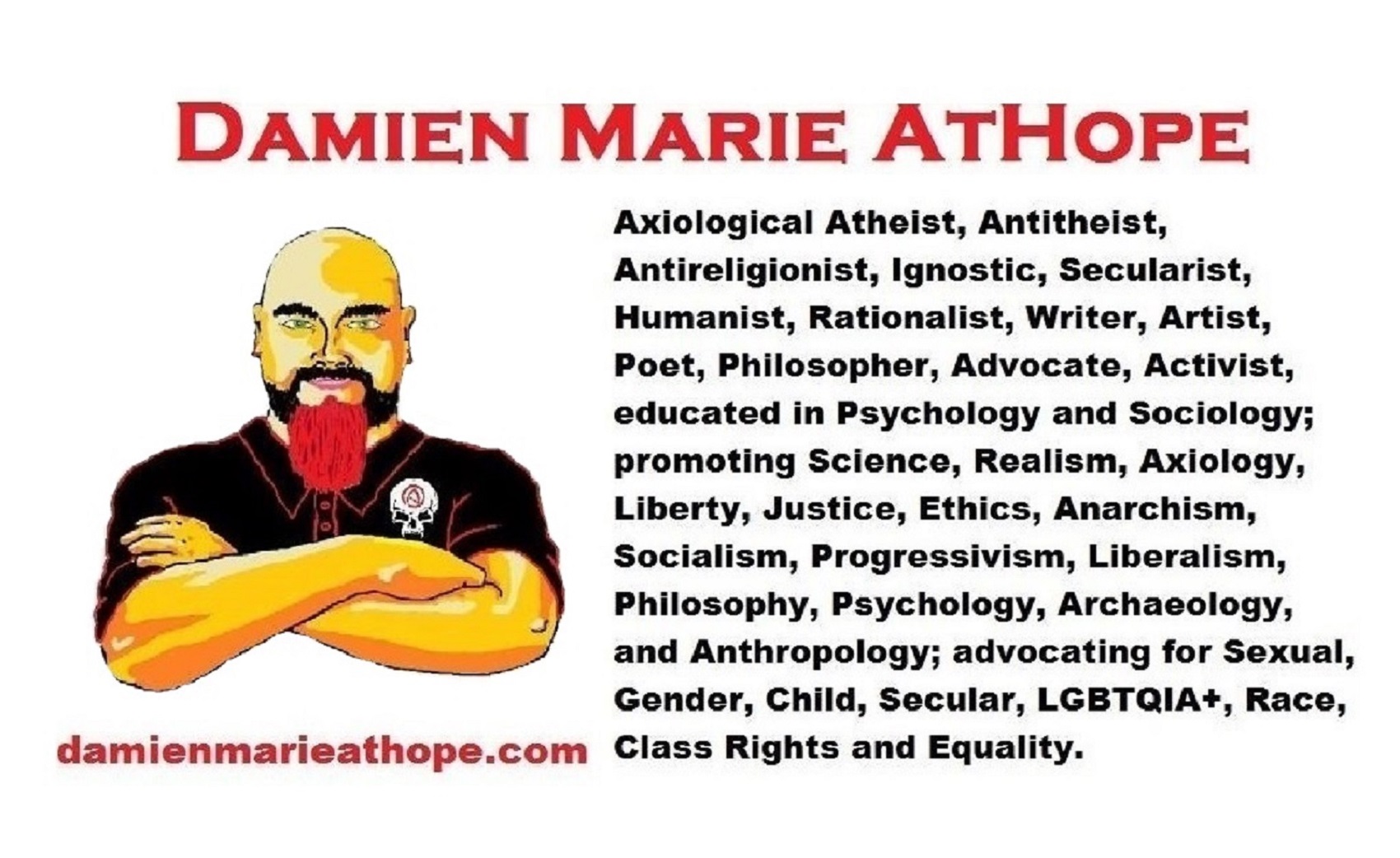
Damien Marie AtHope (Said as “At” “Hope”)/(Autodidact Polymath but not good at math):
Axiological Atheist, Anti-theist, Anti-religionist, Secular Humanist, Rationalist, Writer, Artist, Jeweler, Poet, “autodidact” Philosopher, schooled in Psychology, and “autodidact” Armchair Archaeology/Anthropology/Pre-Historian (Knowledgeable in the range of: 1 million to 5,000/4,000 years ago). I am an anarchist socialist politically. Reasons for or Types of Atheism
My Website, My Blog, & Short-writing or Quotes, My YouTube, Twitter: @AthopeMarie, and My Email: damien.marie.athope@gmail.com
